The rattling of trams woke us up this morning from, for my part, the worst night sleep I have had in a long time. Not even the Valium helped. I think the bed was broken – it had no support under it and it was sloping to the side somewhat, every time I rolled over, (which was often because I felt like I was constantly going to fall out of bed) something creaked and clunked under the bed frame. So yay, welcome to another busy day and this time with about four hours sleep. 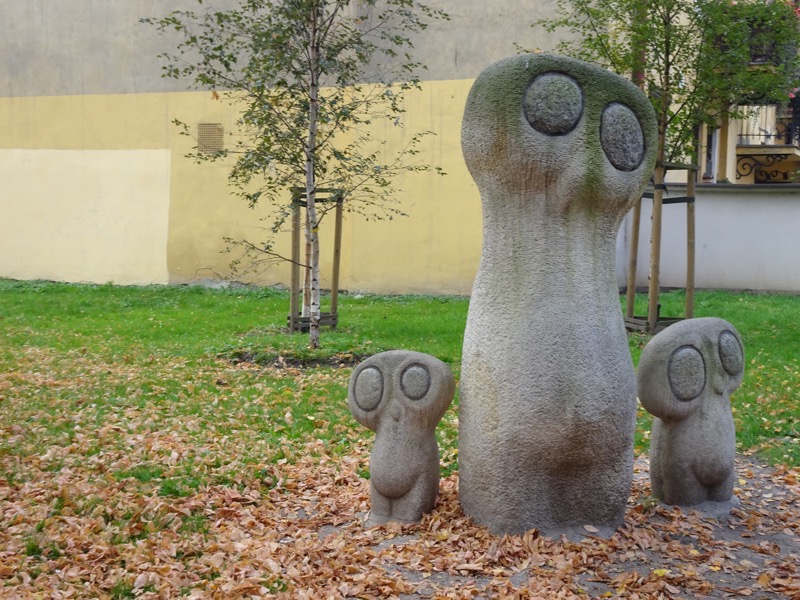 Walking up to Wawel Castle…
Walking up to Wawel Castle… We were planning on visiting the historic district of Wawel Castle just for the morning. It is located pretty much in the centre of Kraków and was built by King Kazimierz III, also known as Casimir III the Great, in the 13th and 14th centuries. The castle is actually a large complex made up of a number of Medieval/Renaissance/ Baroque buildings around a very large Italian style courtyard making it one of the largest in Poland. Most of the Wawel Royal Castle and the Wawel Hill area are considered the most culturally/historically significant areas in the entire country. Sometimes I feel like I am travelling the world ticking off UNESCO World Heritage Sites, as this is another one of them
We were planning on visiting the historic district of Wawel Castle just for the morning. It is located pretty much in the centre of Kraków and was built by King Kazimierz III, also known as Casimir III the Great, in the 13th and 14th centuries. The castle is actually a large complex made up of a number of Medieval/Renaissance/ Baroque buildings around a very large Italian style courtyard making it one of the largest in Poland. Most of the Wawel Royal Castle and the Wawel Hill area are considered the most culturally/historically significant areas in the entire country. Sometimes I feel like I am travelling the world ticking off UNESCO World Heritage Sites, as this is another one of them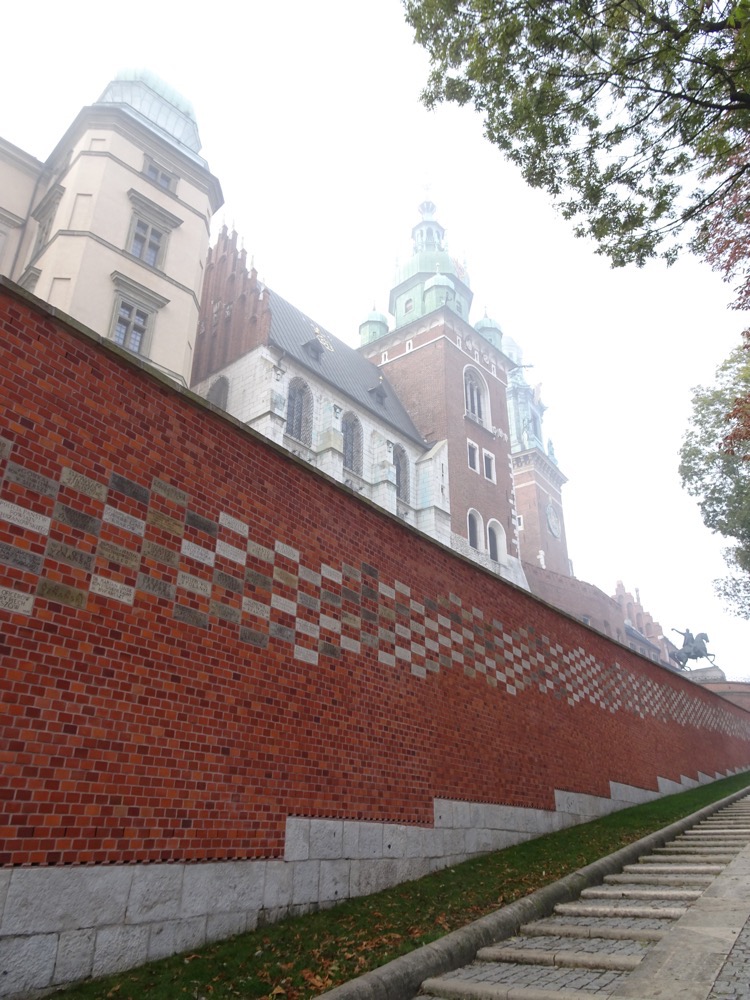
 Buying tickets proved quite the experience. There was a (thankfully, short) queue of about 20 people waiting to buy tickets to enter the caste. We couldn’t figure out why the line was moving so slowly. Turns out you don’t just buy a ticket to the Castle and wander on it following a structured flow through the museum, but rather you choose which sections of the castle you wish to see and then are told when you can go see them.
Buying tickets proved quite the experience. There was a (thankfully, short) queue of about 20 people waiting to buy tickets to enter the caste. We couldn’t figure out why the line was moving so slowly. Turns out you don’t just buy a ticket to the Castle and wander on it following a structured flow through the museum, but rather you choose which sections of the castle you wish to see and then are told when you can go see them.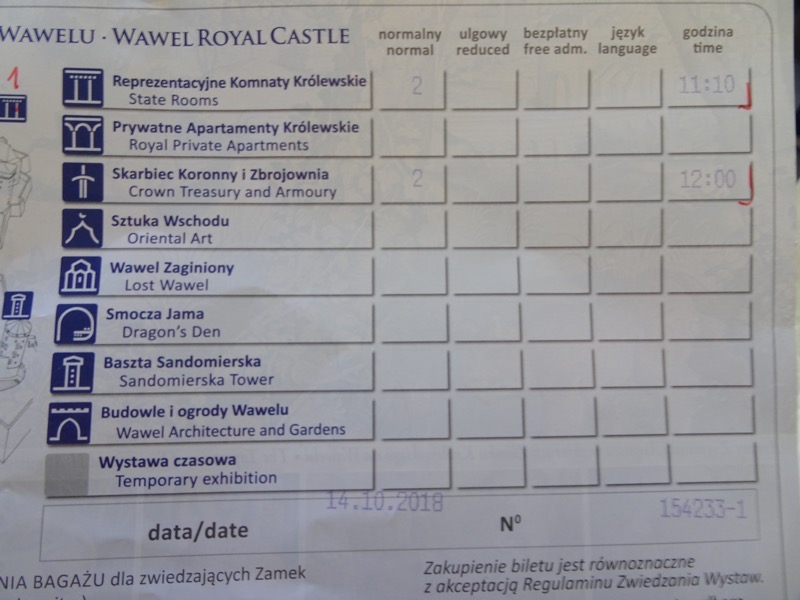 So we arrive around 10:00, go wait in line for a rather complex ticketing system and find ourselves unable to enter anywhere for another 20 minutes. :/ I understand the concept is probably about crowd control during the busiest of summer periods but none of this information is easily available online (it is once you know to look for it), and you can’t buy tickets in advance, and of course, there is only one person serving all the somewhat confused visitors. We were told if we wanted to visit the Royal Apartments we wouldn’t get an entry time until 14:00, and once inside we saw plenty of people loitering around the courtyard waiting for their appointed times to go in.
So we arrive around 10:00, go wait in line for a rather complex ticketing system and find ourselves unable to enter anywhere for another 20 minutes. :/ I understand the concept is probably about crowd control during the busiest of summer periods but none of this information is easily available online (it is once you know to look for it), and you can’t buy tickets in advance, and of course, there is only one person serving all the somewhat confused visitors. We were told if we wanted to visit the Royal Apartments we wouldn’t get an entry time until 14:00, and once inside we saw plenty of people loitering around the courtyard waiting for their appointed times to go in.
The city was very foggy when we left the hotel this morning, but it was going to be a lovely day. Side entrance to the cathedral part of the complex.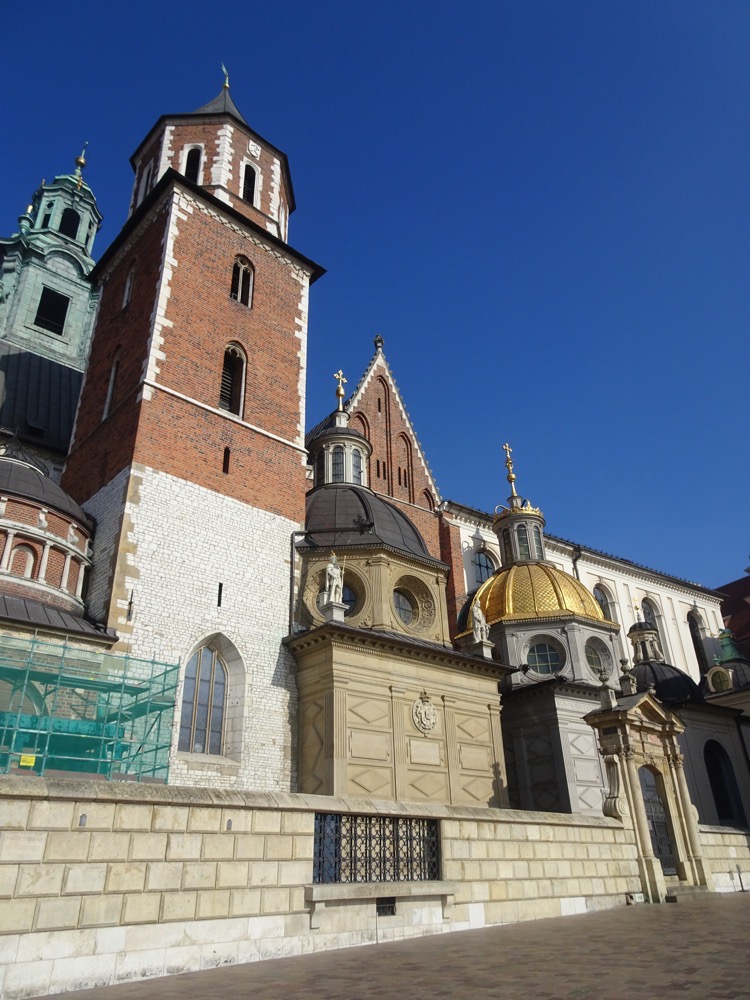 Forecourt:
Forecourt: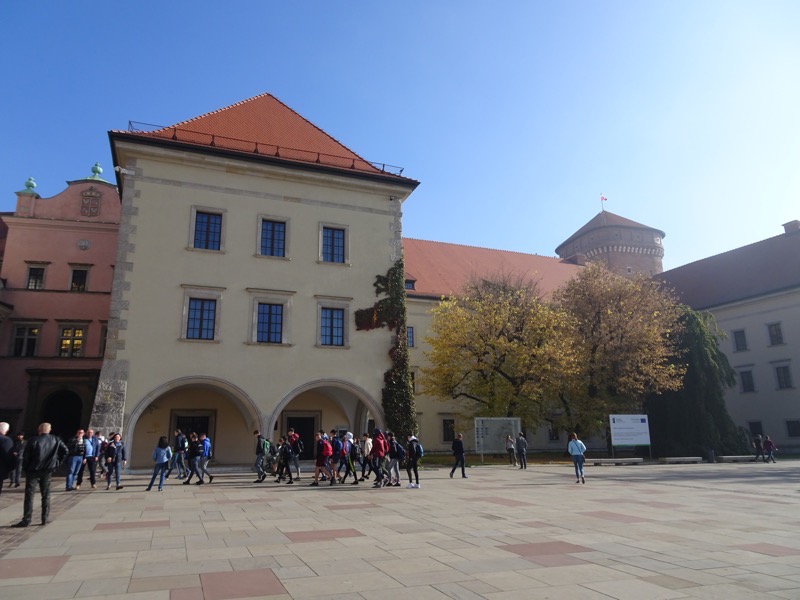
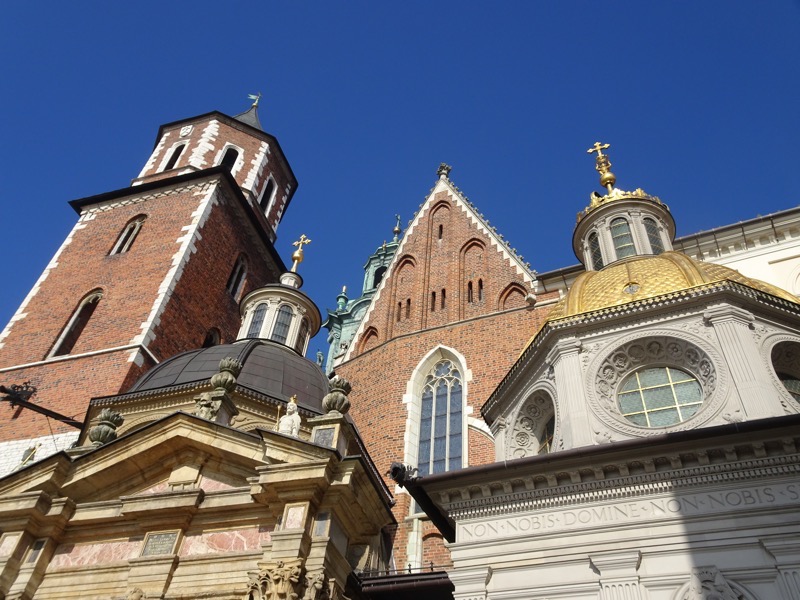
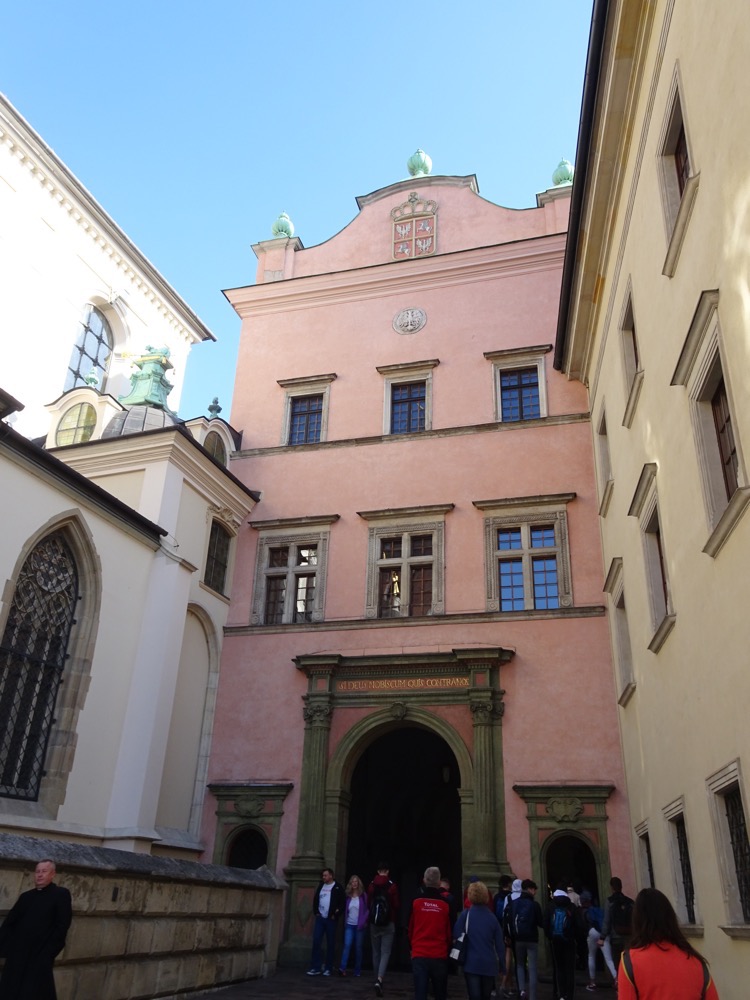 Main courtyard.
Main courtyard. And that, my friends, is pretty much the limit of the photos I was able to take at Wawel Castle. The castle contains an important collection of Renaissance art, some Ghirlandaio, Cranach, at least two Rubens, a Tintoretto, Tiepolo, and a few Dossi among others; lots of famous pieces, but NO PHOTOGRAPHY was allowed:
And that, my friends, is pretty much the limit of the photos I was able to take at Wawel Castle. The castle contains an important collection of Renaissance art, some Ghirlandaio, Cranach, at least two Rubens, a Tintoretto, Tiepolo, and a few Dossi among others; lots of famous pieces, but NO PHOTOGRAPHY was allowed:
https://en.wikipedia.org/wiki/File:Domenico_Ghirlandaio_008.jpg
https://en.wikipedia.org/wiki/File:Cranach_the_Elder_Christ_blessing_the_children.jpg
https://en.wikipedia.org/wiki/File:Rubens_W%C5%82adys%C5%82aw_Vasa_(detail).jpg
https://en.wikipedia.org/wiki/File:Giovanni_Battista_Tiepolo_097.jpg
The castle also contains a famous collection of Gobelin tapestries known as the Sigismund II Augustus tapestry collection, a collection of Crown jewels and coronation pieces, a very impressive armoury and many period household furnishings – chairs, trunks, tables, light fittings, fireplaces, and smaller domestic items like jugs, plates, bowls etc. It is a huge loss not to be able to photograph these things, as they never appear in catalogues or books.
The armoury, in particular, was extremely frustrating, there was an enormous collection of polearms, swords, crossbows, early firearms and daggers – and NONE of it was well marked. Honestly, they had a wall of about 30 daggers with a tag that read something like “Daggers from Austria, Germany, Italy, France, and Spain; 14th to 16th century”. I could take a stab at the provenance of some of them, but it was really annoying to know each of these artefacts have a unique origin and history, but the primary goal of the curators of the museum seems not to be one of education, but of traffic flow. Most of the rooms we accessed were of a similarly poorly labelled – you enter an enormous chamber, surrounded by tapestries, paintings, obviously period furniture items, there is one small A3 plaque with six people huddled around it trying to figure out which item is which using the shoddily numbered diagram, with very little information. Honestly, whoever set this place up cares not a whit for educating those that visit.
We walked out after having seen some of the most wonderful objects, with no photos to share with other medieval enthusiasts back home, and zero information on what we had been looking at. We hightailed it to the two bookshops and found only the most basic of touristy guidebooks – you know the one, it is basically the Wikipedia page of the castle in print form. So disappointed. I asked one of the staff members if there was a book on the armoury, and he didn’t even know if there was one. We eventually found a very weighty academic 300-page tome solely addressing polearms, but not just ones in the Wawel Castle collection, when I was really interested in the crossbows and early firearms.
If you are going to prohibit guests from taking photographs, then for crying out loud sell decent guidebooks to the various exhibits. It’s just such a let down to travel halfway around the world to see these magnificent things and not to be able to recall them or share them. Particularly from a research and education standpoint. This must be one of the most frustrating and disappointing museum visits I have ever encountered.
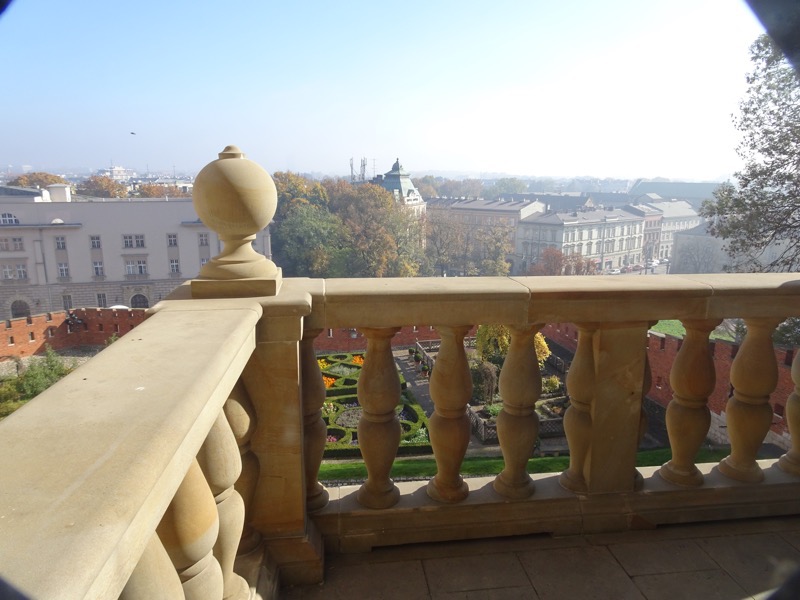
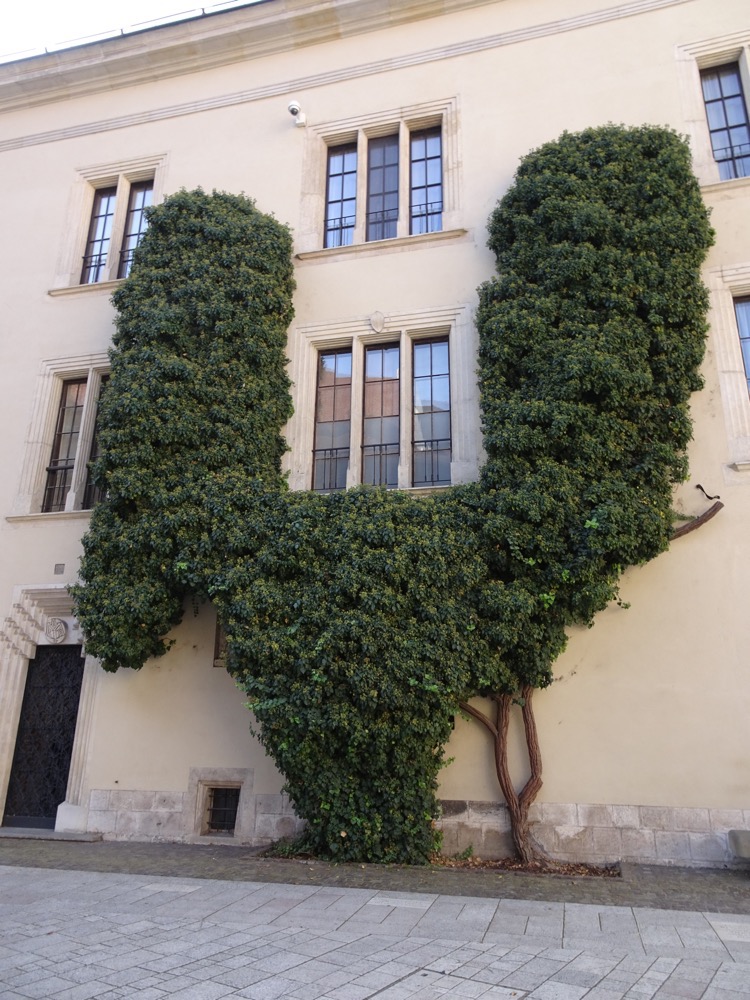 On more than one occasion we saw small groups entering rooms that we weren’t allowed to enter because they were on an organised tour. Museums should not be like this. It is a cluster. My advice for anyone planning on attending Wawel Castle is to set aside the entire day for it so you can visit on their scheduled time slots. I would probably also use a private tour operator to access the ‘non-public’ spaces… and I’d probably anticipate a disappointing visit anyway due to photography not being allowed, and the lack of decent books to make up for the whole photography is not allowed thing. :/
On more than one occasion we saw small groups entering rooms that we weren’t allowed to enter because they were on an organised tour. Museums should not be like this. It is a cluster. My advice for anyone planning on attending Wawel Castle is to set aside the entire day for it so you can visit on their scheduled time slots. I would probably also use a private tour operator to access the ‘non-public’ spaces… and I’d probably anticipate a disappointing visit anyway due to photography not being allowed, and the lack of decent books to make up for the whole photography is not allowed thing. :/ 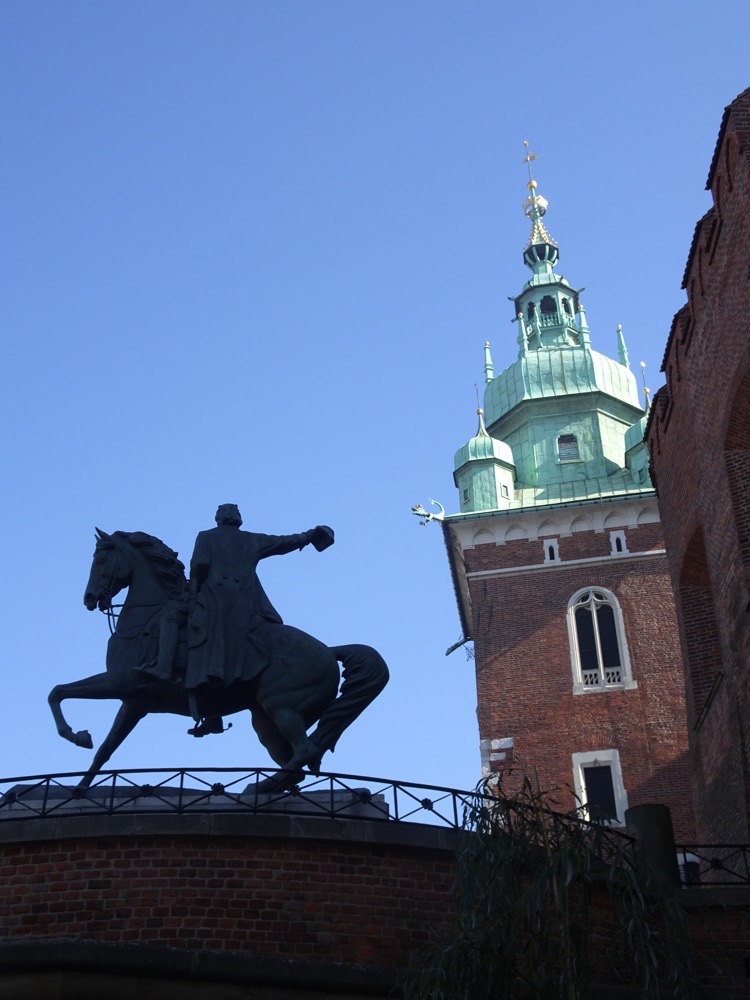
After grabbing a quick and dirty roadside bite to eat we head out to the countryside about an hour south of Krakow to Oświęcim to visit the Auschwitz-Birkenau museums and memorials. I have based a lot of the following text on information boards that were dotted around the complex. I have found it hard to find my own words to express what happened here, and how it makes you feel as you progress through this very important historical site. So I have paraphrased a lot of the more thoughtful words that have been placed before us for our introspection as we visited.
 Throughout the world, Auschwitz has become a symbol of terror, genocide and the Holocaust. The German forces occupying Poland during the Second World War established a concentration camp on the outskirts of the town of Oświęcim in 1940. The Germans called the town, ‘Auschwitz’ and that is the name by which the camp was known. Over the next years it was expanded into three main camps: Auschwitz I, Auschwitz II- Birkenau and Auschwitz III- Planowitz with more than 40 subcamps in the area. The first people to be brought to Auschwitz as prisoners and murdered here were Poles. They were soon followed by Soviet prisoners of war, Gypsies, and deportees from other nationalities. Beginning in 1942, however, Auschwitz became the setting of the most massive murder campaign in history, when the Nazis put into operation their plan to destroy the entire Jewish population of Europe. The great majority of Jews who were deported to Auschwitz – men, women and children – were sent immediately upon arrival to deal in the gas chambers of Birkenau.
Throughout the world, Auschwitz has become a symbol of terror, genocide and the Holocaust. The German forces occupying Poland during the Second World War established a concentration camp on the outskirts of the town of Oświęcim in 1940. The Germans called the town, ‘Auschwitz’ and that is the name by which the camp was known. Over the next years it was expanded into three main camps: Auschwitz I, Auschwitz II- Birkenau and Auschwitz III- Planowitz with more than 40 subcamps in the area. The first people to be brought to Auschwitz as prisoners and murdered here were Poles. They were soon followed by Soviet prisoners of war, Gypsies, and deportees from other nationalities. Beginning in 1942, however, Auschwitz became the setting of the most massive murder campaign in history, when the Nazis put into operation their plan to destroy the entire Jewish population of Europe. The great majority of Jews who were deported to Auschwitz – men, women and children – were sent immediately upon arrival to deal in the gas chambers of Birkenau.
When the SS realized that the end of the war was near, they attempted to remove the evidence of the atrocities committed here. They dismantled the gas chambers, crematoria, and other buildings, burned documents and evacuation all those prisoners who could walk to the interior of Germany. Those who were not evacuated were liberated by the Red Army on January 27, 1945.
On July 2, 1974, the Polish Parliament established the State Museum of Oświęcim – Brezinka on the sites of the former camps at Auschwitz I and Auschwitz II-Birkenau. In 1979, these camps were formally recognized by UNESCO by their inclusion on the World Heritage List.
In the years 1940 – 1941 German occupants expelled the Polish inhabitants of the following villages: Brzezinka, Harmęże, Pławy, Bór, Rajsko, Klucnikowice, Babice Broszkowice and from Zasole District of Oświęcim. They took this land and founded the death camp Auschwitz-Birkenau. The camp’s economic and industrial base is on the site of the demolished or taken buildings from those villages.
Auschwitz was the largest Nazi German Concentration Camp and Death Camp. In the years 1940 – 1945, the Nazis deported at least 1,300,000 people to Auschwitz:
1,100,000 Jews
140,000 – 150,000 Poles
23,000 Roma (Gypsies)
15,000 Soviet Prisoners of War
25,000 Prisoners from other ethnic groups.
1,100,000 of these people died in Auschwitz, approximately 90% of the victims were Jews. The SS murdered the majority of these people in the gas chambers.
Model of the massive L-Shaped gas chamber and crematoria complex located at Auschwitz-Birkenau. 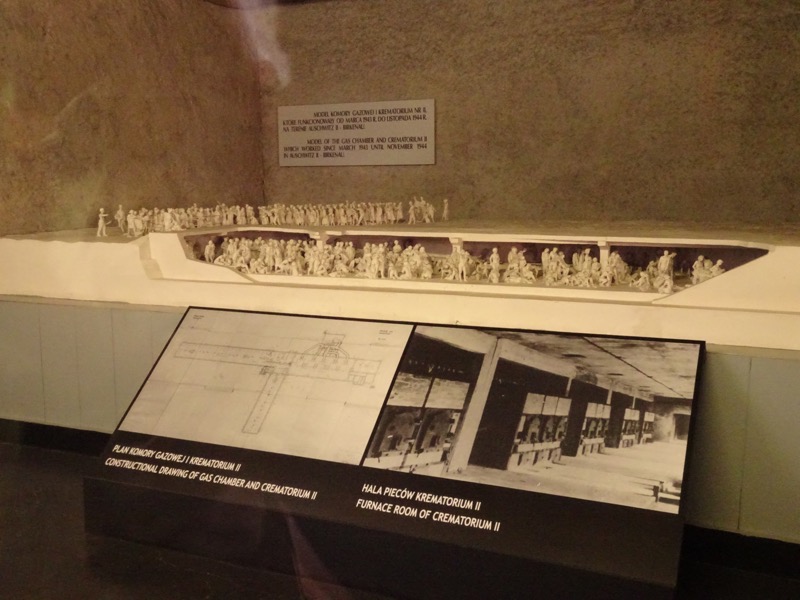
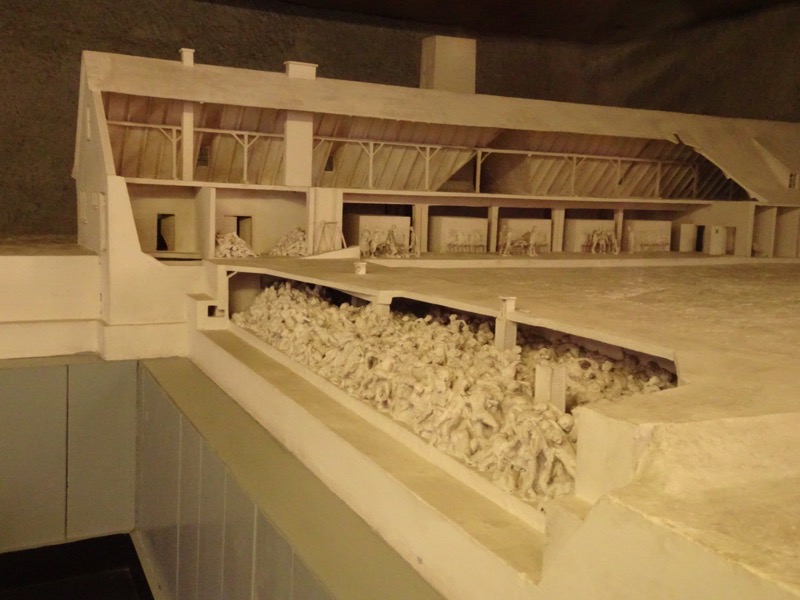
Transports of Jews deported to Auschwitz would arrive at a specially constructed railway ramp at Birkenau. The ramp was obscured from the camp so that prisoners could not see arriving deportees and deportees could not see the state of the prisoners. At this unloading ramp, women and children were immediately separated from men. Subsequently, SS doctors would carry out an extremely perfunctory ‘selection’. Those who were considered fit for work were directed to the work camp to be registered as prisoners. This amounted to approximately 25 per cent of the arrivals. The remainder were led directly to the gas chambers. In order to avoid panic spreading, people condemned to death were assured that they were going to take a shower after their train travel for disinfection purposes. Sometimes entire trainloads of deportees were directed straight to the gas chambers without any selections taking place.
A map covering part of the Auschwitz-Birkenau concentration camp and death camp. The yellow area is a series of warehouses known as ‘Kanada’ in Auschwitz II-Birkenau, the red area is the ‘Kanada’ of the Auschwitz KL camp (I will come back to them later). 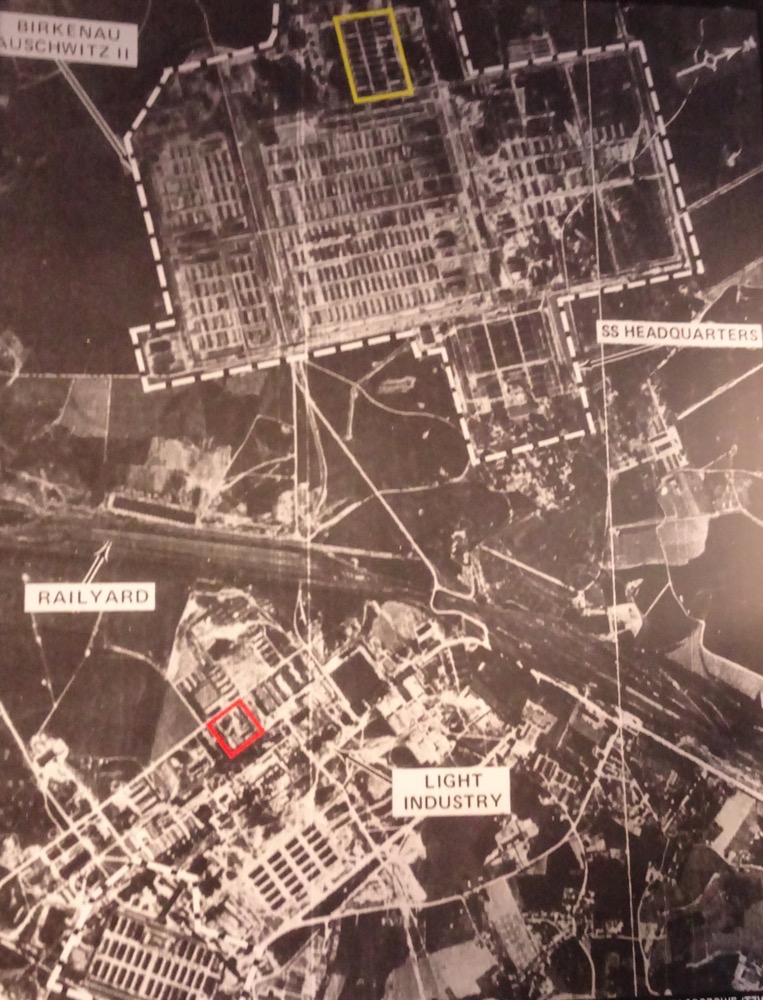 After the selection process on the railway platform, those who were going to be murdered in the gas chambers were assured that they were going to take a shower. They were divided from their belongings and made to strip naked. Fake showerheads were fixed to the ceiling of the gas chambers.
After the selection process on the railway platform, those who were going to be murdered in the gas chambers were assured that they were going to take a shower. They were divided from their belongings and made to strip naked. Fake showerheads were fixed to the ceiling of the gas chambers.
Beaten and intimidated by SS dogs, 2,000 victims were crammed into the underground chamber, an area of approximately 210M2. The chamber door would be locked and Zyklon B was poured into the chamber from holes in the ceiling. The bodies were then stripped of gold teeth and jewellery as war spoils for the Reich, their hair was cut off and sold to PKR textiles manufacturer to be made into bedding, clothing etc, then the bodies were burnt in the crematorium. All the victims’ personal documents were destroyed, effectively erasing all evidence of that person having been executed there.
In Barracks numbered 5 – 10, contains items relating to the atrocities committed on this site by the Nazis. They have been assembled to demonstrate to visitors the extent of the mass extermination of the predominantly Jewish prisoners at the camp.
Zyklon B canisters found on site after liberation: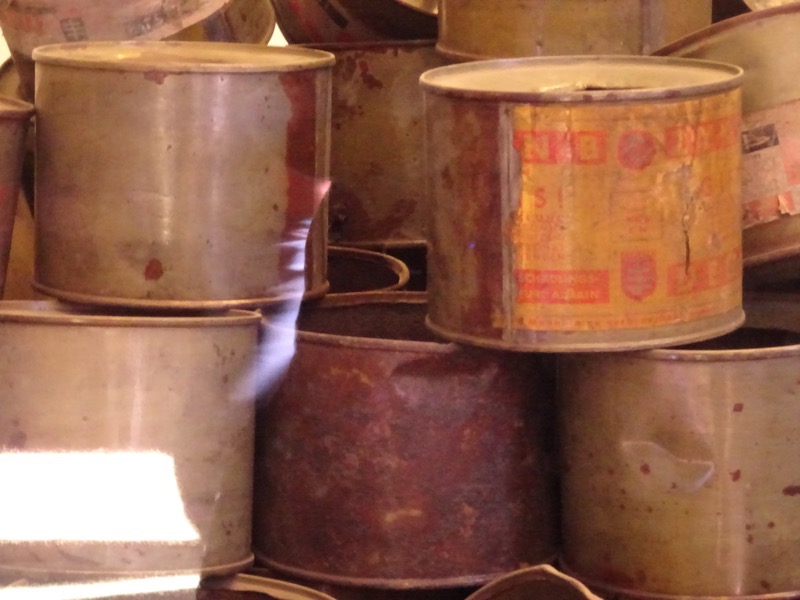
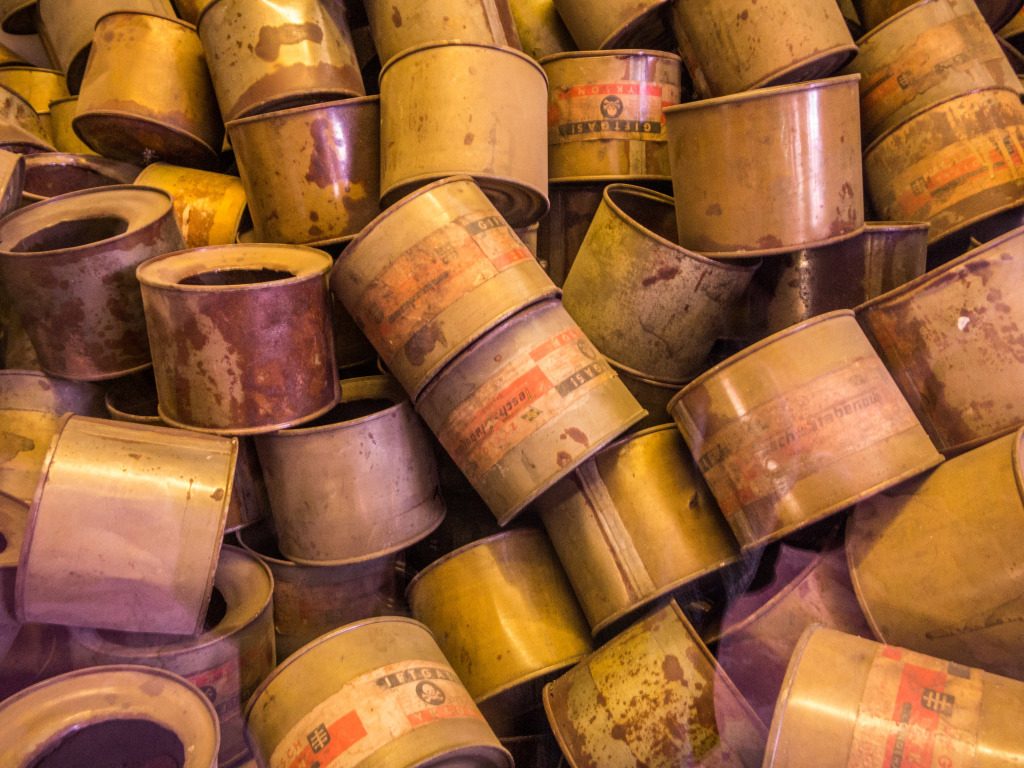 Piles of spectacles removed from deportees who were murdered in the gas chambers.
Piles of spectacles removed from deportees who were murdered in the gas chambers.
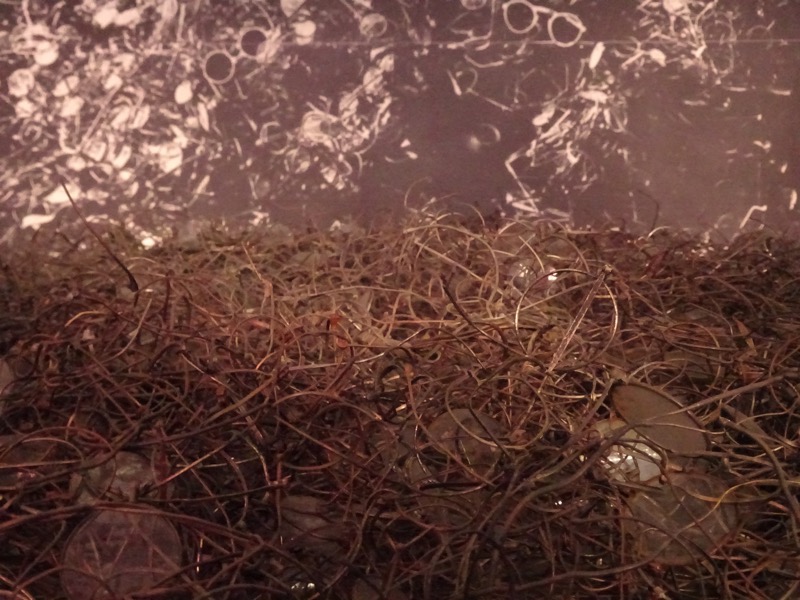
Timeline:
June 1940 – Beginning of the deportation of Poles, the Nazis sent 140,000 – 150,000 Polish prisoners to the camp, where half of them perished.
June 1941 – Beginning of deportations of 25,000 prisoners of various nationalities, about half of these prisoners perished in the camp.
Summer 1941 – Beginning of deportations of 15,000 Soviet POWs. Most died during their imprisonment. Only a few survived.
March 1942 – Beginning of deportations of 1.1million Jews. Auschwitz started fulfilling two functions; whilst remaining a concentration camp, it became yet another site of the Holocaust, the biggest mass murder in the history of mankind, perpetrated by the Nazis. About one million deported Jews, were murdered by the SS, mainly in gas chambers.
February 1943 – Beginning of deportations of 23,000 Roma (Gypsies), of this number, 21,000 perished.
One thing these disparate groups had in common was that any disabled people who arrived at the camp would be immediately set to the death chambers. They were identified during the selection process and never registered as prisoners.

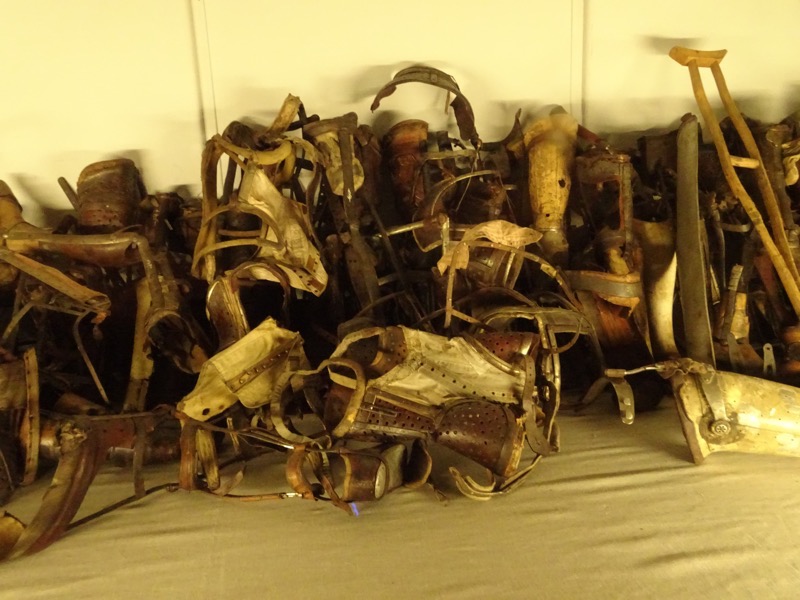 People arriving at the camps had many personal belongings with them that were taken and sorted, including household goods and kitchen items:
People arriving at the camps had many personal belongings with them that were taken and sorted, including household goods and kitchen items:
 Piles of suitcases each one once carrying the entire worldly goods of a deportee:
Piles of suitcases each one once carrying the entire worldly goods of a deportee: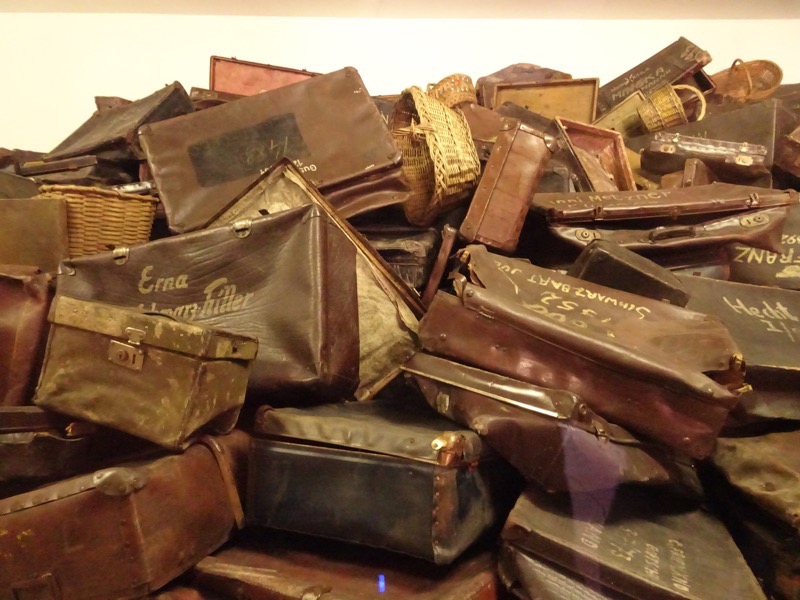
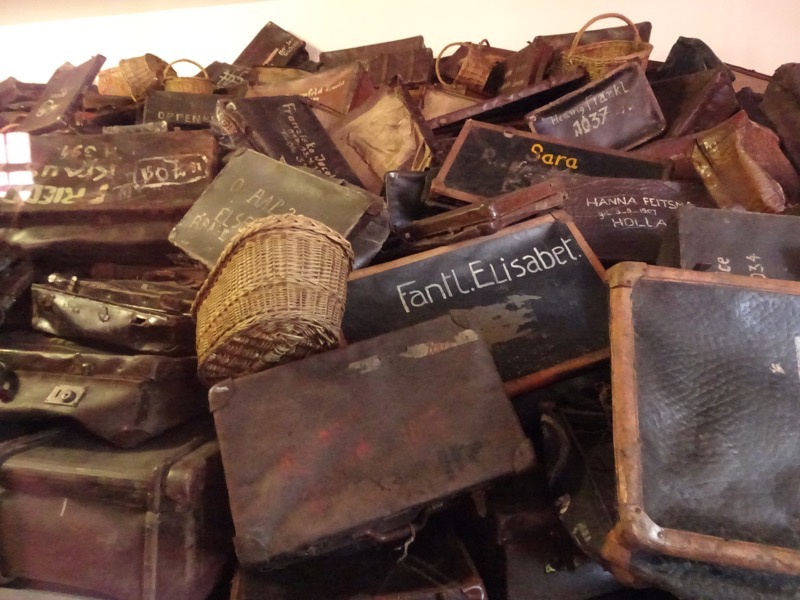 Mountains of shoes taken from the dead or about to be killed:
Mountains of shoes taken from the dead or about to be killed:
 The shoes of children who were murdered at the camps:
The shoes of children who were murdered at the camps:
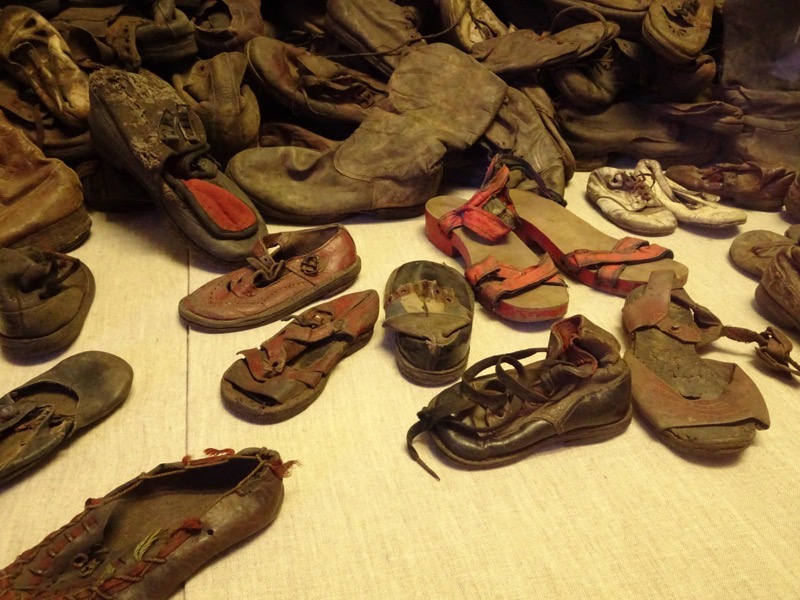 Personal brushes and shaving brushes:
Personal brushes and shaving brushes: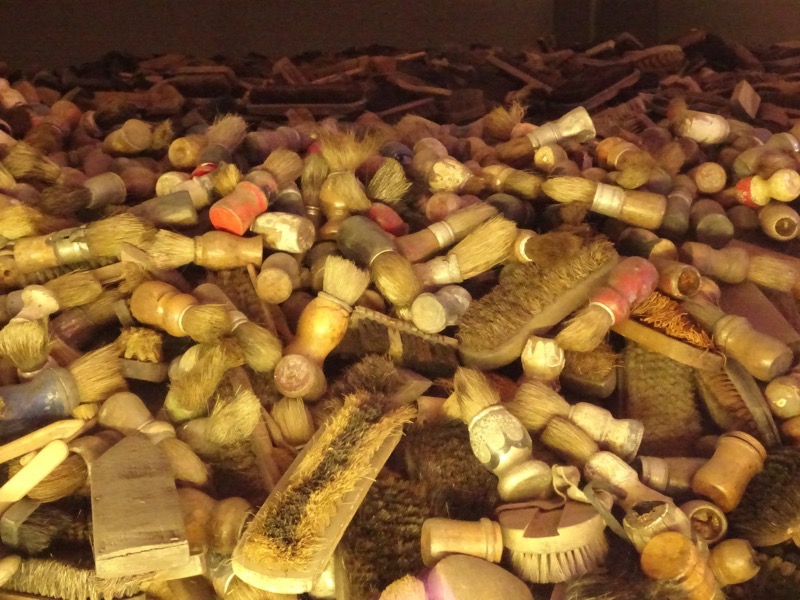
When the camp was first administered, every prisoner who arrived at Auschwitz would have an identification number given to them and a card made with three photographs of the individual for identification. This photography system proved time-consuming and expensive and as many prisoners did not survive the camp long enough to justify the process. KL Auschwitz was the only Nazi camp where prisoners had their camp numbers tattooed onto their person – on their left arm, though some smaller children had numbers tattooed onto their legs. The tattooing saved money due to the right mortality rate and assisted with difficulties in identifying corpses. From Autumn 1941 Soviet prisoners of war as well as other groups, were tattooed also. From Spring 1943, tattooing for identification was used to mark all prisoners.
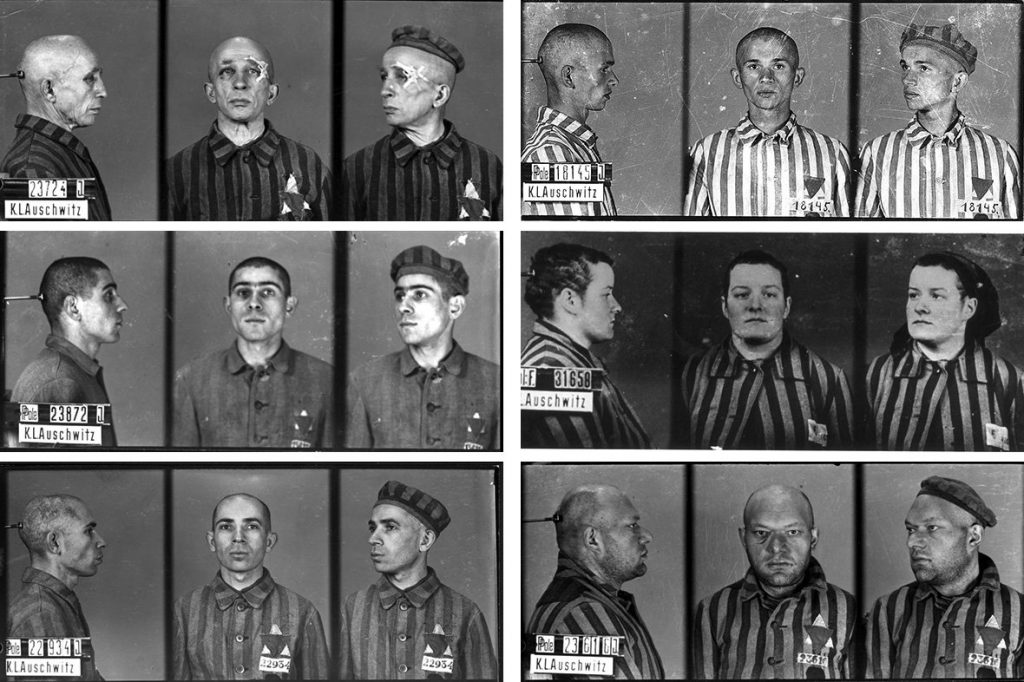 Camp uniforms were issued to prisoners who made it through the selection process to become registered prisoner/workers. They were often filthy and lice-ridden.
Camp uniforms were issued to prisoners who made it through the selection process to become registered prisoner/workers. They were often filthy and lice-ridden.
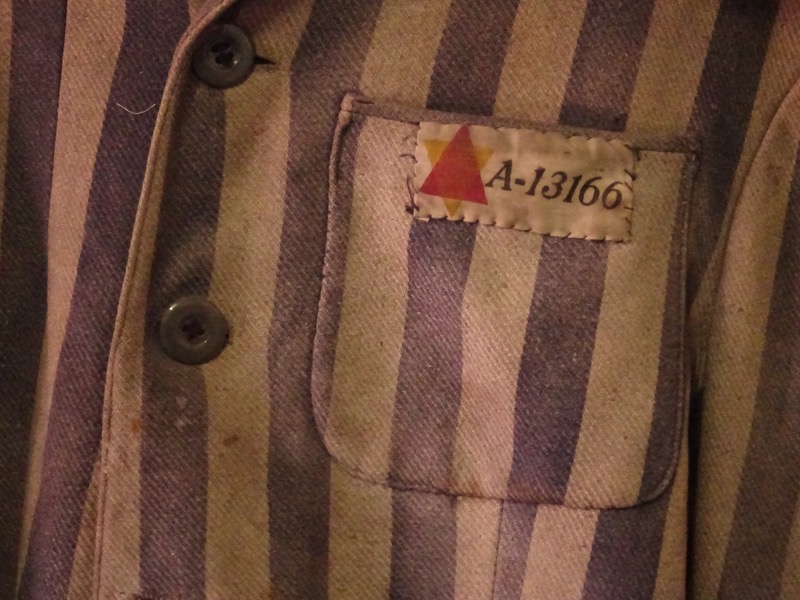 Each of these people had a family, an occupation, a home. Here, they were dehumanized and turned into a number only.
Each of these people had a family, an occupation, a home. Here, they were dehumanized and turned into a number only. 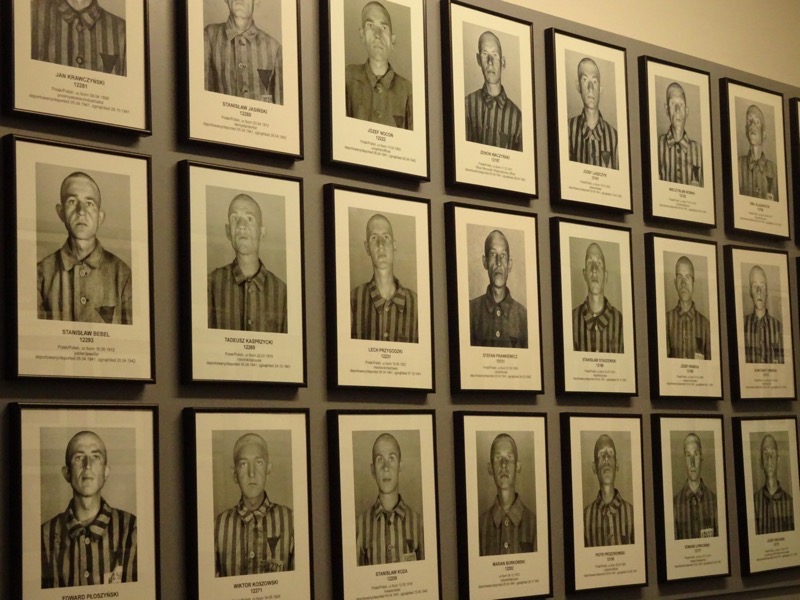
the windows of the barracks were the constant reminders of the failure to comply with orders. Barbed wire fences, guard towers and the ever-present threat of violence and death.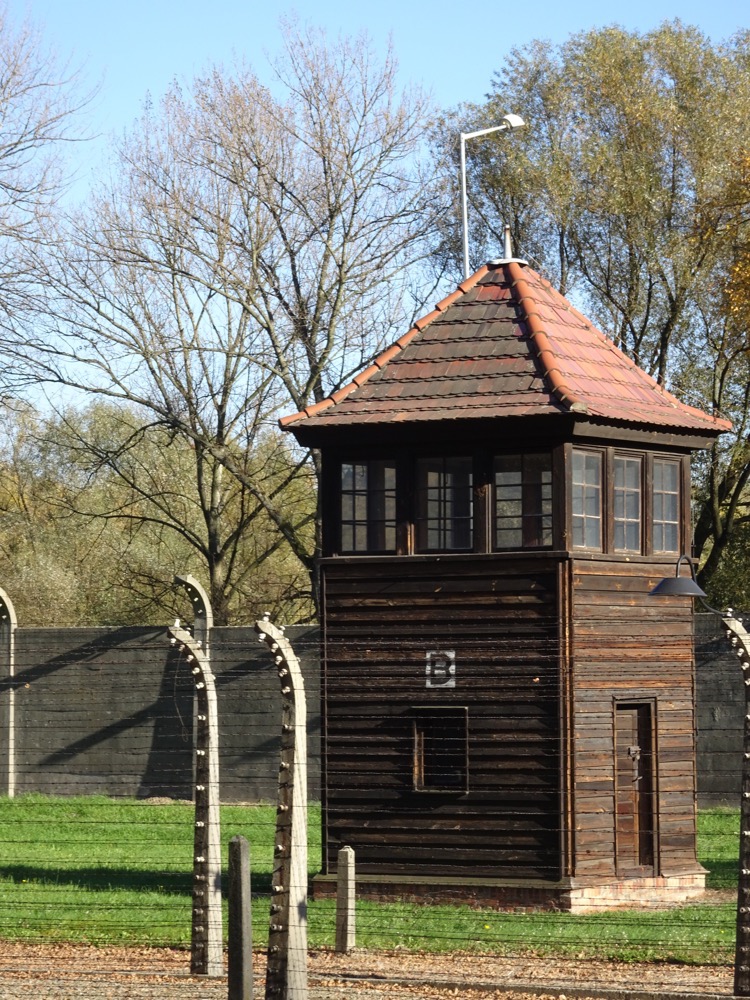
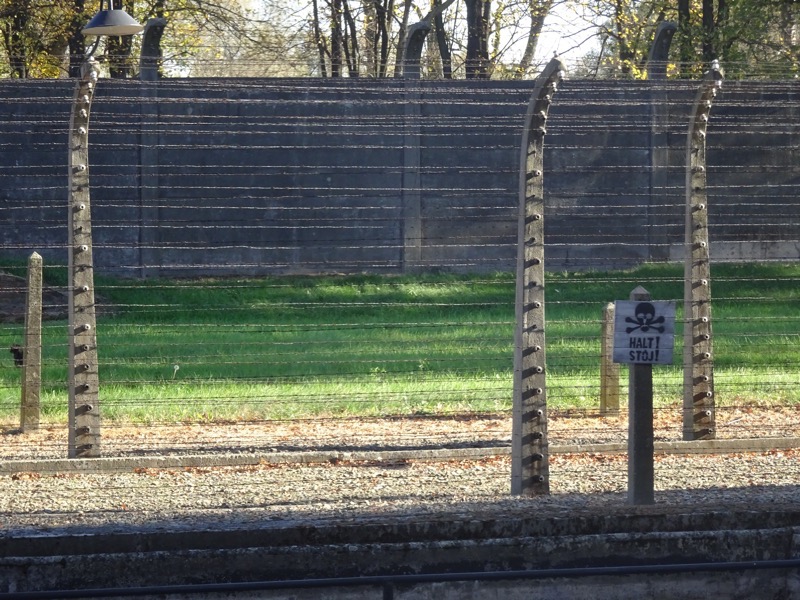
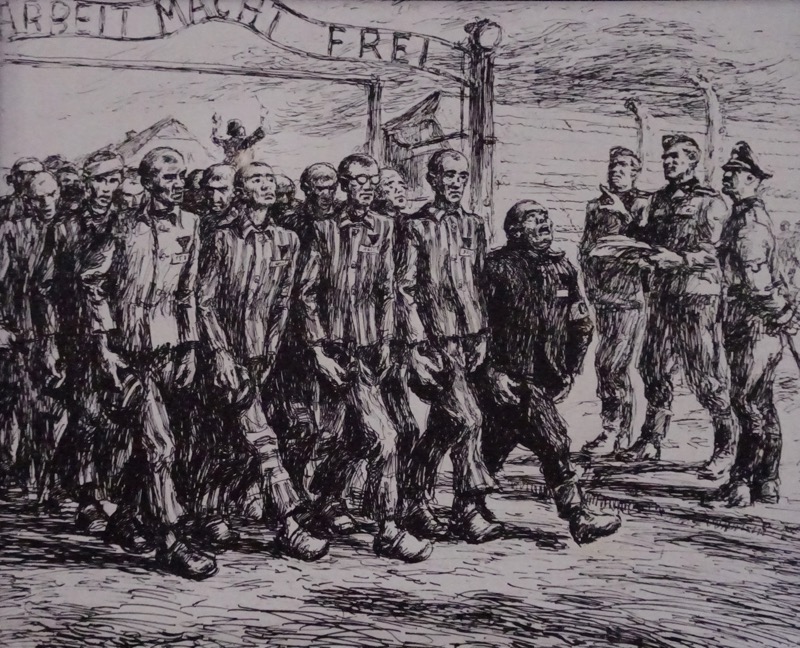

Prisoners held in the concentration camp died from being overworked, from starvation, from deliberately sadistic punishments, from sheer exhaustion at prolonged roll-calls, by being tortured, from appalling living conditions, by being used for medical experiments or through arbitrary executions. Those too weak, or too sick to work were selected by the SS during the roll-calls, or in the infirmary, and either sent to the chambers for extermination or murdered with an injection of phenol.
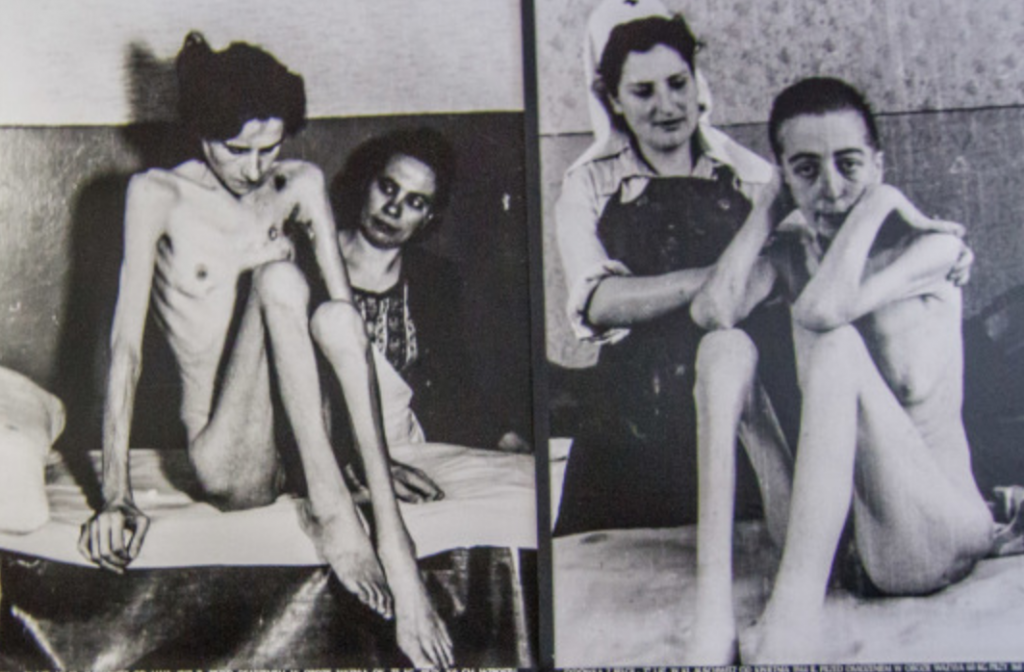
Constant starvation was one of the main factors in the degradation and extermination of prisoners. The daily food ration of each prisoner consisted of approximately 1,200-1,700 kilocalories. Most prisoners had to survive on these rations whilst working approximately 11 hours every day. Prisoners who could not find any additional sources of food usually died after just a few months imprisonments in the camp.
For all their claims to the contrary, the Nazis deported several hundred thousand children to the concentration camps. The Nazis deported about 232,000 children and young people to KL Auschwitz, including 216,000 Jewish children, 11,000 Roma (Gypsy) children, 3,000 Polish children and 1,000 children of other nationalities. The majority of the children perished in the gas chambers immediately after arrival. However, a ‘lucky’ few who had the right ‘features’ ie: were of desirable Aryan appearance with blonde hair and blue eyes, would be taken from their parents and given to good German families to raise. Altogether about 22,000 children and young people of various nationalities were registered as prisoners at KL Auschwitz, meaning the other 200,000 children who arrived at Auschwitz were killed on arrival. On 27 January 1945, the Red Army soldiers liberated only about 650 children and young people from the camp, of which 450 were under 15 years old.
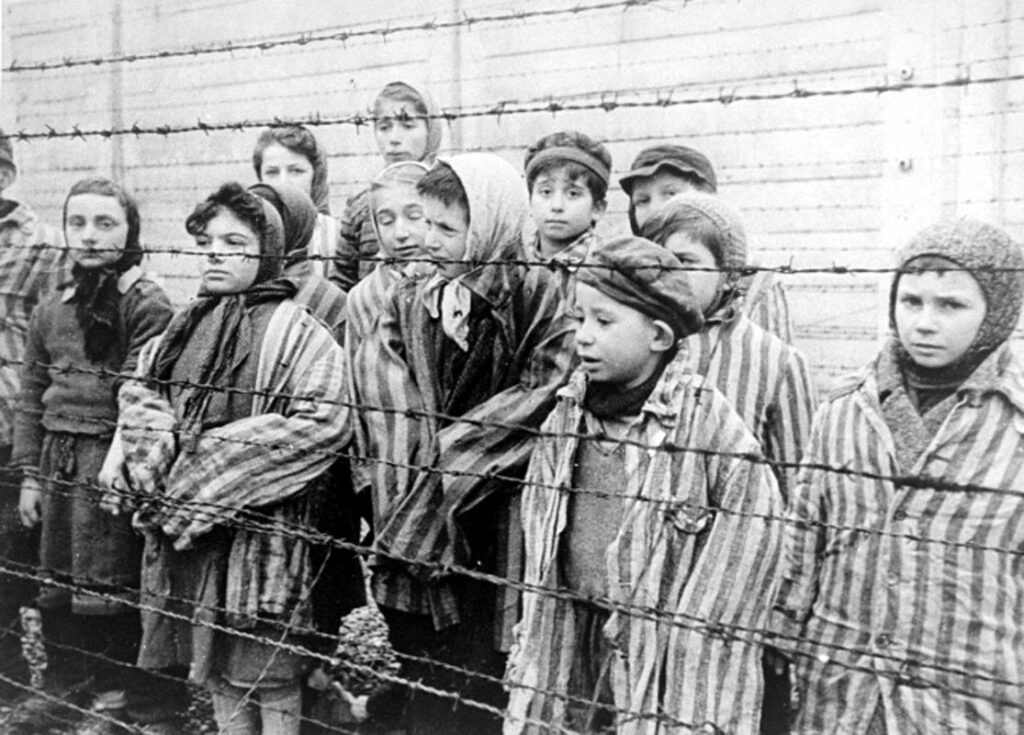
At the time of liberation, there were many children in the camp who were taken there so young as to not know their full names or what towns and regions their families had come from. Many of these children were never reunited with families and several never knew their identities.
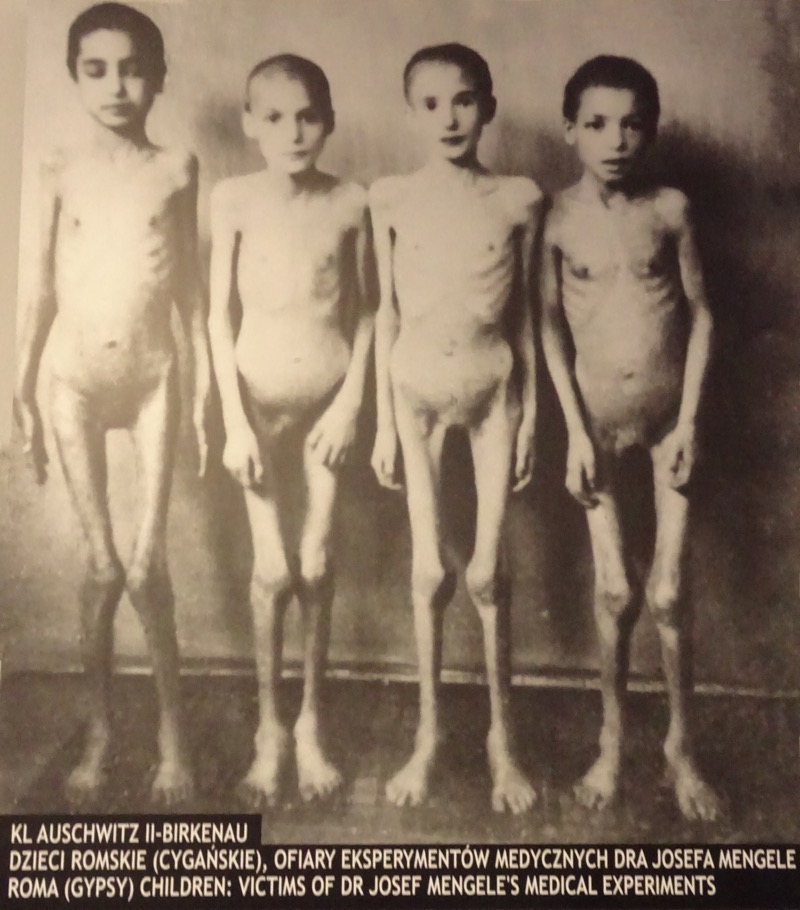
 Map of the Block 11 Punishment Unit. This was effectively the prison within the prison. If prisoner committed offences while in the camp, they could expect any sort of retribution – immediate execution, solitary confinement for a period of time, confinement to starvation with the intention of murdering the prisoner, or face a firing squad at an unknown future time. Note Section 22 in the left hand building – it has what is know as ‘standing cells’ where prisoners entered through a two foot door in a wall and were put in a cell approximatedly two foot square and six foot tall. Prisoners would be locked in this standing cell in complete darkness for indeterminate periods of time.
Map of the Block 11 Punishment Unit. This was effectively the prison within the prison. If prisoner committed offences while in the camp, they could expect any sort of retribution – immediate execution, solitary confinement for a period of time, confinement to starvation with the intention of murdering the prisoner, or face a firing squad at an unknown future time. Note Section 22 in the left hand building – it has what is know as ‘standing cells’ where prisoners entered through a two foot door in a wall and were put in a cell approximatedly two foot square and six foot tall. Prisoners would be locked in this standing cell in complete darkness for indeterminate periods of time.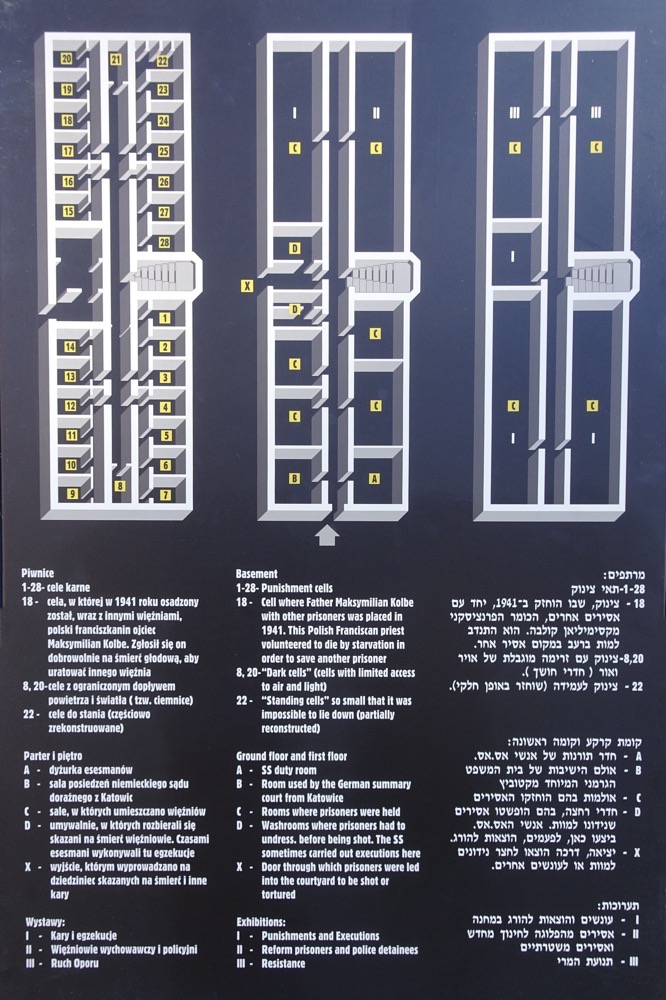 Prisoners were led to this wall for execution by firing squad.
Prisoners were led to this wall for execution by firing squad.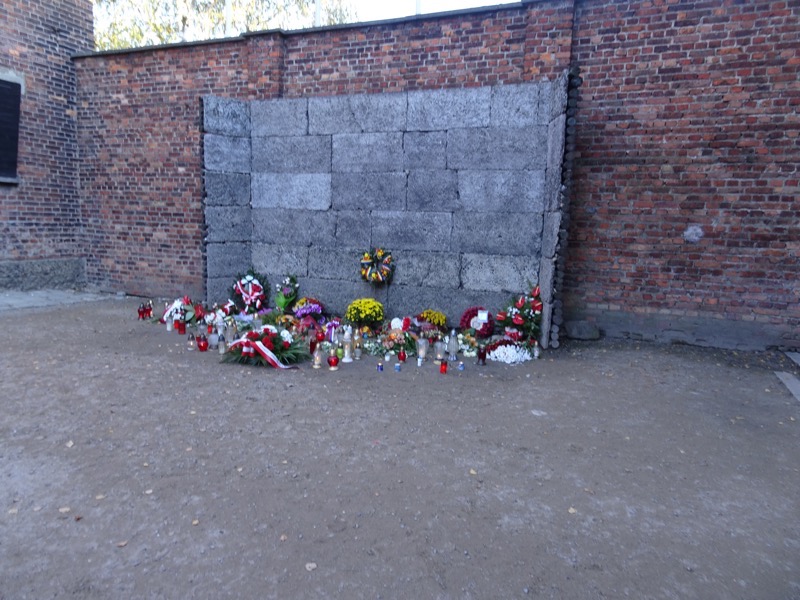
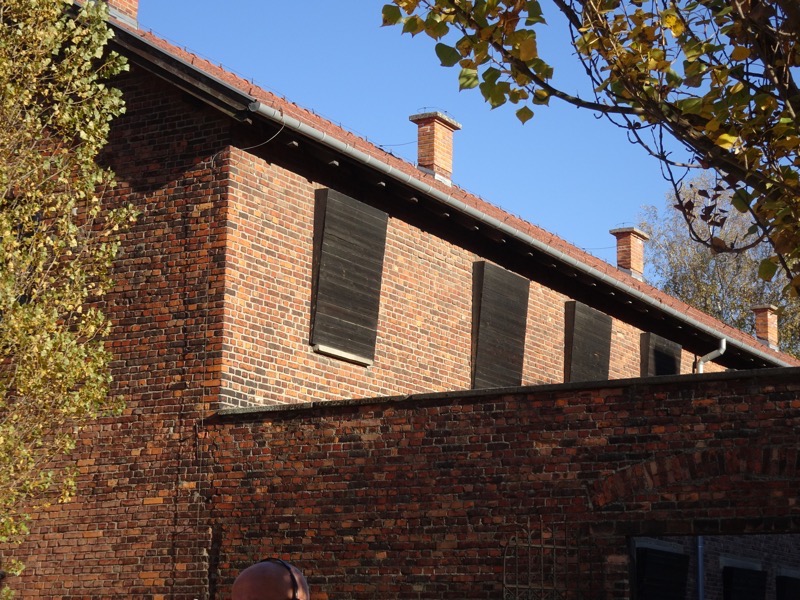 The barracks beside the execution courtyard were blocked from seeing what was happening during the executions. Prisoners avoided having anything to do with Block 11 and tried hard to stay away from it when going about their duties.
The barracks beside the execution courtyard were blocked from seeing what was happening during the executions. Prisoners avoided having anything to do with Block 11 and tried hard to stay away from it when going about their duties.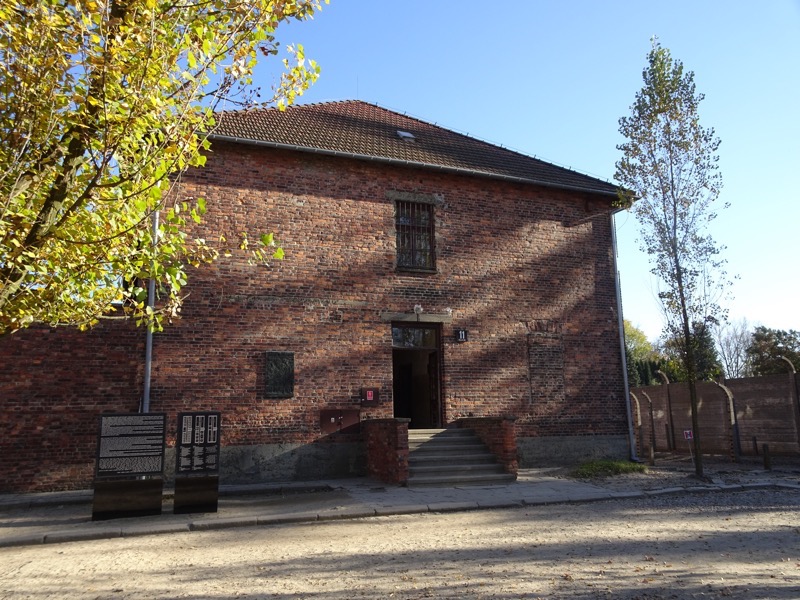 A guardhouse used by SS officials for shelter during the harsh roll-calls that prisoners were forced to endure:
A guardhouse used by SS officials for shelter during the harsh roll-calls that prisoners were forced to endure:
 In the centre of Auschwitz KL, the SS officer in charge would hold a roll call in the courtyard above. The roll call contained reports on the number of prisoners present. If there seemed to be anyone missing, prisoners had to continue to stand at attention until the SS were satisfied – regardless of the weather, sometimes for up to twelve hours or more. To intimidate the prisoners, the SS would also conduct public hangings in full view of the roll-call area. The largest such execution was carried out on 19 July 1943 when twelve Poles suspected of helping three other prisoners escape, and of maintaining contacts with the outside world, were hanged together on a purpose-built gallows.
In the centre of Auschwitz KL, the SS officer in charge would hold a roll call in the courtyard above. The roll call contained reports on the number of prisoners present. If there seemed to be anyone missing, prisoners had to continue to stand at attention until the SS were satisfied – regardless of the weather, sometimes for up to twelve hours or more. To intimidate the prisoners, the SS would also conduct public hangings in full view of the roll-call area. The largest such execution was carried out on 19 July 1943 when twelve Poles suspected of helping three other prisoners escape, and of maintaining contacts with the outside world, were hanged together on a purpose-built gallows.
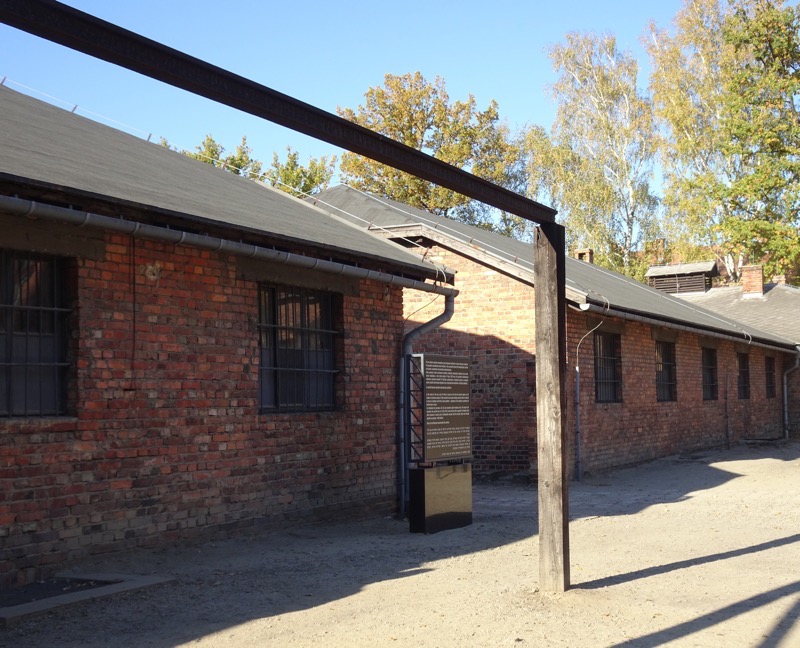



Rudolf Höss was the German SS officer who was the longest-serving Commandant of Auschwitz. He tested and carried into Hitler’s plan to systematically exterminate the Jewish population. Höss lived in a home with his wife and family that is in surprisingly close proximity (about 50m) from the gas chamber and crematorium of Auschwitz KL. It is unbelievable how he could live a regular family life and raise his children so close this horrifying place of daily mass murder.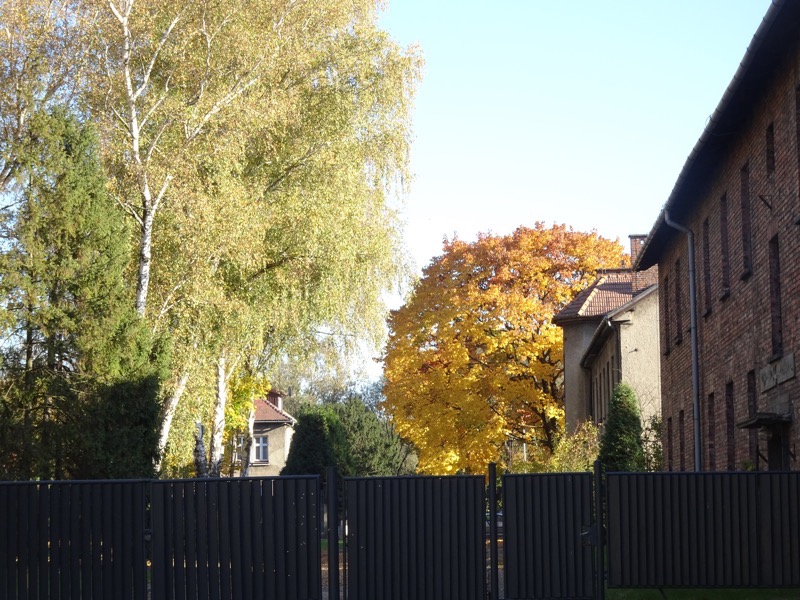 Later, after the war, and after the trials for war crimes, a special gallows was built here and Rudolph Höss was hanged on 16 April 1947, after a trial before the Polish Supreme National Tribunal. Fittingly he was executed at Auschwitz, in between of his former home and the gas chambers. It is not possible to believe that the Höss family didn’t hear, smell and see the airborne ash remains of the prisoners emerging from the chimneys, who met their fate in the gas chambers.
Later, after the war, and after the trials for war crimes, a special gallows was built here and Rudolph Höss was hanged on 16 April 1947, after a trial before the Polish Supreme National Tribunal. Fittingly he was executed at Auschwitz, in between of his former home and the gas chambers. It is not possible to believe that the Höss family didn’t hear, smell and see the airborne ash remains of the prisoners emerging from the chimneys, who met their fate in the gas chambers.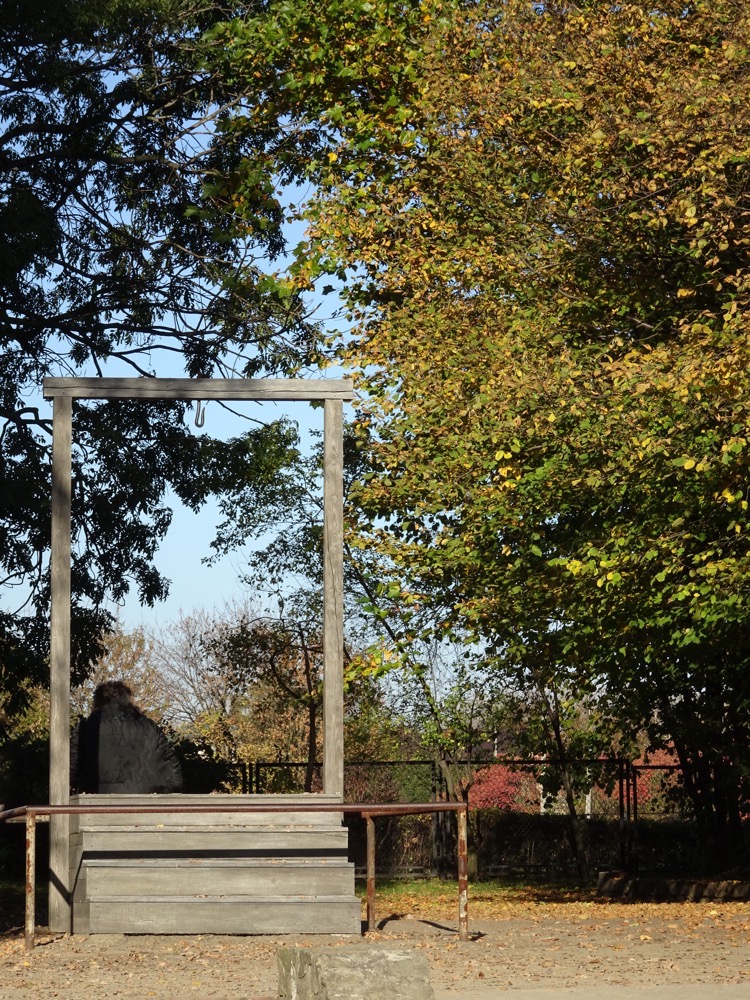
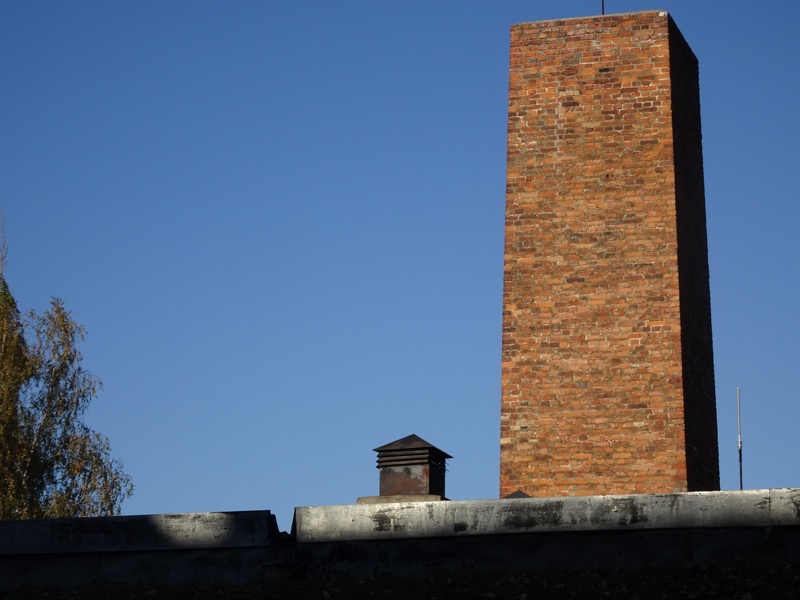
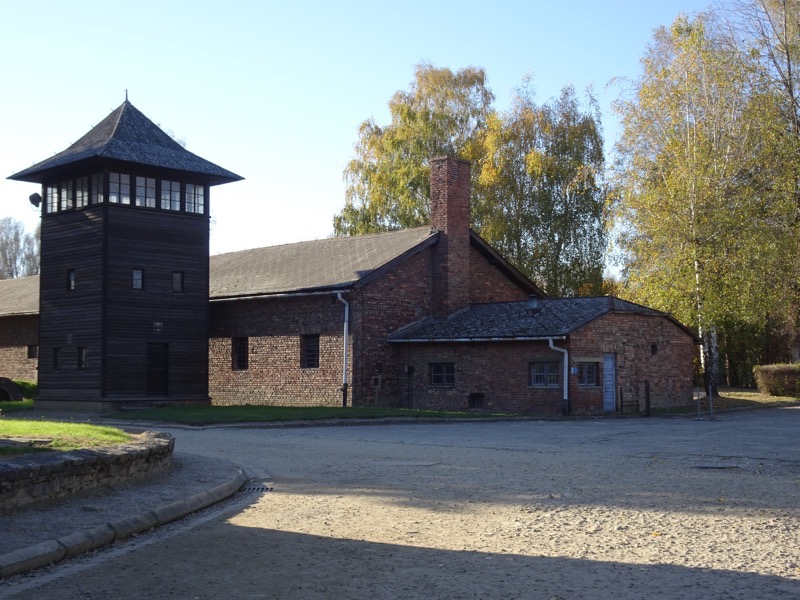 The small gas chamber at KL (Konzentrationslager) Auschwitz:
The small gas chamber at KL (Konzentrationslager) Auschwitz: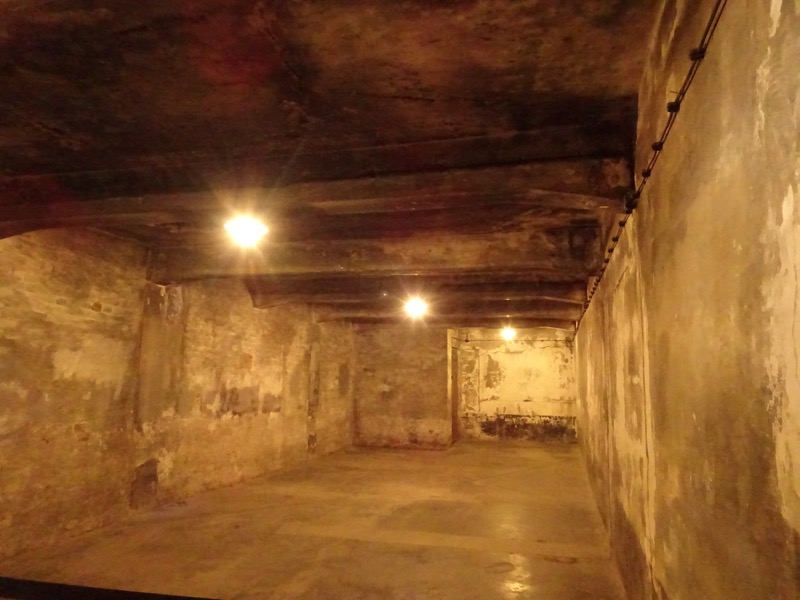
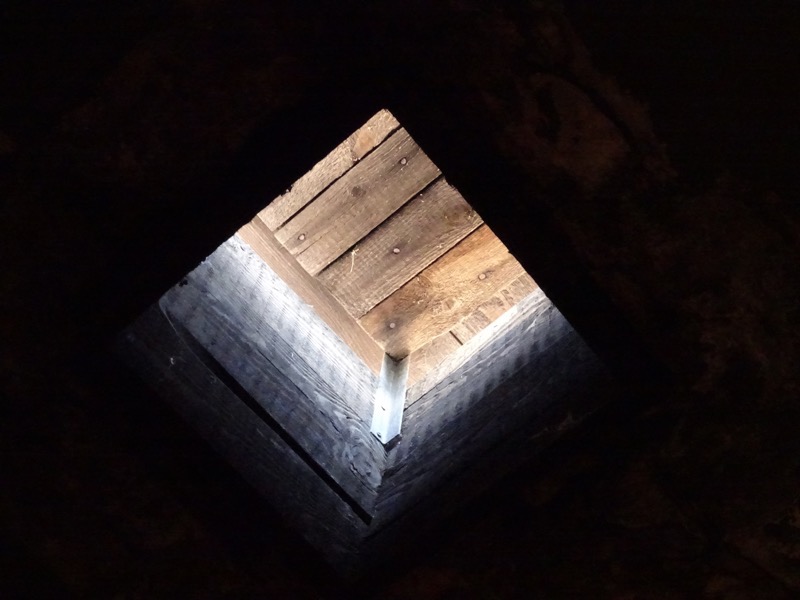 The creamation works directly beside the gas chamber.
The creamation works directly beside the gas chamber.
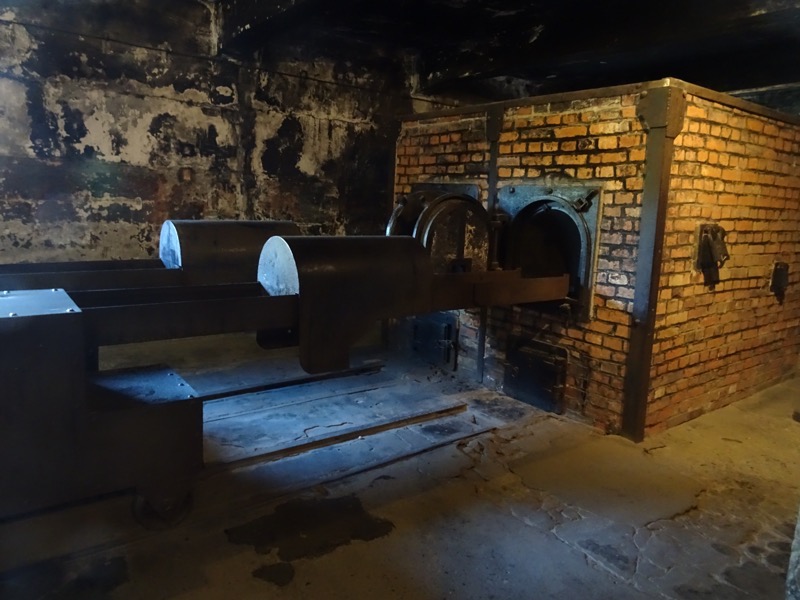 All of which is only divided from the worker/prisoner barracks by two rows of patrolled barbed wire. The prisoners must have also know the fates of those who entered the chambers.
All of which is only divided from the worker/prisoner barracks by two rows of patrolled barbed wire. The prisoners must have also know the fates of those who entered the chambers.
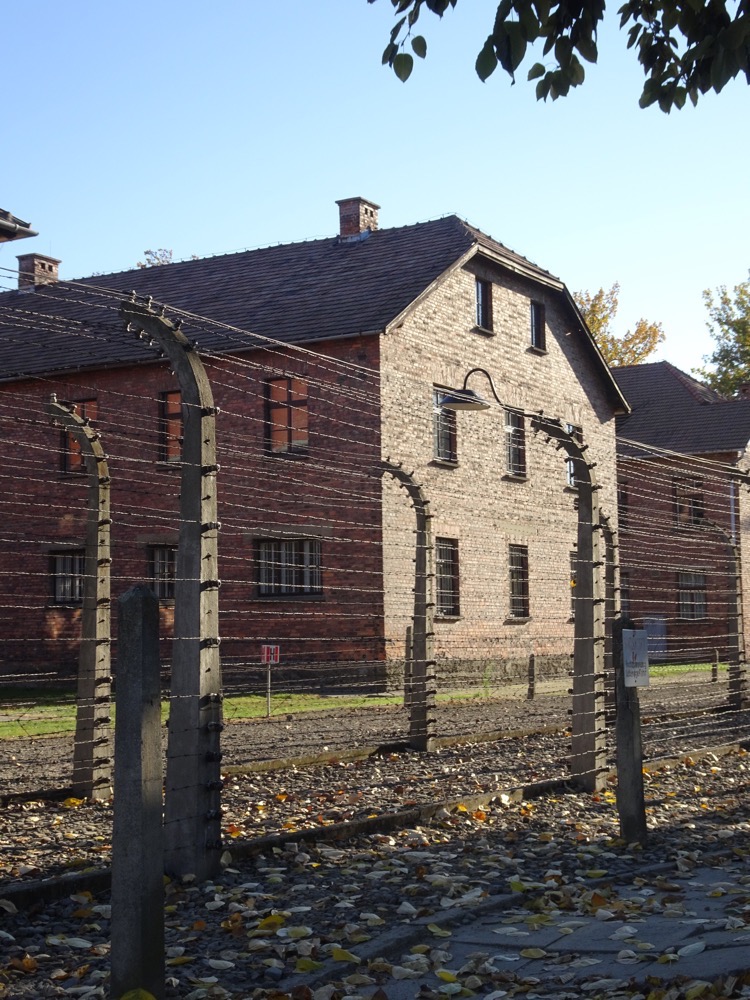 It was at this point we had a break in our tour and I took the opportunity to talk to our guide, Marta, who I had noticed handled the appalling and traumatizing material that she was imparting in a professional, yet very sensitive manner. She was managing to share some truly harrowing content with us in a matter of fact manner, and I wanted to commend her on what I thought must be a difficult and delicate balance between educating visitors and yet now allowing the recitation of bland facts to overwhelm the truly unbelievably vile events that occurred here. I was also curious to know how long she had been guiding visitors through Auschwitz, how many times each day would she go through the complex and how did she manage to not allow the horrific nature of the events that she was constantly discussing not to affect her personally on a psychological level? It turns out that Marta is not actually one of the main tour guides. She is a historian and curator at the museum and she only takes tours on rare occasions.
It was at this point we had a break in our tour and I took the opportunity to talk to our guide, Marta, who I had noticed handled the appalling and traumatizing material that she was imparting in a professional, yet very sensitive manner. She was managing to share some truly harrowing content with us in a matter of fact manner, and I wanted to commend her on what I thought must be a difficult and delicate balance between educating visitors and yet now allowing the recitation of bland facts to overwhelm the truly unbelievably vile events that occurred here. I was also curious to know how long she had been guiding visitors through Auschwitz, how many times each day would she go through the complex and how did she manage to not allow the horrific nature of the events that she was constantly discussing not to affect her personally on a psychological level? It turns out that Marta is not actually one of the main tour guides. She is a historian and curator at the museum and she only takes tours on rare occasions.
yale looked Marta up online later to find out more about her background and we discovered she is one of the preeminent specialists in educational projects connected to the Auschwitz memorials and museums.
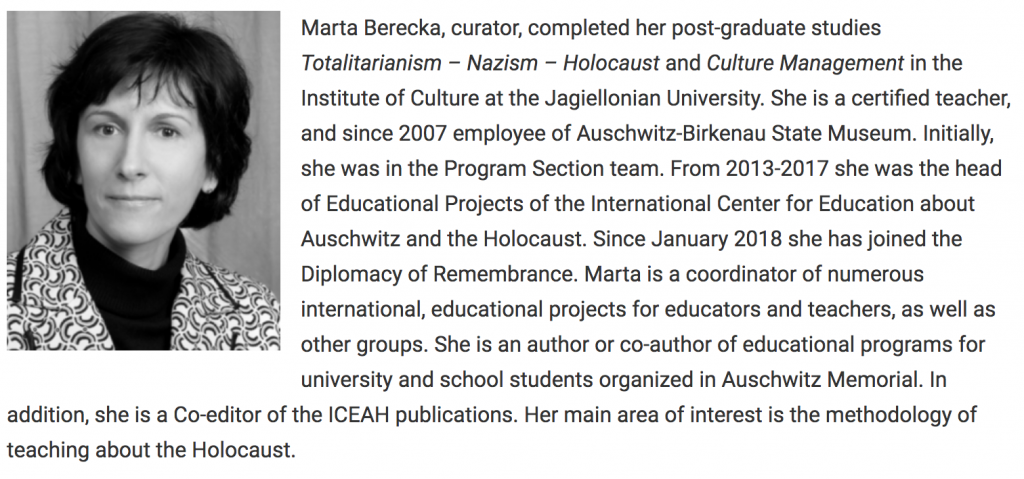
After reading her biography I can see now why she was so willing to engage in a discussion with me, regarding the important role she feels the museum plays in educating generations of people who are now less directly connected to the atrocities committed here. She said that 15 years ago, many of their visitors all knew someone or had met someone who was directly connected to the concentration camps… now the living memories of what happened here during the Holocaust were starting to fade, as the survivors themselves were passing away. It was obvious that Marta was very connected to the material having visited Auschwitz many times. Before she started working for the museum she worked with survivors and participated in helping to collect testimonies of peoples’ experiences at Auschwitz. While Marta somehow managed to maintain the professionalism of an academic, it was obvious that her empathy for these people and this place was genuine but also somehow composed, calm and tempered. I am not sure I could do this work – though I do believe her role in educating future generations on the atrocities committed at Auschwitz is vitally important… in the current political climate, perhaps now more than ever.
Our tour continued after a short bus ride to the larger camp area of Auschwitz II-Birkenau. Whereupon we were greeted by rows and rows of brick or timber barracks as far as the eye could see. I had no idea the sheer scale of this camp. I guess you read that it is 180ha and accommodated up to 130,000 prisoners, but the size of this place and the human misery that it must have seen is on a scale that I found difficult to comprehend. We approached by the famous brick rail gate and started walking into the camp. To our right were the timber barracks belonging to the male prisoners, in sections B1, B2, B3, B4, B5 all the way back to ‘Kanada’.

‘Kanada’ was a series of warehouses where the belongings of the murdered prisoners were taken to be sorted and redistributed to the Reich. Many of the goods acquired here were the portable items of value that the deported Jews were able to bring with them when they were hastily removed from their homes and then removed again from the ghettos. Jobs in Kanada were highly prized and often given to the ‘favourite’ prisoners of powerful SS officers. Having friends in Kanada could mean access to warmer clothing, and possible food to supplement rations or goods to barter with.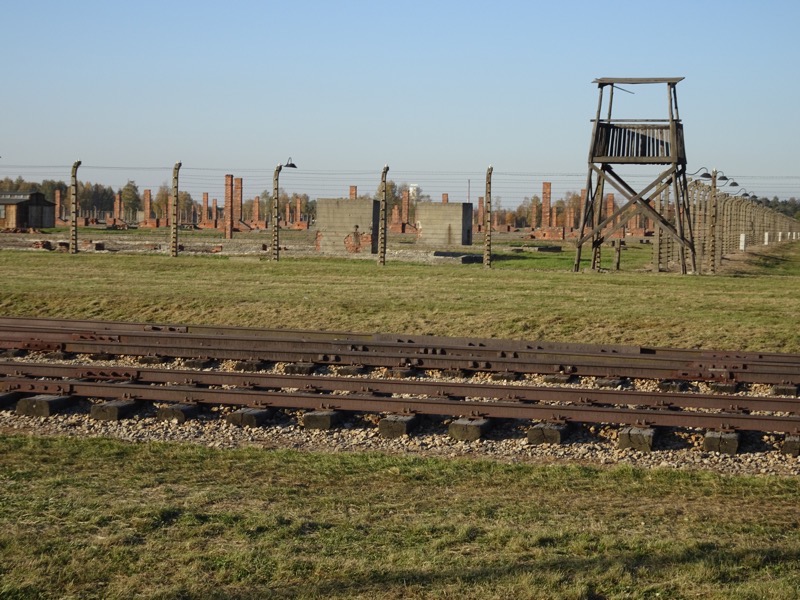
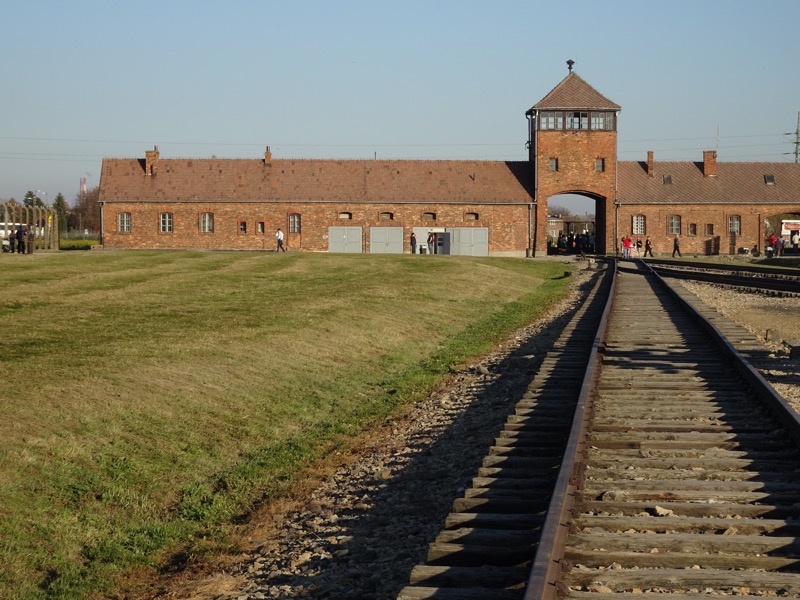
 It was during this part of the tour that the sheer scale of the camp hits visitors hard. One hundred and eighty hectares of organised misery, degradation and for most, eventual death.
It was during this part of the tour that the sheer scale of the camp hits visitors hard. One hundred and eighty hectares of organised misery, degradation and for most, eventual death.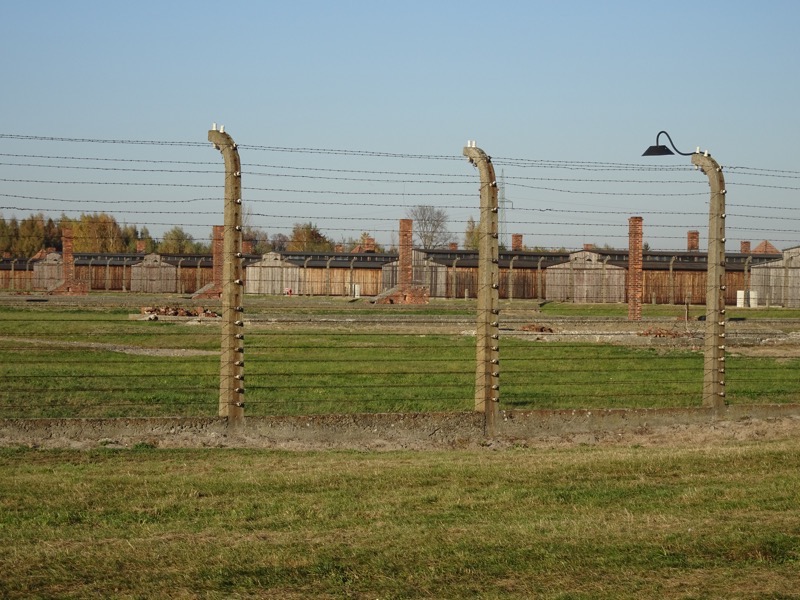 A replica of the railway cars which were used to transport most of the deportees to Auschwitz-Birkenau. Eighty to one hundred people were crammed into these cars for journeys lasting days with no food, no water and no toileting facilities. Tens of thousands of people arrived at the camp in cars just like this one.
A replica of the railway cars which were used to transport most of the deportees to Auschwitz-Birkenau. Eighty to one hundred people were crammed into these cars for journeys lasting days with no food, no water and no toileting facilities. Tens of thousands of people arrived at the camp in cars just like this one.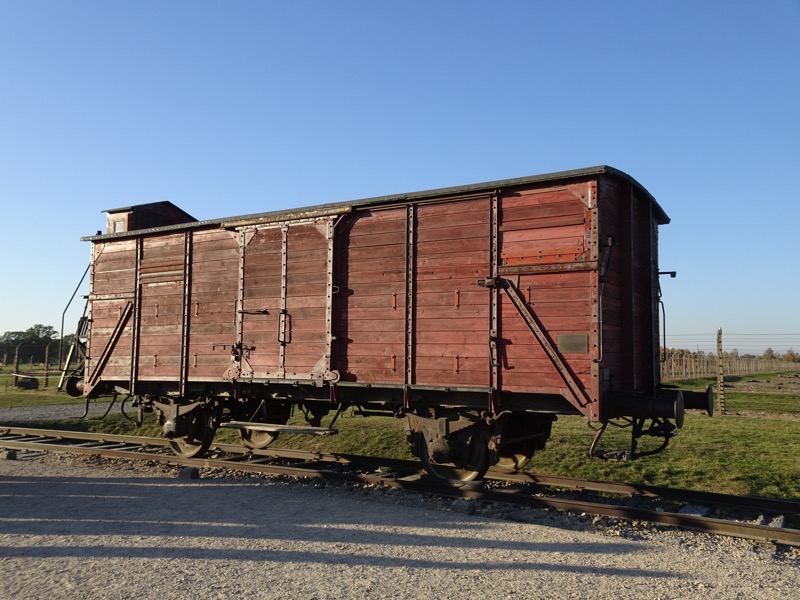 The further into the camp we walked, the size of the camp became more and more apparent.
The further into the camp we walked, the size of the camp became more and more apparent.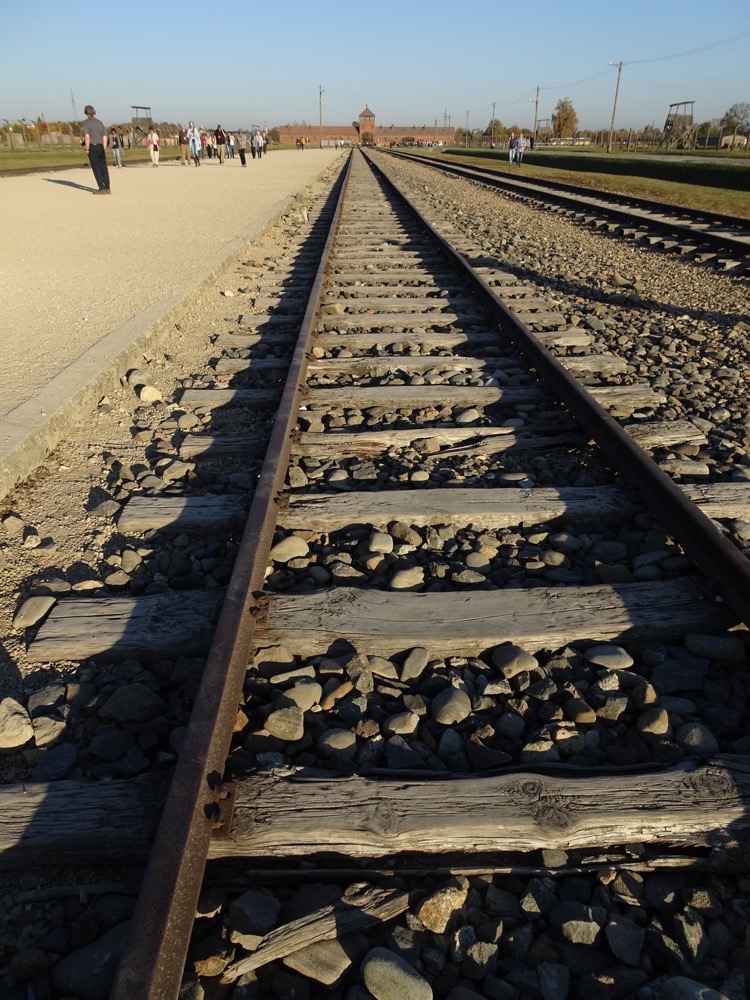
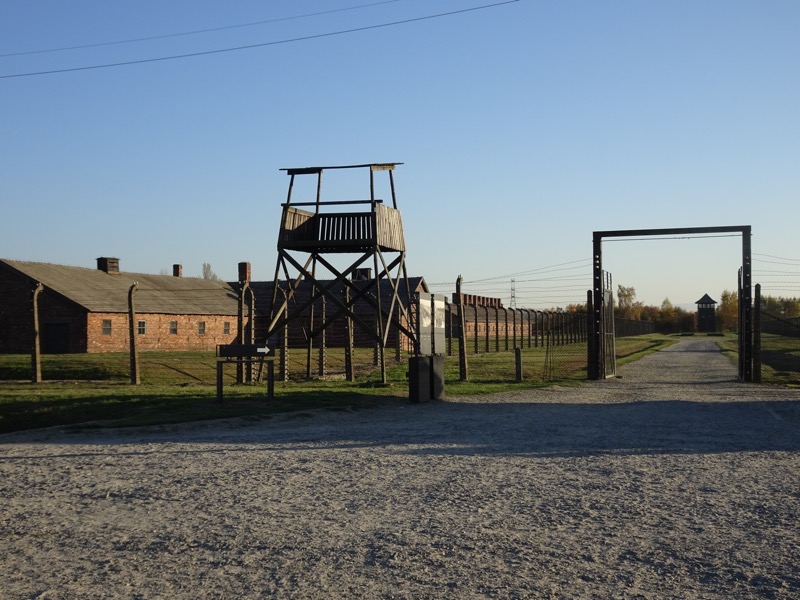
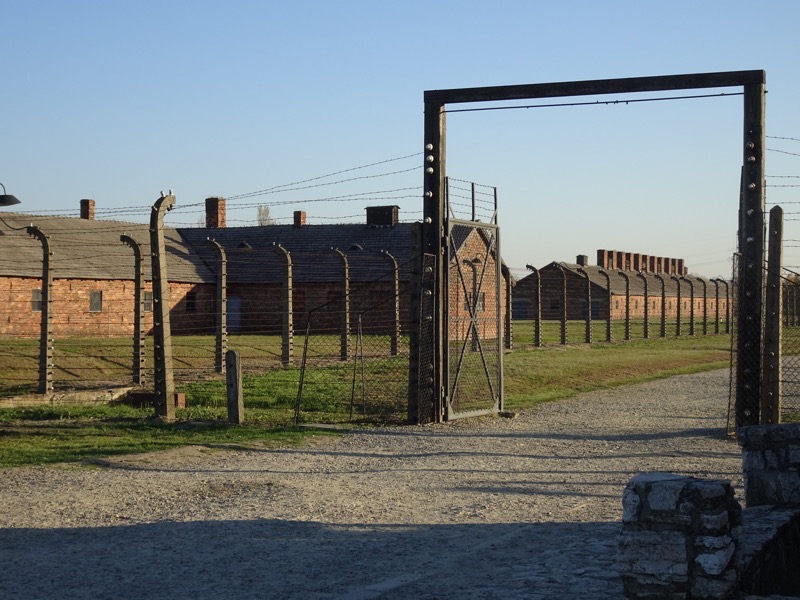 At the ramps at the end of the train tracks where the selection processes were carried out. Behind us is the massive L shaped gas chamber and industrial creamatoria complex.
At the ramps at the end of the train tracks where the selection processes were carried out. Behind us is the massive L shaped gas chamber and industrial creamatoria complex. The underground undressing chamber. Destroyed by departing Nazis as the end of the war became a certainty.
The underground undressing chamber. Destroyed by departing Nazis as the end of the war became a certainty.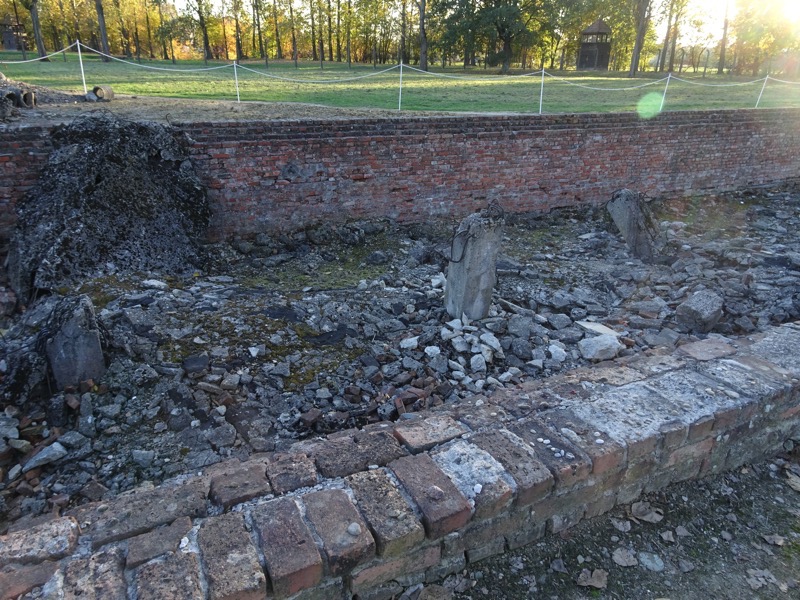 The collapsed roof of the gas chambers:
The collapsed roof of the gas chambers: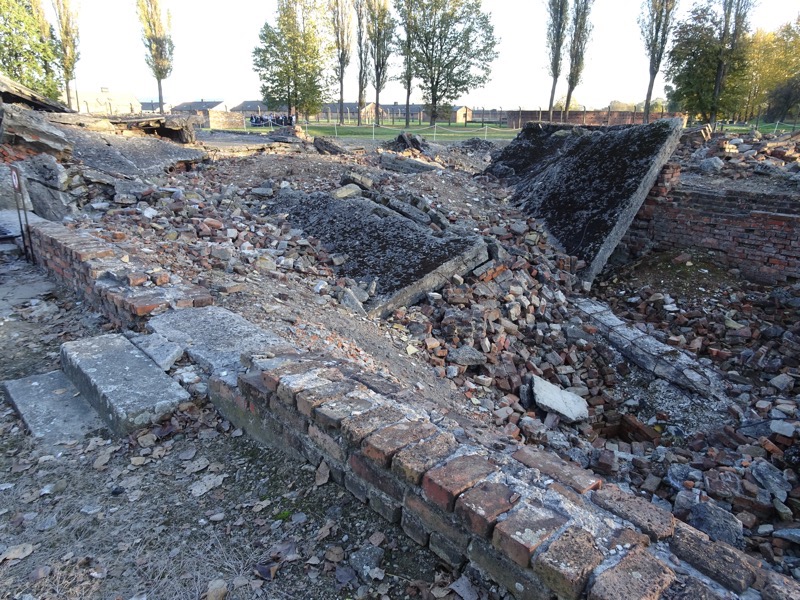
 The ruins of the cremation ovens:
The ruins of the cremation ovens: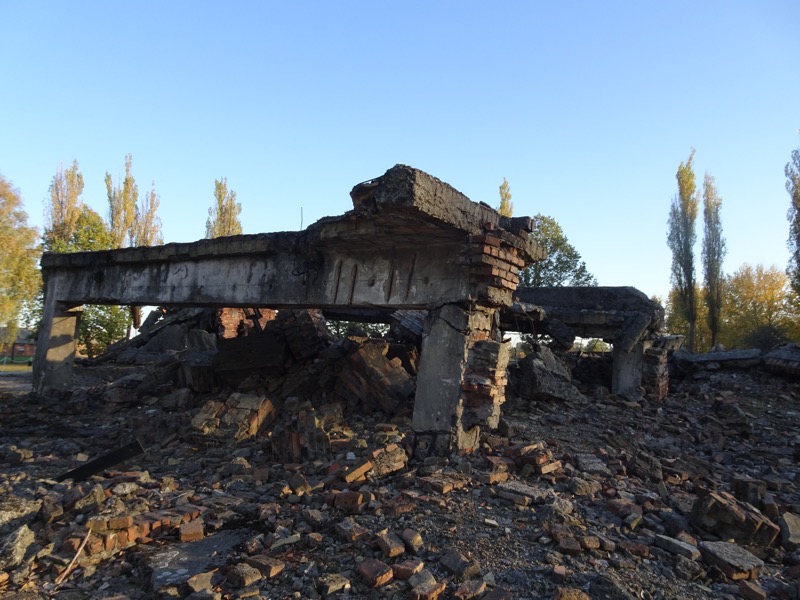 Much of the terrible work carried out in the mass extermination of the Jewish population was Sonderkommandos. The Sonderkommandos were a work detail made up of prisoners from the death camp. They were not civilian workers but were prisoners – usually Jewish – who were forced to work and aid in the management of victims, the looting of the bodies, and the disposal of the corpses in the gas chambers during the Holocaust. They were forced to complete this gruesome work or be killed themselves.
Much of the terrible work carried out in the mass extermination of the Jewish population was Sonderkommandos. The Sonderkommandos were a work detail made up of prisoners from the death camp. They were not civilian workers but were prisoners – usually Jewish – who were forced to work and aid in the management of victims, the looting of the bodies, and the disposal of the corpses in the gas chambers during the Holocaust. They were forced to complete this gruesome work or be killed themselves. 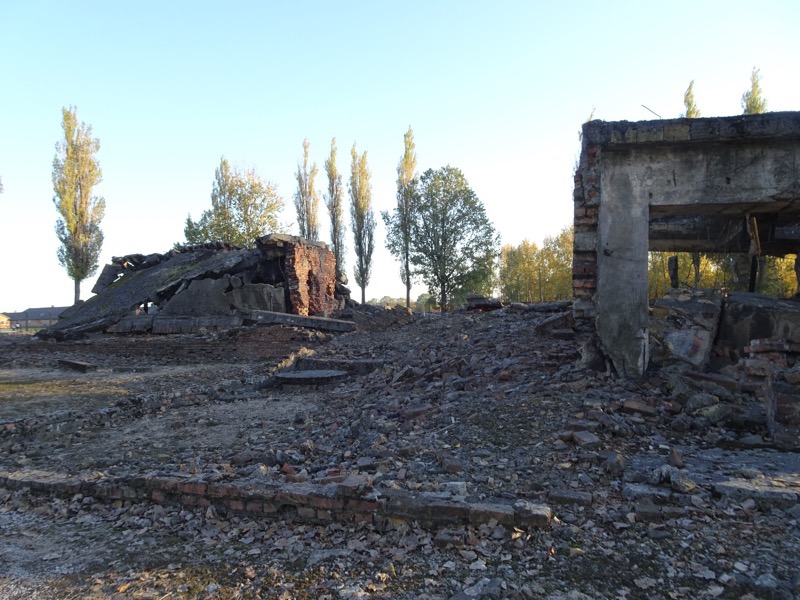
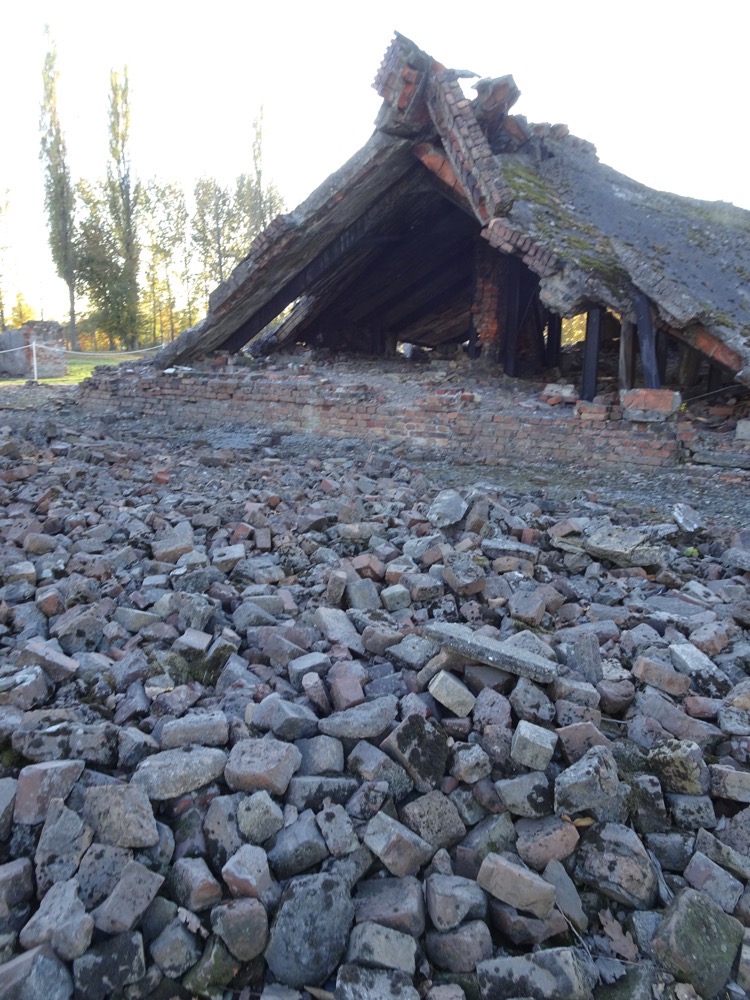
Red brick barracks made from building materials repurposed from the villages that were destroyed to make way for the camp:

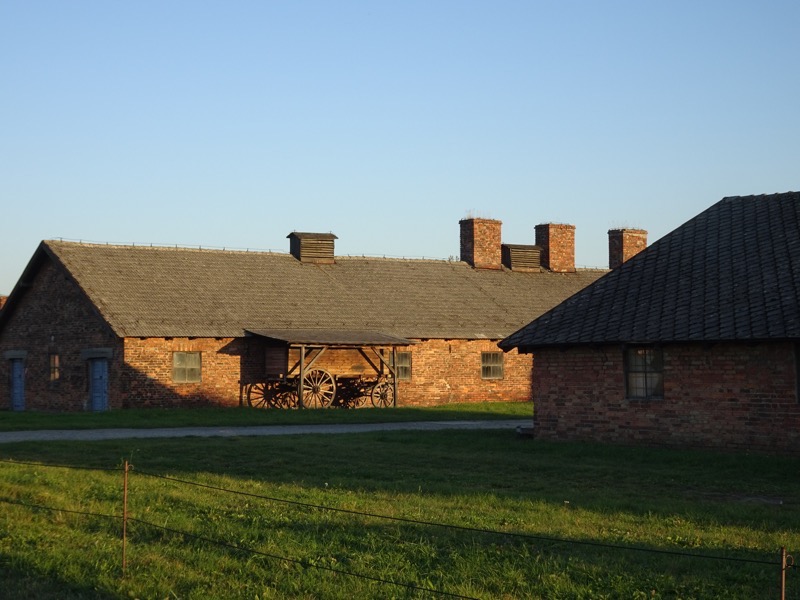
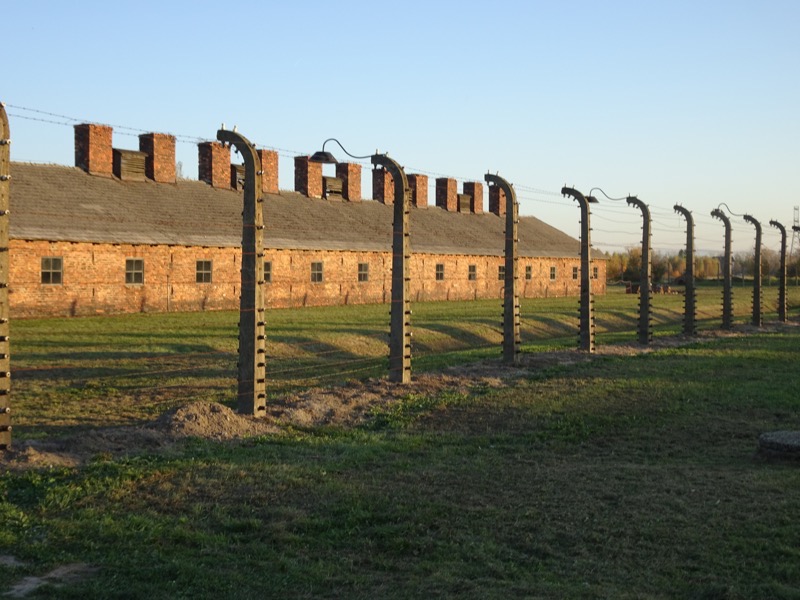 Inside Barracks 16A. ‘Beds’, such as they were, were three stories high and housed four to five people in each space. Necessary for warmth in winter but swelteringly uncomfortable and unsanitary in summer.
Inside Barracks 16A. ‘Beds’, such as they were, were three stories high and housed four to five people in each space. Necessary for warmth in winter but swelteringly uncomfortable and unsanitary in summer. There were no washing facilities in the buildings. Any bathing had to occur outside.
There were no washing facilities in the buildings. Any bathing had to occur outside.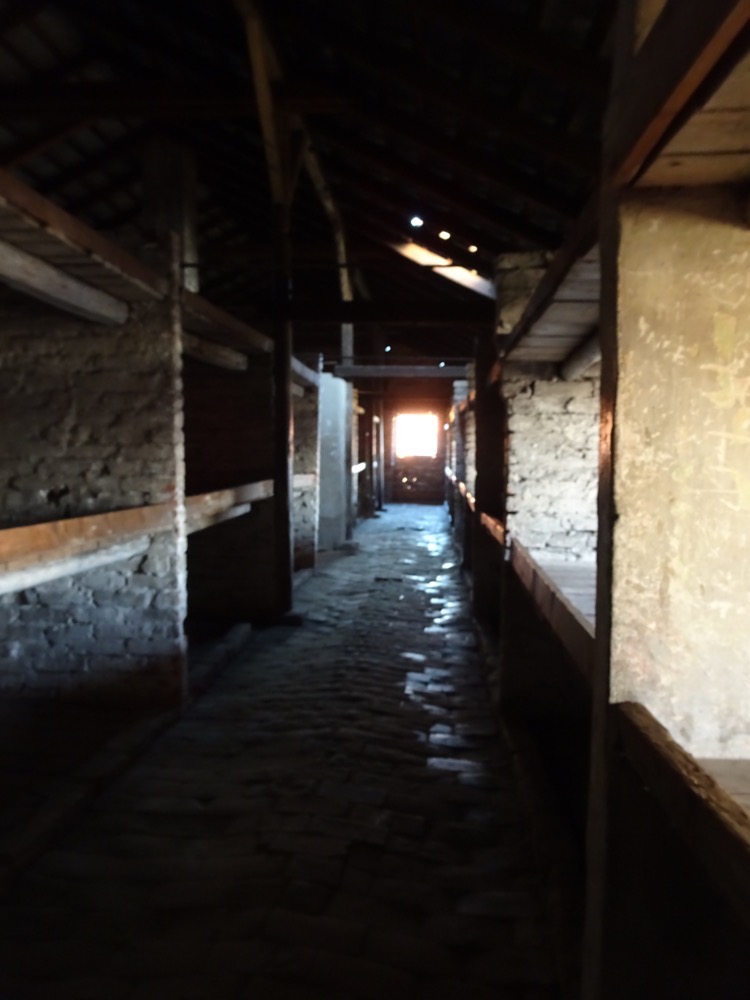
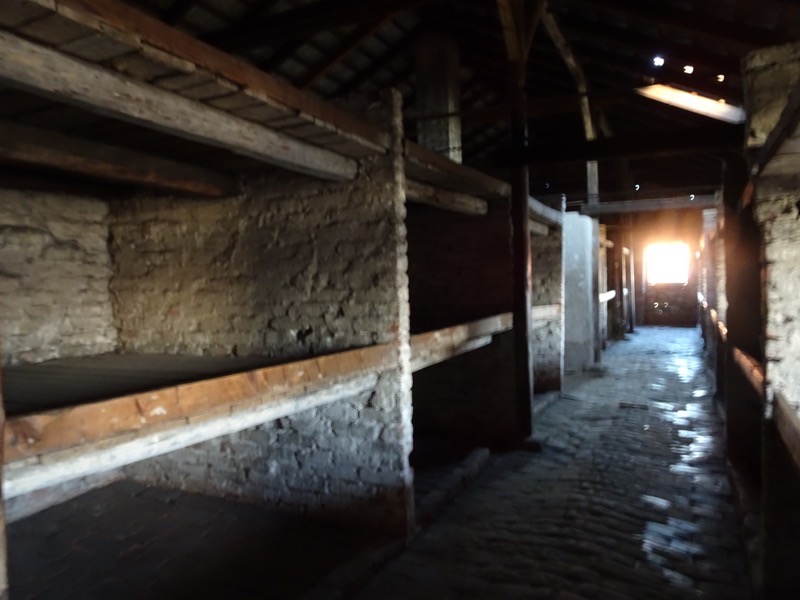
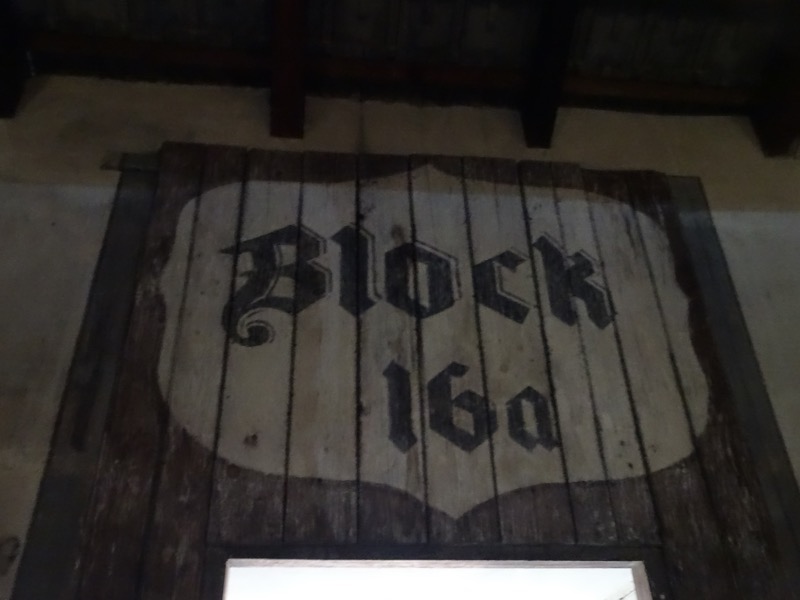 There is much more that could be said about Auschwitz-Birkenau, and there are incalculable books on the topic that adequately demonstrate that. But there is little that captures the feeling of being here and physically taking in this history in person.
There is much more that could be said about Auschwitz-Birkenau, and there are incalculable books on the topic that adequately demonstrate that. But there is little that captures the feeling of being here and physically taking in this history in person.
 As I was saying to Marta, I don’t remember a time in my life where I learned about the atrocities committed by the Nazis during WWI. I don’t remember gleaning this knowledge for the first time and being shocked and appalled by the inhumanity of it. I grew up seemingly always aware of Hitler, of Nazism, of the concentration camps almost by osmosis. The knowledge I always had merely grown in depth and detail as I got older… but having said this, I feel much like I didn’t really understand the extent of the horrors committed here until today. The scale of the brutality is unimaginable until you are faced with it.
As I was saying to Marta, I don’t remember a time in my life where I learned about the atrocities committed by the Nazis during WWI. I don’t remember gleaning this knowledge for the first time and being shocked and appalled by the inhumanity of it. I grew up seemingly always aware of Hitler, of Nazism, of the concentration camps almost by osmosis. The knowledge I always had merely grown in depth and detail as I got older… but having said this, I feel much like I didn’t really understand the extent of the horrors committed here until today. The scale of the brutality is unimaginable until you are faced with it. “The last thing to die is hope…”
“The last thing to die is hope…”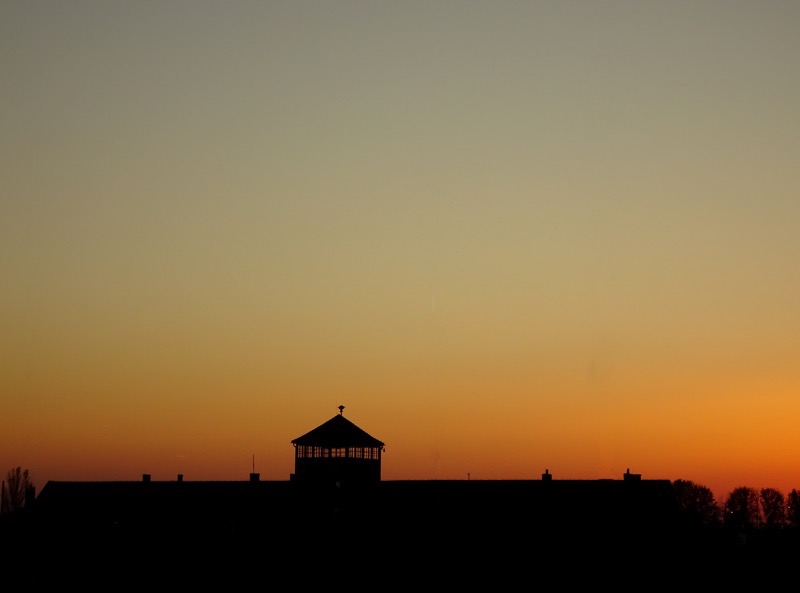
I have had to put this post aside several times as writing this all down and compiling these images have been exhausting. After we drove back to Krakow, we went hunting for something a bit more uplifting to finish the day. We found it in the form of a quaint and quirky little restaurant in the Jewish Quarter called, “Once Upon a Time in Kazimierz”. There was live music and great local food on the menu – exactly what we could have hoped for.
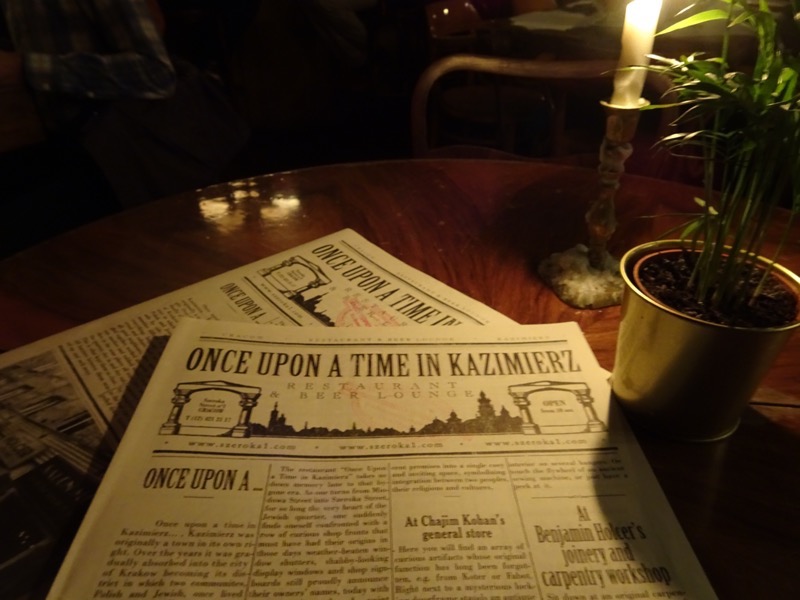 Weird and wonderful decor – one couple found themselves seated at a table that was actually an old treadle sewing machine.
Weird and wonderful decor – one couple found themselves seated at a table that was actually an old treadle sewing machine. Jewish Caviar – chopped chicken livers with eggs in truffle aroma, served with rye bread and whipped butter.
Jewish Caviar – chopped chicken livers with eggs in truffle aroma, served with rye bread and whipped butter. Beef and thyme pierogi, half and half (friend and boiled).
Beef and thyme pierogi, half and half (friend and boiled). Fillet of trout with vegetables in orange butter sauce (zucchini, leek and carrot).
Fillet of trout with vegetables in orange butter sauce (zucchini, leek and carrot). Jerusalem mix – chicken breast, liver, hearts in oriental spices and onion. Delicious!
Jerusalem mix – chicken breast, liver, hearts in oriental spices and onion. Delicious! We were the last to leave the restaurant after a couple more ciders!
We were the last to leave the restaurant after a couple more ciders!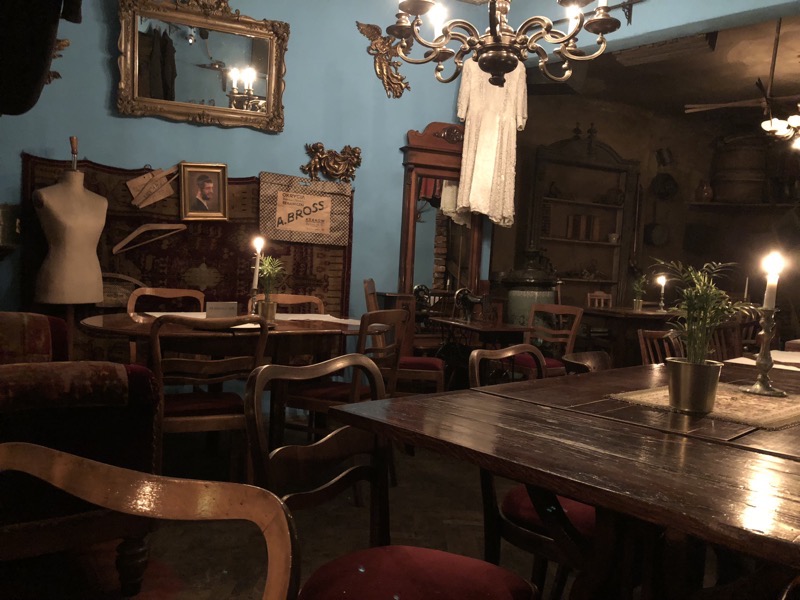 Dessert for yale: Pecan pie with vanilla ice cream:
Dessert for yale: Pecan pie with vanilla ice cream: And for me – steaming mead.
And for me – steaming mead.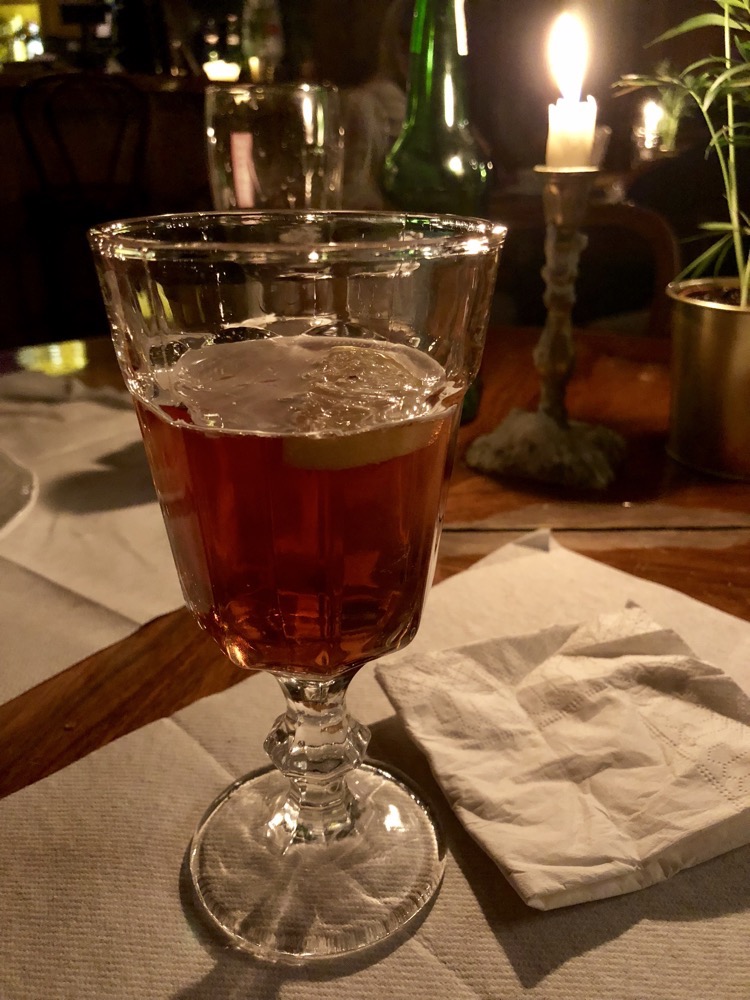 Long day. Need good sleep. Thankfully my, “can I speak to the manager” chat with the night conceirge guy has yielded a different room in the hotel with a better bed. Fingers crossed!
Long day. Need good sleep. Thankfully my, “can I speak to the manager” chat with the night conceirge guy has yielded a different room in the hotel with a better bed. Fingers crossed!


 Breakfast from Mozart’s Cafe which is the Grand Hotel’s restaurant… of course with clock outside the breakfast room.
Breakfast from Mozart’s Cafe which is the Grand Hotel’s restaurant… of course with clock outside the breakfast room. After breakfast, we had arranged a private transfer to the train station having discovered it was pretty much the same exorbitant rate that the rip off artist taxi drivers and Uber drivers were charging from the train station anyway… only this way we would have a fancy car and a nice man helping us with our luggage. Worked well and we got picked up right in the pedestrian square in front of the hotel.
After breakfast, we had arranged a private transfer to the train station having discovered it was pretty much the same exorbitant rate that the rip off artist taxi drivers and Uber drivers were charging from the train station anyway… only this way we would have a fancy car and a nice man helping us with our luggage. Worked well and we got picked up right in the pedestrian square in front of the hotel. RMB: That column on the right shows how late the trains are. Photo was taken 20 minutes ago.
RMB: That column on the right shows how late the trains are. Photo was taken 20 minutes ago. At one point a well dressed lady on her phone sat down on the piano stool with no intention to play the piano and was patently ignoring the dirty looks people were giving her for using the stool for a seat and not playing (station’s fault really for not providing enough seating and many were sitting on the floor), until some kids came along and started mashing the keys incoherently which eventually forced her to relinquish her position so she could stay on her call. Gotta love kids – they don’t care.
At one point a well dressed lady on her phone sat down on the piano stool with no intention to play the piano and was patently ignoring the dirty looks people were giving her for using the stool for a seat and not playing (station’s fault really for not providing enough seating and many were sitting on the floor), until some kids came along and started mashing the keys incoherently which eventually forced her to relinquish her position so she could stay on her call. Gotta love kids – they don’t care.
 We get up to the platform and see the signage is telling us that yes, this is the train to Krakow. Our previously posted 90 minute delay was now showing a 110 minute delay, so we found ourselves standing around on the platform with a bunch of Czech people who looked confused. I spoke with them and they said they didn’t think this was actually the train to Krakow. FFS. They seemed to have a slightly better knowledge of what was happening than we did – so I thought we’d stick with them until we were sure this was our train… last thing we needed after over two hours of waiting was to get on a train going somewhere else!
We get up to the platform and see the signage is telling us that yes, this is the train to Krakow. Our previously posted 90 minute delay was now showing a 110 minute delay, so we found ourselves standing around on the platform with a bunch of Czech people who looked confused. I spoke with them and they said they didn’t think this was actually the train to Krakow. FFS. They seemed to have a slightly better knowledge of what was happening than we did – so I thought we’d stick with them until we were sure this was our train… last thing we needed after over two hours of waiting was to get on a train going somewhere else! We settled into our compartment and were hoping for the best. Two people came along to talk to us, neither of whom spoke English so we were still a bit ‘Errr…?’ until about 20 mins into the journey a conductor came along asking for tickets. We handed over our ticket and she didn’t express any alarm about us being on the wrong train so we took that for a good sign.
We settled into our compartment and were hoping for the best. Two people came along to talk to us, neither of whom spoke English so we were still a bit ‘Errr…?’ until about 20 mins into the journey a conductor came along asking for tickets. We handed over our ticket and she didn’t express any alarm about us being on the wrong train so we took that for a good sign. 
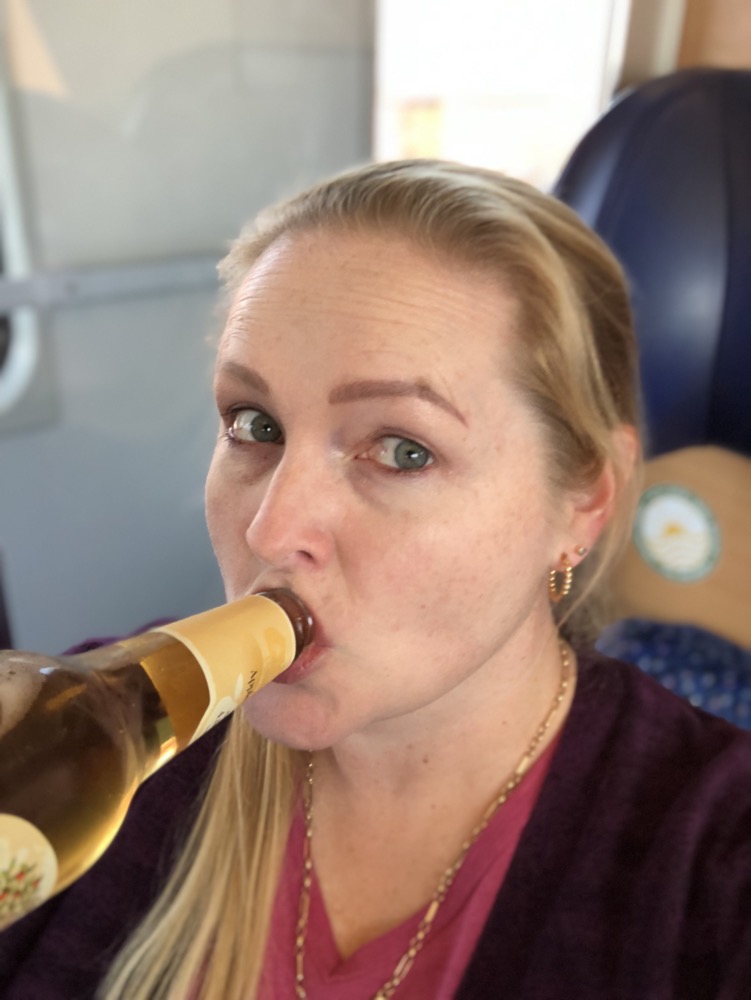 The next six hours passed in a blur of forrest and small towns with the occasional stop to not pick up anyone and seemingly not really to let anyone off. The train was more than half empty so I have no idea how this is at all profitable to run.
The next six hours passed in a blur of forrest and small towns with the occasional stop to not pick up anyone and seemingly not really to let anyone off. The train was more than half empty so I have no idea how this is at all profitable to run.


 So, we know we are going to arrive into Krakow station a full two hours late. Yay! Which means that we had been on the phone from the train trying to make sure that our hire car would still be able to be picked up. We were concerned that their office may have been closed. Turns out that was an impossibility, they don’t have an office, they have a guy who meets people at a pickup point in the main carpark to hand over keys and sign paperwork so we had the hire car main office people trying to track him down to make sure he could meet us in the carpark still.
So, we know we are going to arrive into Krakow station a full two hours late. Yay! Which means that we had been on the phone from the train trying to make sure that our hire car would still be able to be picked up. We were concerned that their office may have been closed. Turns out that was an impossibility, they don’t have an office, they have a guy who meets people at a pickup point in the main carpark to hand over keys and sign paperwork so we had the hire car main office people trying to track him down to make sure he could meet us in the carpark still. Down the road a little bit is a monument called ‘Prague Tower’, which is a monument to the Catholic Virgin Mary.
Down the road a little bit is a monument called ‘Prague Tower’, which is a monument to the Catholic Virgin Mary.

 Schwarzenberg Palace is famous for its striking sgraffito decorations. Sgraffito is a decorative technique based which is created by the application of two layers of mortar. After the mortar layers are applied, skilled craftsmen scratch through the top layer until they reach the black bottom layer creating intricate designs and illusions, giving the walls unusual depth and dimension. The method reminds me of the black and coloured crayon artworks we used to create as kids – put a myriad of colours on the paper and then cover it with black crayon, then we would scratch the black off to reveal patterns and drawings.
Schwarzenberg Palace is famous for its striking sgraffito decorations. Sgraffito is a decorative technique based which is created by the application of two layers of mortar. After the mortar layers are applied, skilled craftsmen scratch through the top layer until they reach the black bottom layer creating intricate designs and illusions, giving the walls unusual depth and dimension. The method reminds me of the black and coloured crayon artworks we used to create as kids – put a myriad of colours on the paper and then cover it with black crayon, then we would scratch the black off to reveal patterns and drawings. 

 Originally the palace was built for Florian Griespek of Griesbach, who was secretary of the Czech Chamber and confidante of Emperor Ferdinand I in the first half of the 16th century. But then Ferdinand bought the palace in 1561 and gave it to the Prague Archbishop, Antonin Brousa of Mohelnice (as you do!), and it has been the official residence of the Prague archbishopric ever since.
Originally the palace was built for Florian Griespek of Griesbach, who was secretary of the Czech Chamber and confidante of Emperor Ferdinand I in the first half of the 16th century. But then Ferdinand bought the palace in 1561 and gave it to the Prague Archbishop, Antonin Brousa of Mohelnice (as you do!), and it has been the official residence of the Prague archbishopric ever since.
 Prague Castle is THE largest ancient castle in the world, occupying an area of almost 70,000 square metres, and is about half a kilometre long and about 130m wide. It is one of the most visited attractions in Prague, seeing nearly 1.8 million visitors per annum (which means sections of the Castle are frequently closed for renovations and restorations), and it takes a good three to four hours to go through properly.
Prague Castle is THE largest ancient castle in the world, occupying an area of almost 70,000 square metres, and is about half a kilometre long and about 130m wide. It is one of the most visited attractions in Prague, seeing nearly 1.8 million visitors per annum (which means sections of the Castle are frequently closed for renovations and restorations), and it takes a good three to four hours to go through properly.  One very bored palace guard. At least he’s allowed to wear his Raybans so the tourist can’t see him rolling his eyes at them…
One very bored palace guard. At least he’s allowed to wear his Raybans so the tourist can’t see him rolling his eyes at them…


 Usually the couple would get dressed up and go somewhere nice and have their pictures taken and then copies are printed out and given to guests, or images are printed and on display at the actual wedding or even used in videos etc,… but as the Chinese population are becoming more and more affluent, they are studying and travelling abroad and choosing to have their pre-wedding photographs done at famous locations. For some of the more wealthy Chinese families, this is turning into a grand European tour with stops at many famous locations for a staged and posed series of photographs that could take several weeks to complete – which certainly explains why so many of the grooms look thoroughly over it. There are many Chinese photographers (the Chinese prefer very staged and posed photographs, and won’t use local photographers who aim for more candid and natural poses) basing themselves in desireable locations to capitalise on this market, and they sell packages which include photographer, makeup artists, gown rental and even permits to shoot in public places, in London and Paris. So that explains that.
Usually the couple would get dressed up and go somewhere nice and have their pictures taken and then copies are printed out and given to guests, or images are printed and on display at the actual wedding or even used in videos etc,… but as the Chinese population are becoming more and more affluent, they are studying and travelling abroad and choosing to have their pre-wedding photographs done at famous locations. For some of the more wealthy Chinese families, this is turning into a grand European tour with stops at many famous locations for a staged and posed series of photographs that could take several weeks to complete – which certainly explains why so many of the grooms look thoroughly over it. There are many Chinese photographers (the Chinese prefer very staged and posed photographs, and won’t use local photographers who aim for more candid and natural poses) basing themselves in desireable locations to capitalise on this market, and they sell packages which include photographer, makeup artists, gown rental and even permits to shoot in public places, in London and Paris. So that explains that.
 Originally the courtyard was 4-6m lower than it is currently, but has been built up over the centuries. I imagine that it is a rather interesting and impressive archaeological dig that we are walking over.
Originally the courtyard was 4-6m lower than it is currently, but has been built up over the centuries. I imagine that it is a rather interesting and impressive archaeological dig that we are walking over. 
 Construction of the present-day full-on Gothic cathedral began on 21 November 1344, when the See of Prague was elevated to an archbishopric. At that time, King John of Bohemia starting the building of the current impressive edifice. Apparently Charles IV, King of Bohemia and a soon-to-be self proclaimed Holy Roman Emperor, was heavily involved in the construction (read: patron/donor) and he planned for the new cathedral to be a coronation church, family crypt, treasury for the precious relics, and the final resting place of Saint Wenceslaus with a view to it also becoming a pilgrimage site. Charles IV, however, didn’t live to see much of the cathedral built.
Construction of the present-day full-on Gothic cathedral began on 21 November 1344, when the See of Prague was elevated to an archbishopric. At that time, King John of Bohemia starting the building of the current impressive edifice. Apparently Charles IV, King of Bohemia and a soon-to-be self proclaimed Holy Roman Emperor, was heavily involved in the construction (read: patron/donor) and he planned for the new cathedral to be a coronation church, family crypt, treasury for the precious relics, and the final resting place of Saint Wenceslaus with a view to it also becoming a pilgrimage site. Charles IV, however, didn’t live to see much of the cathedral built.  The cathedral has a long and illustrious history of various architects and patrons that goes on and on and which I won’t recount here – the long and the short of it is that the Cathedral remaind half completed for several hundred years, but by the time of St. Wenceslas jubilee in 1929 (yes, you read that right!), the St. Vitus cathedral was finally finished, nearly 600 years after it was started.
The cathedral has a long and illustrious history of various architects and patrons that goes on and on and which I won’t recount here – the long and the short of it is that the Cathedral remaind half completed for several hundred years, but by the time of St. Wenceslas jubilee in 1929 (yes, you read that right!), the St. Vitus cathedral was finally finished, nearly 600 years after it was started. n 1997, on the 1000th anniversary of the death of Saint Voitechus, there was a dedication ceremony where the church was re-dedicated to include Saint Wenceslaus and Saint Adalbert, as the remains/relics of Saint Adalbert have been interred here since 1038.
n 1997, on the 1000th anniversary of the death of Saint Voitechus, there was a dedication ceremony where the church was re-dedicated to include Saint Wenceslaus and Saint Adalbert, as the remains/relics of Saint Adalbert have been interred here since 1038.

 If you are looking at the stained glass and thinking the designs seem particularly modern – you are quite correct. Most of the glasswork was completed in 1929… and are somewhat incongruous with the high gothic style.
If you are looking at the stained glass and thinking the designs seem particularly modern – you are quite correct. Most of the glasswork was completed in 1929… and are somewhat incongruous with the high gothic style.




 My faith in Martin is thoroughly shattered – I have just remembered that the famous Strahov library is there! Nothing there indeed.
My faith in Martin is thoroughly shattered – I have just remembered that the famous Strahov library is there! Nothing there indeed. 

 Next, it was the long march/trudge down the stairs to the Mala Strana, or Lesser Town area. The Lesser Town is a hillside area with views across the Vitava River towards the Old Town. Traditionally its streets have been lined with hotels, bars, pubs and casual eateries.
Next, it was the long march/trudge down the stairs to the Mala Strana, or Lesser Town area. The Lesser Town is a hillside area with views across the Vitava River towards the Old Town. Traditionally its streets have been lined with hotels, bars, pubs and casual eateries.  The Lesser Town was once a cluster of noble houses and small palaces that eventually formed into the city’s administrative and mercantile centre. Some of the famous landmarks here are the picturesque burger buildings of Nerudova Street and St Nicholas’ Church.
The Lesser Town was once a cluster of noble houses and small palaces that eventually formed into the city’s administrative and mercantile centre. Some of the famous landmarks here are the picturesque burger buildings of Nerudova Street and St Nicholas’ Church.
 St. Nicholas Church (Kostel svateho Mikulase) was built in 1703-1755, on the site of an earlier Gothic church dating back to 1283. It is at the centre of the Lesser Town and is the largest Jesuit church founded in Prague.
St. Nicholas Church (Kostel svateho Mikulase) was built in 1703-1755, on the site of an earlier Gothic church dating back to 1283. It is at the centre of the Lesser Town and is the largest Jesuit church founded in Prague.
 Not far down the road, you can find what our guide told us was the ‘Church of the Infant Jesus of Prague, but what is actually the Discalced Carmelite Church of Our Lady Victorious… *inside* is a statue of the Baby Jesus of Prague which legend claims once belonged to Saint Teresa of Avila.
Not far down the road, you can find what our guide told us was the ‘Church of the Infant Jesus of Prague, but what is actually the Discalced Carmelite Church of Our Lady Victorious… *inside* is a statue of the Baby Jesus of Prague which legend claims once belonged to Saint Teresa of Avila.
 Next we scurried past the Knights of Malta
Next we scurried past the Knights of Malta The John Lennon Wall is just a normal wall in a small square across from the French Embassy, however, since the 1980s it has been covered with John Lennon inspired graffiti and pieces of lyrics from Beatles’ songs. People started decorating the wall just after the 1980 assassination of the famous Beatle when an unknown artist painted a single portrait of John Lennon. Since then many people have contributed Lennon-esque images and texts to the wall. The original portrait is long gone under layers and layers of paint now, and once the authorities tried to clean up the wall, but within days the Lennon tributes were all back – so now it is tacitly condoned by the city.
The John Lennon Wall is just a normal wall in a small square across from the French Embassy, however, since the 1980s it has been covered with John Lennon inspired graffiti and pieces of lyrics from Beatles’ songs. People started decorating the wall just after the 1980 assassination of the famous Beatle when an unknown artist painted a single portrait of John Lennon. Since then many people have contributed Lennon-esque images and texts to the wall. The original portrait is long gone under layers and layers of paint now, and once the authorities tried to clean up the wall, but within days the Lennon tributes were all back – so now it is tacitly condoned by the city.





 The image above shows some flood markers from the 2002 floods (black mark just under the red street sign) and the earlier floods of 1890. It isn’t really apparent from this photograph, but that top marker is a full 7.0m above the level of the bank of the river. The floods were devastating to the old buildings in the area. Many of the cheaper properties were never restored as Kampa was once some of the poorer real estate available on this side of the city, but now of course with all the heritage buildings retained and the undesirable dwellings replaced, it has become quite an expensive location – about 5,000 per square metre (though compared to say, Tokyo, that is still cheap as chips!). Apparently, AirBnB is also contributing to the rapidly rising housing prices in Prague, which is lament heard nearly everywhere these days.
The image above shows some flood markers from the 2002 floods (black mark just under the red street sign) and the earlier floods of 1890. It isn’t really apparent from this photograph, but that top marker is a full 7.0m above the level of the bank of the river. The floods were devastating to the old buildings in the area. Many of the cheaper properties were never restored as Kampa was once some of the poorer real estate available on this side of the city, but now of course with all the heritage buildings retained and the undesirable dwellings replaced, it has become quite an expensive location – about 5,000 per square metre (though compared to say, Tokyo, that is still cheap as chips!). Apparently, AirBnB is also contributing to the rapidly rising housing prices in Prague, which is lament heard nearly everywhere these days.  This building would once have been known as the Blue Fox, and in this part of town, there would only have one blue fox building, one red fox building, one green fox building etc. Prior to universal education being introduced in the 20th century, much of Prague was illiterate and so no formal system of numbers and names existed for street addresses. To send something to this house you would have addressed it merely to Blue Fox House, Kampa Island.
This building would once have been known as the Blue Fox, and in this part of town, there would only have one blue fox building, one red fox building, one green fox building etc. Prior to universal education being introduced in the 20th century, much of Prague was illiterate and so no formal system of numbers and names existed for street addresses. To send something to this house you would have addressed it merely to Blue Fox House, Kampa Island.  As a result of the devastating floods, a system of flood protection has been implemented on the river banks of the Vitava. These steel tracks allow for a 7-metre high fence to be erected to protect the city against future catastrophic flooding incidents. Every three years, the barriers are tested and constructed. It takes only 3 hours from alarms being sounded to the flood barriers being in place. This is the second line of defence flood barriers as there is another row like this directly beside the river bank.
As a result of the devastating floods, a system of flood protection has been implemented on the river banks of the Vitava. These steel tracks allow for a 7-metre high fence to be erected to protect the city against future catastrophic flooding incidents. Every three years, the barriers are tested and constructed. It takes only 3 hours from alarms being sounded to the flood barriers being in place. This is the second line of defence flood barriers as there is another row like this directly beside the river bank. By now we had been walking on the harsh cobblestones for about three hours, and even though yale and I were the youngest in our small group tour of fourteen, we were feeling really weary from navigating the uneven surfaces. Our guide was wearing sturdy boots and trudged on relentlessly, but some of our fellow tourists were wearing seemingly sensible walking shoes, but not really cut out for this sort of thing. Thankfully, the program had a cruise on the Vitava planned for us next, and we were all shepherded onto a long low riverboat for a 45 minute rest break and some views of the city from the river.
By now we had been walking on the harsh cobblestones for about three hours, and even though yale and I were the youngest in our small group tour of fourteen, we were feeling really weary from navigating the uneven surfaces. Our guide was wearing sturdy boots and trudged on relentlessly, but some of our fellow tourists were wearing seemingly sensible walking shoes, but not really cut out for this sort of thing. Thankfully, the program had a cruise on the Vitava planned for us next, and we were all shepherded onto a long low riverboat for a 45 minute rest break and some views of the city from the river.






 The Charles Bridge is probably the most famous bridge over the Vitava River. It is also the only pedestrian-only bridge crossing between the Prague Castle Complex to the Prague Old Town. Construction on the Charles Bridge began in 1357 under the direction of King Charles IV and was not finished until the beginning of the 15th century. At that time it was the only means of crossing the river and so it became an important trading connection not only between the Prague Old Town and the Caste Complex but it benefited the trade routes between Eastern and Western Europe in the middle ages.
The Charles Bridge is probably the most famous bridge over the Vitava River. It is also the only pedestrian-only bridge crossing between the Prague Castle Complex to the Prague Old Town. Construction on the Charles Bridge began in 1357 under the direction of King Charles IV and was not finished until the beginning of the 15th century. At that time it was the only means of crossing the river and so it became an important trading connection not only between the Prague Old Town and the Caste Complex but it benefited the trade routes between Eastern and Western Europe in the middle ages. The long-bow style bridge has 16 archways and is 621m long and roughly 10m wide. Each of the pylons of the arches is protected by timber ice guards to protect the pylons from ice in the winter time. However, these are largely decorative now. Since a hydroelectric plant was built upriver in the 1950s, the water temperature never gets cold enough to actually freeze anymore, which means no more large chunks of ice crashing into the bridge pylons. Apparently in winter when the ambient temperature can reach as low as -15C, the river at its coldest will only see a low of about 3C meaning the water keeps flowing and never freezes over – you can apparently see steam rising from the 3C water as it is such a contrast with the air temperature it appears ‘warm’.
The long-bow style bridge has 16 archways and is 621m long and roughly 10m wide. Each of the pylons of the arches is protected by timber ice guards to protect the pylons from ice in the winter time. However, these are largely decorative now. Since a hydroelectric plant was built upriver in the 1950s, the water temperature never gets cold enough to actually freeze anymore, which means no more large chunks of ice crashing into the bridge pylons. Apparently in winter when the ambient temperature can reach as low as -15C, the river at its coldest will only see a low of about 3C meaning the water keeps flowing and never freezes over – you can apparently see steam rising from the 3C water as it is such a contrast with the air temperature it appears ‘warm’. The bridge is decorated on both sides by the ‘largest outdoor sculpture gallery in Europe’, with a continuous alley of 30 baroque statues, (I tend to disagree with Martin here – I have been to Vigeland Park in Oslo, and it blows this away for sheer size and on number of exhibits). Most of the statues were erected in 1700 but have nearly all been replaced by modern replicas now as the sandstone oxidises over time and wears away. Statue of St. John of Nepomuk…
The bridge is decorated on both sides by the ‘largest outdoor sculpture gallery in Europe’, with a continuous alley of 30 baroque statues, (I tend to disagree with Martin here – I have been to Vigeland Park in Oslo, and it blows this away for sheer size and on number of exhibits). Most of the statues were erected in 1700 but have nearly all been replaced by modern replicas now as the sandstone oxidises over time and wears away. Statue of St. John of Nepomuk… John of Nepomuk was a priest in Prague around the time of King Wenceslas IV (son of the aforementioned, Charles IV). He was also the Queen’s personal confessor. Unfortunately for Father John, the King was a rather suspicious man and he demanded of John of Nepomuk to know all the Queen’s secrets. True to the sanctity of the confessional, the priest would now reveal the Queen’s confessions, so Wenceslas had Nepomuk executed by being thrown into the Vltava River from the bridge, whereupon he drowned.
John of Nepomuk was a priest in Prague around the time of King Wenceslas IV (son of the aforementioned, Charles IV). He was also the Queen’s personal confessor. Unfortunately for Father John, the King was a rather suspicious man and he demanded of John of Nepomuk to know all the Queen’s secrets. True to the sanctity of the confessional, the priest would now reveal the Queen’s confessions, so Wenceslas had Nepomuk executed by being thrown into the Vltava River from the bridge, whereupon he drowned. Today visitors come to touch the image of the falling priest on the plaque, which is supposed to bring good luck and ensure that you will return to Prague one day. Others have taken to touching the puppy in the adjoining plaque which is supposed to bring good luck with the ladies.
Today visitors come to touch the image of the falling priest on the plaque, which is supposed to bring good luck and ensure that you will return to Prague one day. Others have taken to touching the puppy in the adjoining plaque which is supposed to bring good luck with the ladies. Further down the bridge is a ‘Touch The Cross And Make A Wish point! All it is missing is a coin slot. It is said that your wish will come true within a year and one day if you touch this almost rubbed smooth wishing spot.
Further down the bridge is a ‘Touch The Cross And Make A Wish point! All it is missing is a coin slot. It is said that your wish will come true within a year and one day if you touch this almost rubbed smooth wishing spot.

 Old Town Bridge Tower It was built in the late 14th century, also during the rule of the Emperor Charles IV.
Old Town Bridge Tower It was built in the late 14th century, also during the rule of the Emperor Charles IV. 
 Directly ahead of us as we exited under the Old Town Bridge Tower is a chapel that was dedicated to Saint Clement in the 11th century. A Dominican monastery was founded here in the medieval period, which was transformed in 1556 to a Jesuit college. In 1622, the Jesuits transferred the library of Charles University to the Klementinum, and the college was merged with the University in 1654. The Jesuits remained here until 1773, when the Klementinum was established primarily as an observatory, library, and university by the Empress Maria Theresa of Austria (Ah, I remember her well – the Empress Maria Theresia and the Emperor Franz Josef from whom nearly all Europe’s royalty descended).
Directly ahead of us as we exited under the Old Town Bridge Tower is a chapel that was dedicated to Saint Clement in the 11th century. A Dominican monastery was founded here in the medieval period, which was transformed in 1556 to a Jesuit college. In 1622, the Jesuits transferred the library of Charles University to the Klementinum, and the college was merged with the University in 1654. The Jesuits remained here until 1773, when the Klementinum was established primarily as an observatory, library, and university by the Empress Maria Theresa of Austria (Ah, I remember her well – the Empress Maria Theresia and the Emperor Franz Josef from whom nearly all Europe’s royalty descended). So finally, we reach the Old Town area which has the real jewel of Prague in it – the famous Pražský Orloj, or Prague Astronomical Clock. I am so taken with this incredible artwork and it’s long historythat I chose our hotel directly across the Old Town Square so we could see it from our windows. Having stayed in Rome with a view of the Trevi Fountain, I have come to the realisation that paying a little extra for a couple of nights accommodation in that one special place can leave a lasting impression. On this trip, it was here – at the clock so we could enjoy it at various times of the day and from above the melee of the tourists that mill about from 8am to past midnight.
So finally, we reach the Old Town area which has the real jewel of Prague in it – the famous Pražský Orloj, or Prague Astronomical Clock. I am so taken with this incredible artwork and it’s long historythat I chose our hotel directly across the Old Town Square so we could see it from our windows. Having stayed in Rome with a view of the Trevi Fountain, I have come to the realisation that paying a little extra for a couple of nights accommodation in that one special place can leave a lasting impression. On this trip, it was here – at the clock so we could enjoy it at various times of the day and from above the melee of the tourists that mill about from 8am to past midnight. The Prague astronomical clock has literally only just come back on display after being under scaffold from for most of the year. It resumed operations barely two weeks ago at 6pm local time on 28 September 2018.
The Prague astronomical clock has literally only just come back on display after being under scaffold from for most of the year. It resumed operations barely two weeks ago at 6pm local time on 28 September 2018. In 1629 to 1659 there were wooden statues added to the clock and some figures of the Apostles were later additions after yet another major repair in 1787–1791. The next major repair occurred in 1865–1866 and the craftsmen at that time added a golden crowing rooster to the decorations.
In 1629 to 1659 there were wooden statues added to the clock and some figures of the Apostles were later additions after yet another major repair in 1787–1791. The next major repair occurred in 1865–1866 and the craftsmen at that time added a golden crowing rooster to the decorations. The Orloj was renovated in autumn 2005, when the statues and the lower calendar ring were restored. The wooden statues were covered with a net to keep pigeons away… nowadays I think they need to invest in a net to keep the crazies away. Like a cell phone jammer ought to do it.
The Orloj was renovated in autumn 2005, when the statues and the lower calendar ring were restored. The wooden statues were covered with a net to keep pigeons away… nowadays I think they need to invest in a net to keep the crazies away. Like a cell phone jammer ought to do it.

 Still… so many gorgeous Renaissance buildings. Love it! <3
Still… so many gorgeous Renaissance buildings. Love it! <3 
 I got a better photograph of it as we were heading towards the Jewish Quarters a bit later…
I got a better photograph of it as we were heading towards the Jewish Quarters a bit later…
 Across the corner from the Old New Synagogue is the Jewish Town Hall or Židovská Radnice which was constructed on the corner of Maiselova and Červená Ulice in 1586 in Renaissance style but in the 18th century, it acquired a Rococo facade.
Across the corner from the Old New Synagogue is the Jewish Town Hall or Židovská Radnice which was constructed on the corner of Maiselova and Červená Ulice in 1586 in Renaissance style but in the 18th century, it acquired a Rococo facade. The Jewish Town Hall also contains a most famous Hebrew clock… which has the numbers running anti-clockwise around the clock face and it runs backwards. The concept behind the clock is to encourage the Jewish community to never forget and to think back on their past… apparently – I can’t back that up anywhere. I think it maybe just that all Hebrew is ‘backwards’.
The Jewish Town Hall also contains a most famous Hebrew clock… which has the numbers running anti-clockwise around the clock face and it runs backwards. The concept behind the clock is to encourage the Jewish community to never forget and to think back on their past… apparently – I can’t back that up anywhere. I think it maybe just that all Hebrew is ‘backwards’. Maisel Synagogue is one of the historical monuments of the former Prague Jewish quarter. It was built at the end of the 16th century which is considered to be the golden age of the ghetto. Since then its appearance has changed several times, its actual style is neo-gothic.
Maisel Synagogue is one of the historical monuments of the former Prague Jewish quarter. It was built at the end of the 16th century which is considered to be the golden age of the ghetto. Since then its appearance has changed several times, its actual style is neo-gothic. And our last stop – the Franz Kafka Museum, where we had a five minute Jeopardy style, ‘Who is Franz Kafka?’ speech for the Americans on our small tour.
And our last stop – the Franz Kafka Museum, where we had a five minute Jeopardy style, ‘Who is Franz Kafka?’ speech for the Americans on our small tour. 

 Woo! What a huge day. And it was not yet 5pm. So yale and I went a wandering back over some of the winding little streets we had passed hoping to get a better look at a few places in the Old Town.
Woo! What a huge day. And it was not yet 5pm. So yale and I went a wandering back over some of the winding little streets we had passed hoping to get a better look at a few places in the Old Town.




 After watching yale not quite making it through an entire Trdelník, I did a bit of shopping before going back to the hotel for a well-earned soak in the tub. My poor little feets! I have totally forgotten how hard it is walking all day on the cobblestones is – 10.38kms of it.
After watching yale not quite making it through an entire Trdelník, I did a bit of shopping before going back to the hotel for a well-earned soak in the tub. My poor little feets! I have totally forgotten how hard it is walking all day on the cobblestones is – 10.38kms of it. As we were wandering around looking for somewhere to have dinner – we spied a ‘Captain Candy’, I had to go in and photograph all the pretty coloured sugar.
As we were wandering around looking for somewhere to have dinner – we spied a ‘Captain Candy’, I had to go in and photograph all the pretty coloured sugar.

 Dinner was a U Dvov Sester – a lovely little local Czech restauarnt with live music and a really nice atmosphere.
Dinner was a U Dvov Sester – a lovely little local Czech restauarnt with live music and a really nice atmosphere. Marinated bried with onions and spices.
Marinated bried with onions and spices. Roasted homemade sausage with moutarde and horseradish.
Roasted homemade sausage with moutarde and horseradish. Pork knuckle of enormousness (650gms!)
Pork knuckle of enormousness (650gms!) And goulash with doughboy dumplings, just like Mum used to make.
And goulash with doughboy dumplings, just like Mum used to make.

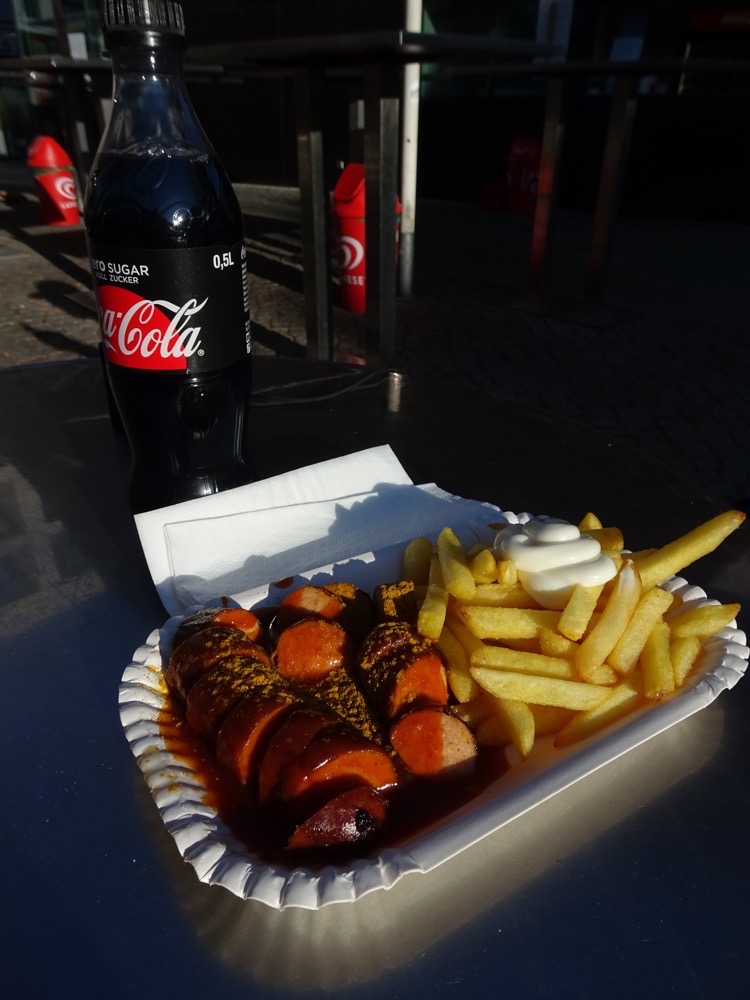 A little further down the street, I found a famous bakery called Bäckerei Möbius that has been here since 1908, so we stopped for aSchwarzer Tee and some schnecken before doing another quick turn around the city.
A little further down the street, I found a famous bakery called Bäckerei Möbius that has been here since 1908, so we stopped for aSchwarzer Tee and some schnecken before doing another quick turn around the city. Memorial marker for a place where a medieval church had been but had been destroyed by bombing in WWII.
Memorial marker for a place where a medieval church had been but had been destroyed by bombing in WWII. Der Cholerabrunnen – the Dresden Cholera Fountain – was constructed in the mid-1840s for Baron Eugen von Gutschmid as a celebration of the sparing of the city from a Cholera epidemic that ravaged the region in 1841/2.
Der Cholerabrunnen – the Dresden Cholera Fountain – was constructed in the mid-1840s for Baron Eugen von Gutschmid as a celebration of the sparing of the city from a Cholera epidemic that ravaged the region in 1841/2.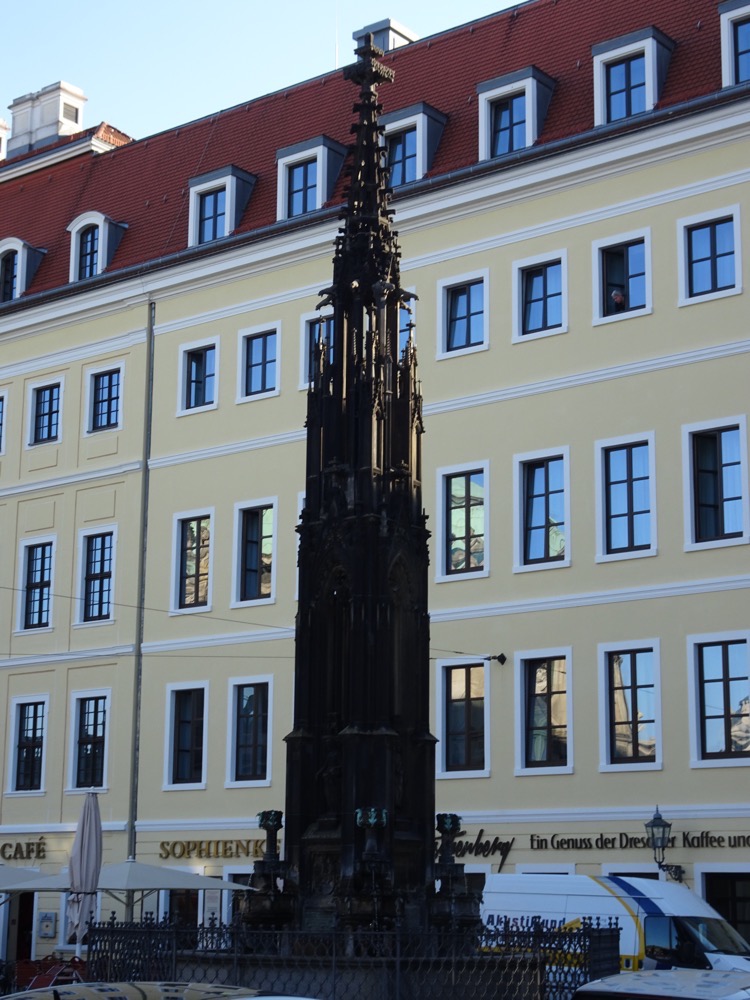 No idea why, but it is covered in lizards…
No idea why, but it is covered in lizards…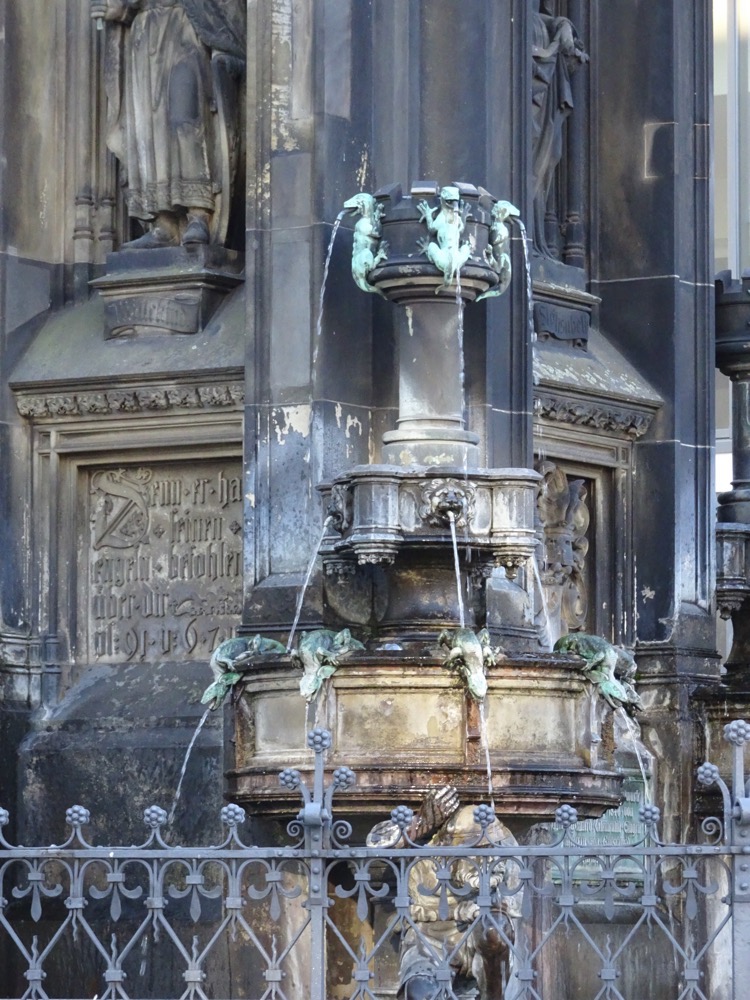 A nearby restaurant shows its ingenuity in getting around language barriers on menus.
A nearby restaurant shows its ingenuity in getting around language barriers on menus. Advertising for a high-end jeweller – let’s not muck around, let’s show them we can make elaborate Rennaisance/Baroque masterpieces! Bit much for everyday wear, I think.
Advertising for a high-end jeweller – let’s not muck around, let’s show them we can make elaborate Rennaisance/Baroque masterpieces! Bit much for everyday wear, I think.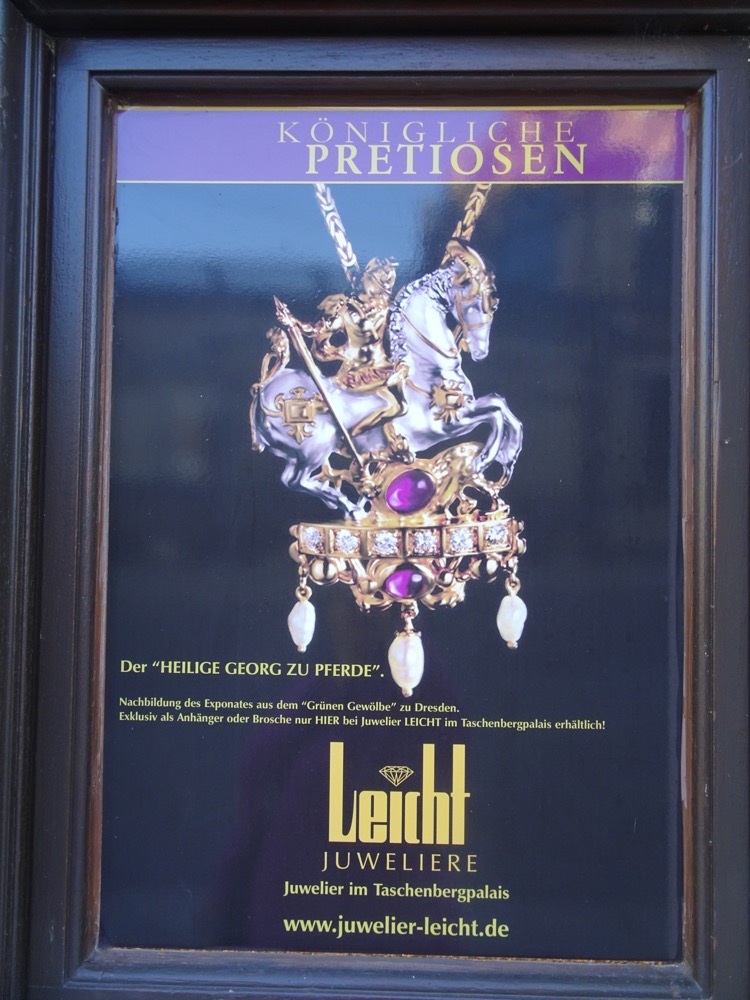

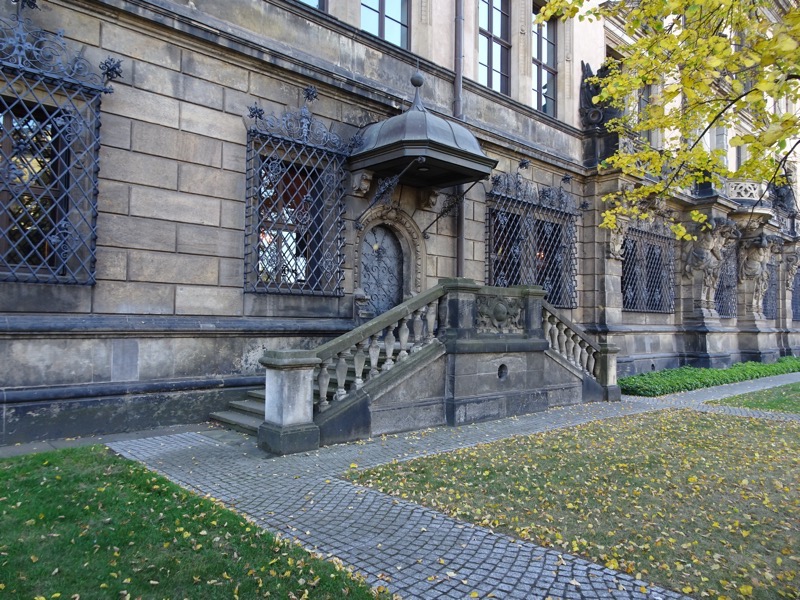 The Semperoper Dresden looking much more impressive in the morning light.
The Semperoper Dresden looking much more impressive in the morning light.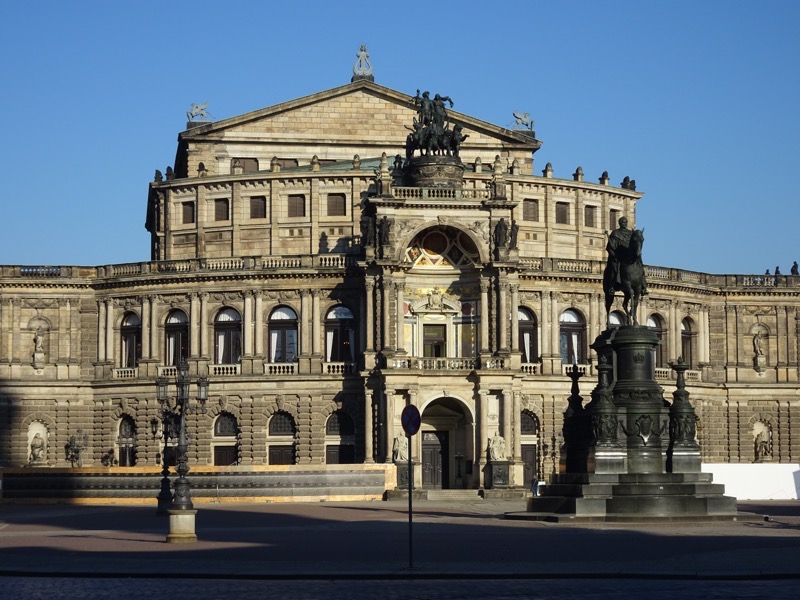
 The back of the Katholische Hofkirche… needs some serious restoration work done. I think many of Dresden’s buildings could do with a bit of time under scaffold being cleaned – they appear to be wearing most of the 19th/20thC grime that most other European countries have long since cleaned up.
The back of the Katholische Hofkirche… needs some serious restoration work done. I think many of Dresden’s buildings could do with a bit of time under scaffold being cleaned – they appear to be wearing most of the 19th/20thC grime that most other European countries have long since cleaned up.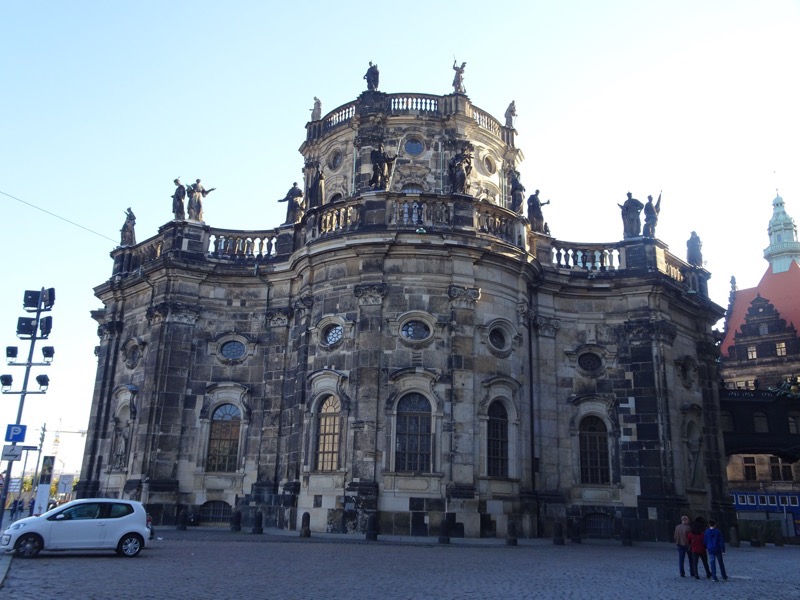
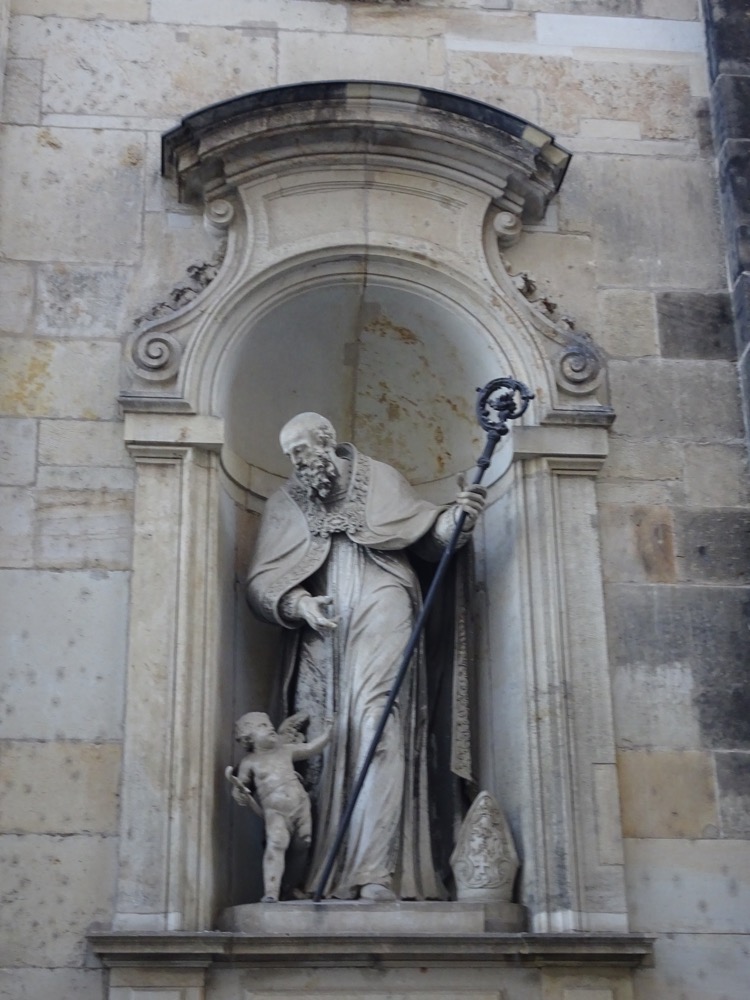

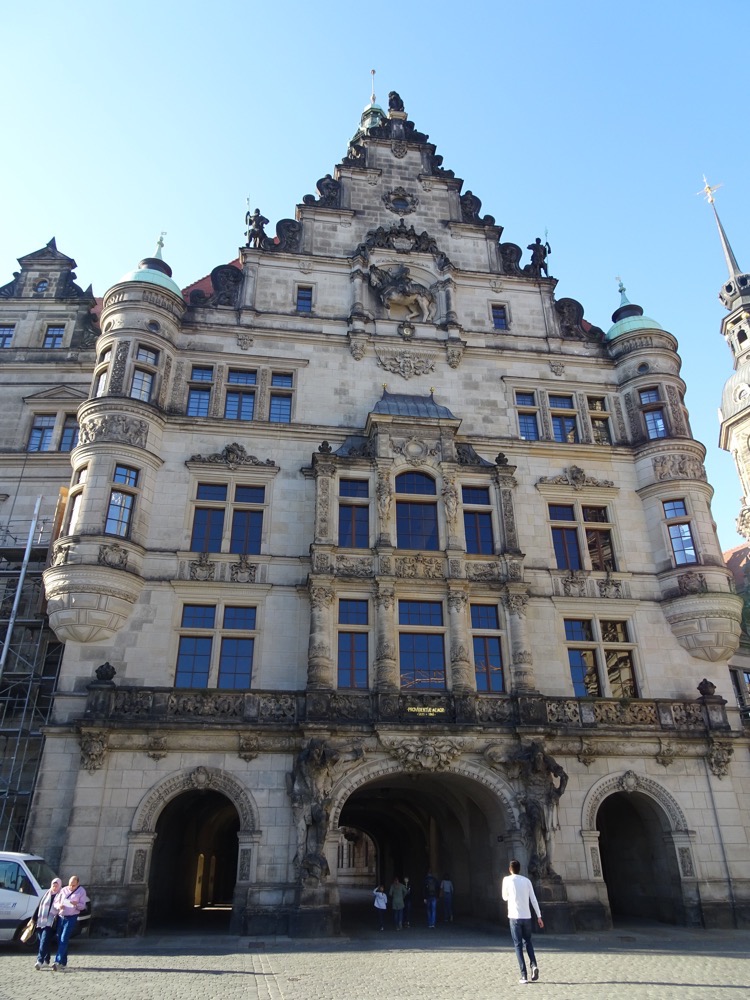

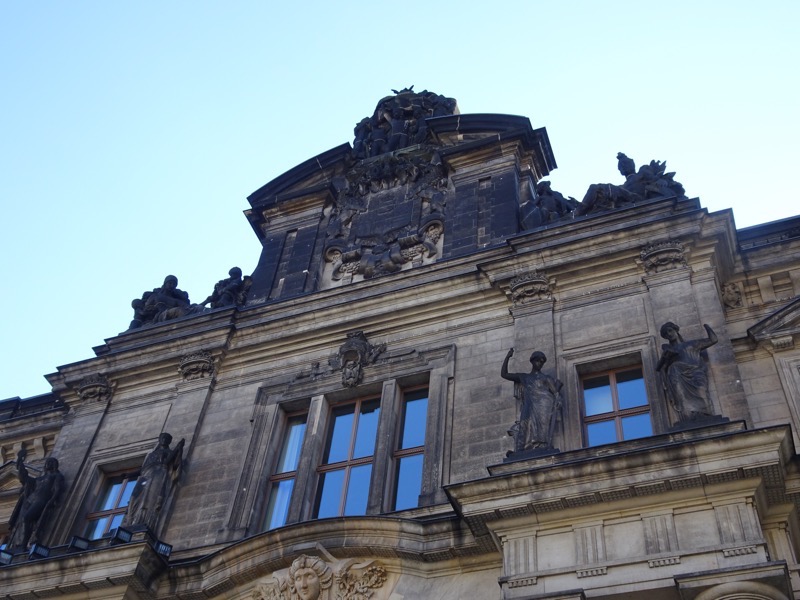
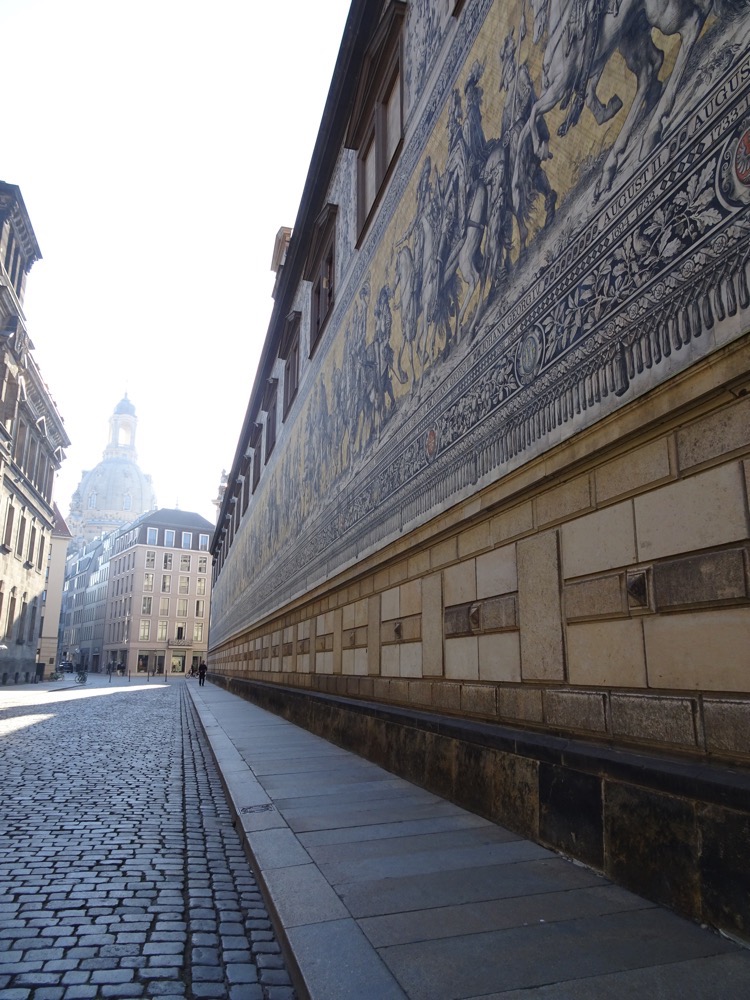 We also stumbled into some open stores – at least two of which were perennial Christmas stores! Exactly like the one we saw in Quebec in July – only with a clean, crisp, minimalist Nordic / Ikea feel to it.
We also stumbled into some open stores – at least two of which were perennial Christmas stores! Exactly like the one we saw in Quebec in July – only with a clean, crisp, minimalist Nordic / Ikea feel to it.
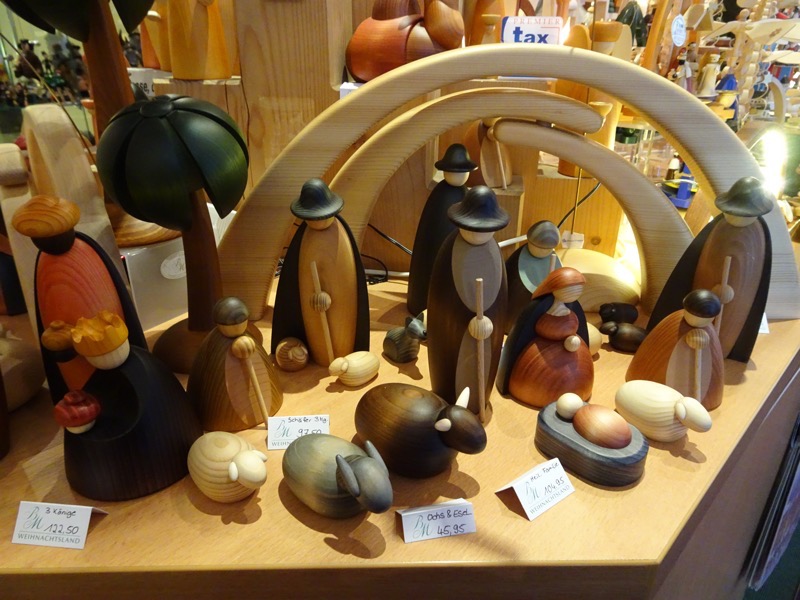
 Also doubled back around on the Frauenkirche, and it was open this morning so we were able to go in and enjoy the interiors.
Also doubled back around on the Frauenkirche, and it was open this morning so we were able to go in and enjoy the interiors.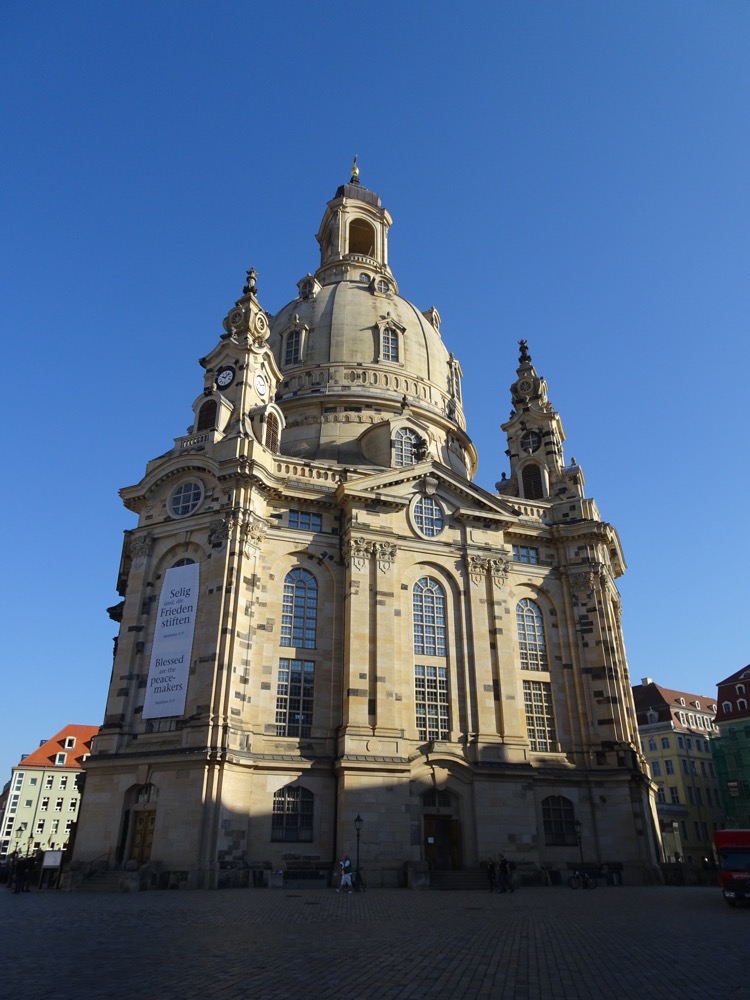
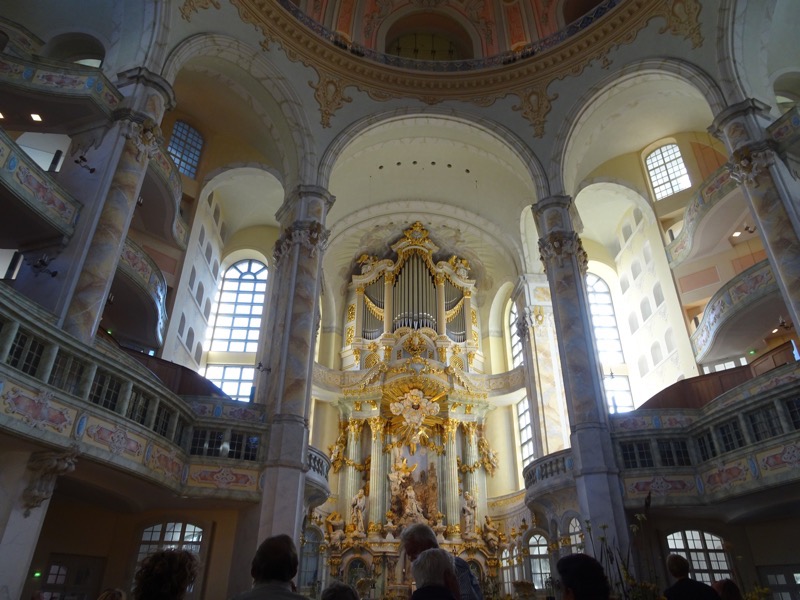
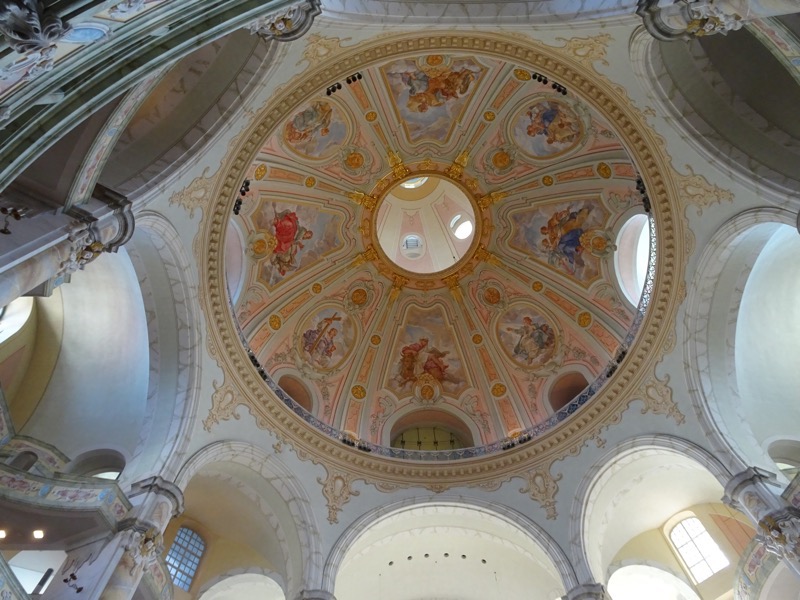 Saw the strangest ‘weird tourist’ moment in the church this morning when a woman put her €1 in the collection box to pay for a votive candle, and instead of lighting it and saying a prayer – she gave it to her kid who pocketed it. No idea where they were from, but I’m never seen someone ‘buy’ a votive candle to take home before.
Saw the strangest ‘weird tourist’ moment in the church this morning when a woman put her €1 in the collection box to pay for a votive candle, and instead of lighting it and saying a prayer – she gave it to her kid who pocketed it. No idea where they were from, but I’m never seen someone ‘buy’ a votive candle to take home before.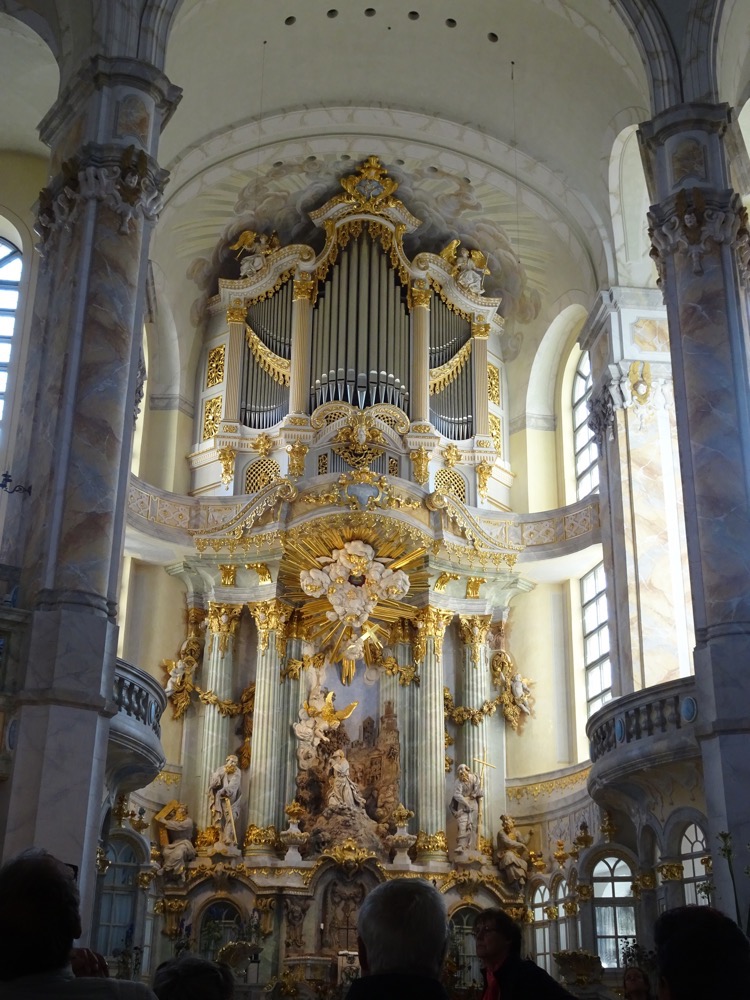 Neumarkt:
Neumarkt: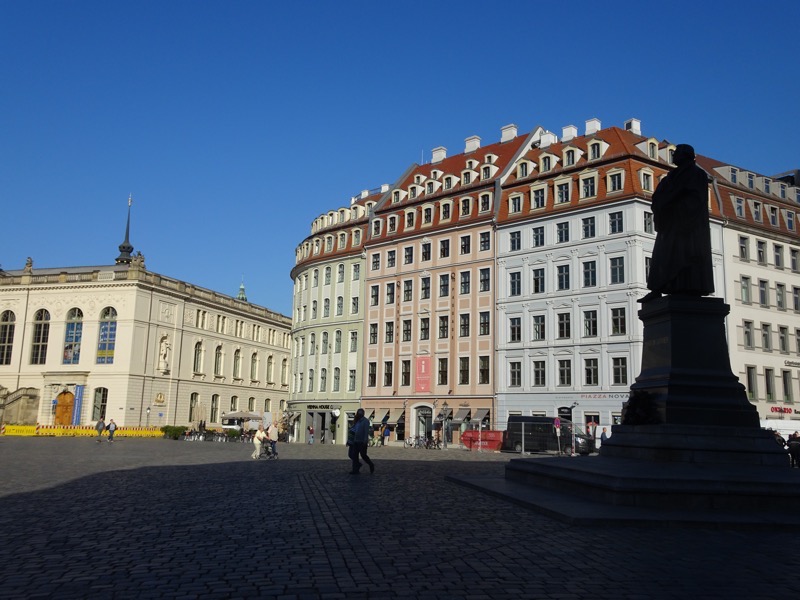 Our hotel. Lovely place, highly recommend it… and so cheap compared to Iceland!
Our hotel. Lovely place, highly recommend it… and so cheap compared to Iceland! 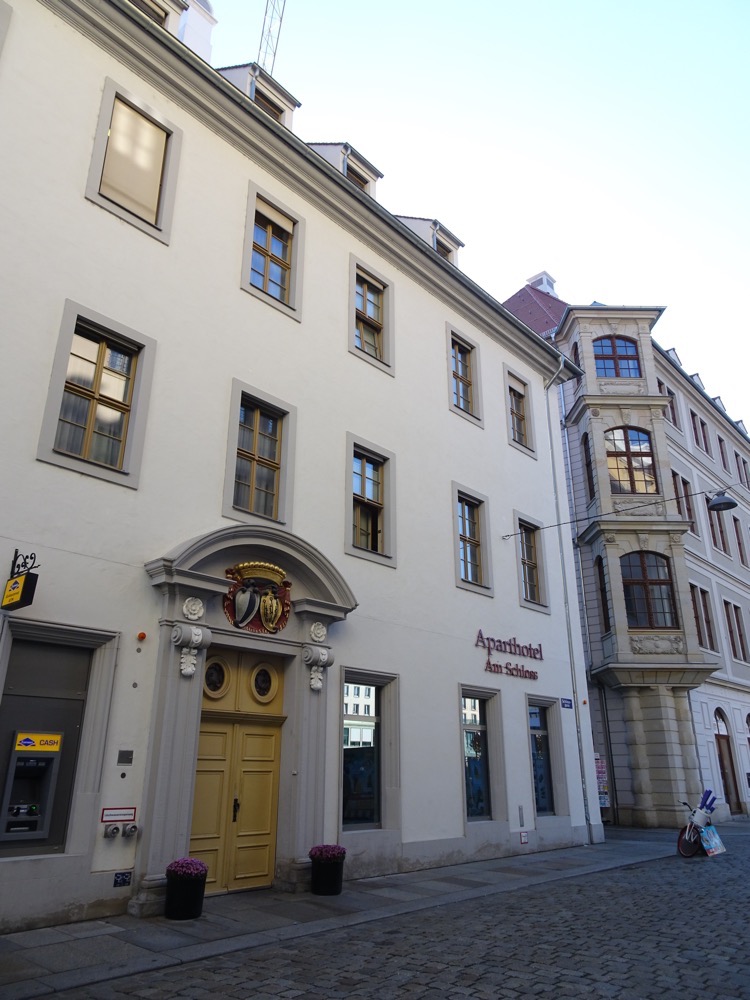
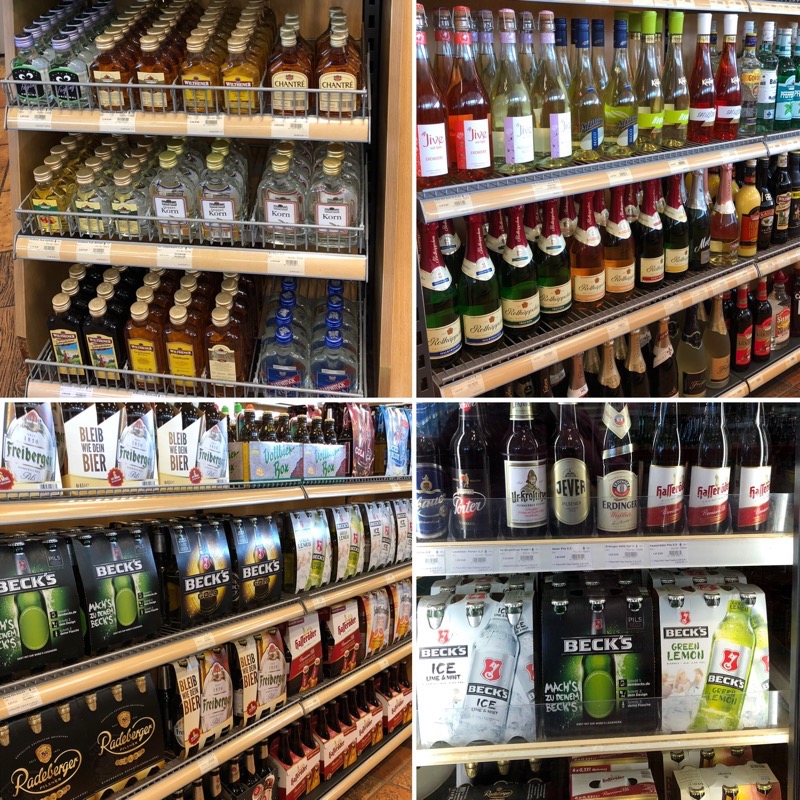
 On the way through – I saw this awesome luggage conveyor belt to help you get your luggage up long flights of stairs when there are limited or no lift facilities. Never seen anything so brilliant before in my life – Japan, New York, take notes: You need these!
On the way through – I saw this awesome luggage conveyor belt to help you get your luggage up long flights of stairs when there are limited or no lift facilities. Never seen anything so brilliant before in my life – Japan, New York, take notes: You need these!

 The train was clean and comfortable though, but unfortunately, the onboard wifi didn’t appear to be working – that or my enquiring of the (possibily Czech) train conduction ‘Sprechen zie English?’ was off-putting and she decided not to tell us how to hook onto it.
The train was clean and comfortable though, but unfortunately, the onboard wifi didn’t appear to be working – that or my enquiring of the (possibily Czech) train conduction ‘Sprechen zie English?’ was off-putting and she decided not to tell us how to hook onto it. 
 We arrived in Prague around 3:30pm, and then went searching for taxis. On our way, we ran into another Aussie couple (the Crumpler bags and the 4163 postcode on their luggage tag told us they were from Victoria Point – about 20 mins from where I live!), they too were looking for cabs. Directly exiting the station we found the cab rank – we needed to go all of 1.5km and they were going approximately 1.6km. Walkable – but not really when you are dragging suitcases over cobblestones. The cabbies were all charging flat rate of €15.00 or Kč500.00 to take you the 1.5kms to the city centre… which according to the online fare calculators, it should be somewhere around the Kč215.00 mark to do the trip. Fuck the taxi industry – no wonder they have such shit reputations. When I started working down the line looking for a cabbie who would agree to take us on the meter, they all refused and told me that there were taxis upstairs outside the bus station that do metered trips. Get up to that rank and find the same bullshit ‘private car/flat rate’, Kč400.00 to get to the city. Urgh. It’s been a long day so once I managed two vehicles for our newly met neighbours from home, we capitulated and overpaid to get to our hotel.
We arrived in Prague around 3:30pm, and then went searching for taxis. On our way, we ran into another Aussie couple (the Crumpler bags and the 4163 postcode on their luggage tag told us they were from Victoria Point – about 20 mins from where I live!), they too were looking for cabs. Directly exiting the station we found the cab rank – we needed to go all of 1.5km and they were going approximately 1.6km. Walkable – but not really when you are dragging suitcases over cobblestones. The cabbies were all charging flat rate of €15.00 or Kč500.00 to take you the 1.5kms to the city centre… which according to the online fare calculators, it should be somewhere around the Kč215.00 mark to do the trip. Fuck the taxi industry – no wonder they have such shit reputations. When I started working down the line looking for a cabbie who would agree to take us on the meter, they all refused and told me that there were taxis upstairs outside the bus station that do metered trips. Get up to that rank and find the same bullshit ‘private car/flat rate’, Kč400.00 to get to the city. Urgh. It’s been a long day so once I managed two vehicles for our newly met neighbours from home, we capitulated and overpaid to get to our hotel. And just like Fontana Trevi – the place was overrun with people waiting for the clock to chime the hour. The town square is packed, but I know it will be empty tomorrow morning and I will be able to get some quiet photos of the clock like it may have been hundreds of years ago.
And just like Fontana Trevi – the place was overrun with people waiting for the clock to chime the hour. The town square is packed, but I know it will be empty tomorrow morning and I will be able to get some quiet photos of the clock like it may have been hundreds of years ago.
 As it turns out the
As it turns out the  The menu was quite extensive, it was hard to choose what to have – it’s so nice to be back in the world of affordable food again!
The menu was quite extensive, it was hard to choose what to have – it’s so nice to be back in the world of affordable food again! Baked brie with cranberry sauce served with toast:
Baked brie with cranberry sauce served with toast: And we totally over orded for our mains (after Icelandic food being rather fancy and small plated):
And we totally over orded for our mains (after Icelandic food being rather fancy and small plated):  Roast duck in Blueberry Sauce:
Roast duck in Blueberry Sauce: Potatoes with cream, Niva blue cheese and a bit of garlic:
Potatoes with cream, Niva blue cheese and a bit of garlic: Beef goulash in a loaf of bread:
Beef goulash in a loaf of bread: Apple Strudel with whipped cream and Vanilla ice cream:
Apple Strudel with whipped cream and Vanilla ice cream: This is happy full yale – who ordered everything he wanted and yet the bill came in just under AUD$70 including 3 pints of cider and 15% included tip! Madness. If everything feels relative to Iceland, I think yale can afford to eat again after his two-week crash diet of cuppa noodles and wraps made in the back of the car for lunch!
This is happy full yale – who ordered everything he wanted and yet the bill came in just under AUD$70 including 3 pints of cider and 15% included tip! Madness. If everything feels relative to Iceland, I think yale can afford to eat again after his two-week crash diet of cuppa noodles and wraps made in the back of the car for lunch! With full tummies and a cider buzz, we talk a short turn around the Prague Old Town looking at all the touristy shit. The place sure has changed since I was here back in 1995… so many visitors, and flashing lights and massage parlours (
With full tummies and a cider buzz, we talk a short turn around the Prague Old Town looking at all the touristy shit. The place sure has changed since I was here back in 1995… so many visitors, and flashing lights and massage parlours ( 

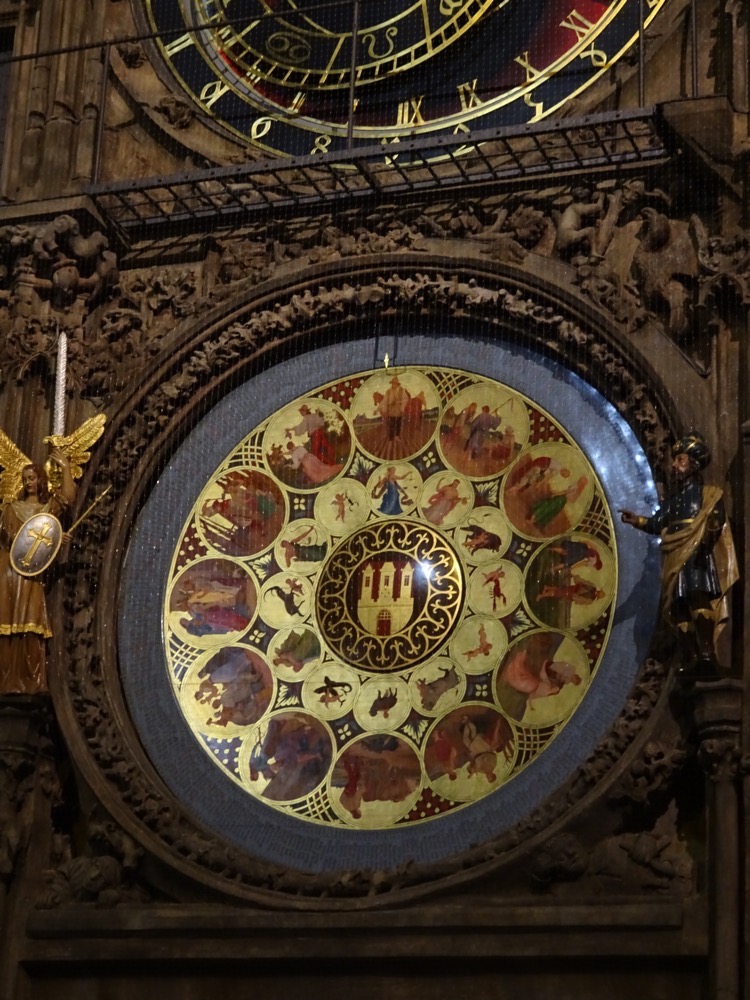
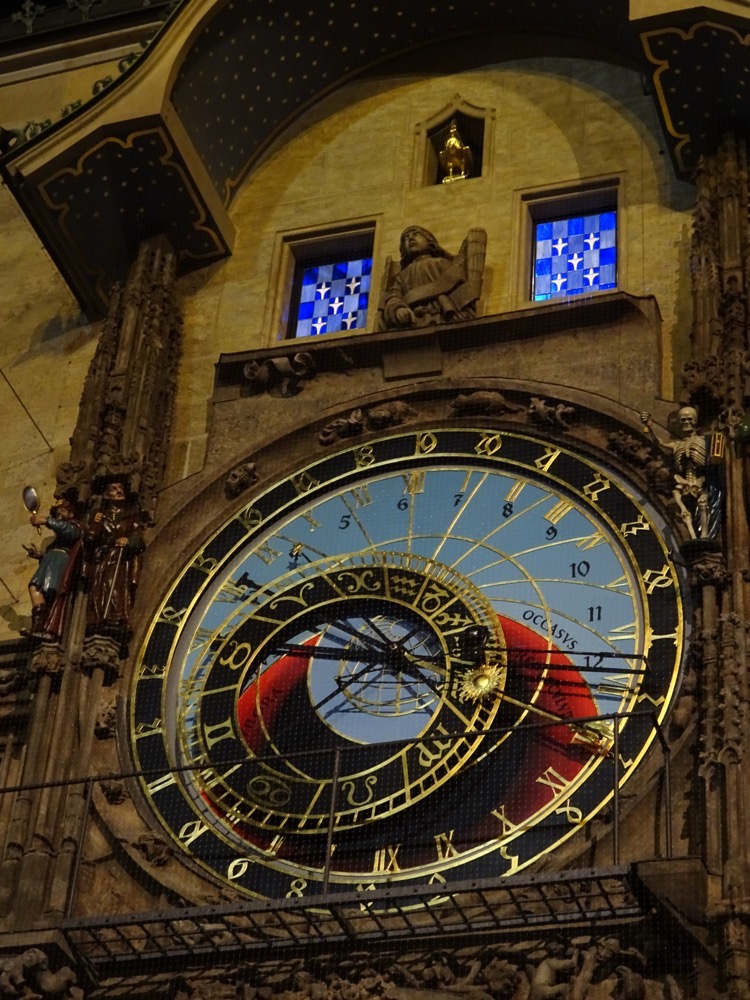
 We had an uneventful though not overly comfortable flight. Icelandair is a budget airline so it’s bend over with the sandy lube if you want a yoghurt or a sandwich mid-air, and the cabin was freezing cold, yet when I asked for a blanket – they had ‘run out’. So I got to shiver my way to Berlin. I put on a movie which I now can’t even remember the name of, (something about illegal money being dropping at bars, Tom Hardy, I don’t know – typical crap, lots of ‘entertaining’ violence), and proceeded to nod off throughout the film.
We had an uneventful though not overly comfortable flight. Icelandair is a budget airline so it’s bend over with the sandy lube if you want a yoghurt or a sandwich mid-air, and the cabin was freezing cold, yet when I asked for a blanket – they had ‘run out’. So I got to shiver my way to Berlin. I put on a movie which I now can’t even remember the name of, (something about illegal money being dropping at bars, Tom Hardy, I don’t know – typical crap, lots of ‘entertaining’ violence), and proceeded to nod off throughout the film. After only a minimal amount of stuffing around at TXL – Berlin Tegel Airport – we picked up a hire car and hit the road headed to Dresden. Enroute we found ourselves stopped in traffic for roadworks and were inching back and forth with no fewer than nine of these police vehicles – right up until they got sick of the delay and hit their flashy flashy lights and the ever obedient predominantly German drivers moved out of the way, parting the traffic like the Red Sea. Damn I wish we could have followed them! We were stuck for about another 20mins or so.
After only a minimal amount of stuffing around at TXL – Berlin Tegel Airport – we picked up a hire car and hit the road headed to Dresden. Enroute we found ourselves stopped in traffic for roadworks and were inching back and forth with no fewer than nine of these police vehicles – right up until they got sick of the delay and hit their flashy flashy lights and the ever obedient predominantly German drivers moved out of the way, parting the traffic like the Red Sea. Damn I wish we could have followed them! We were stuck for about another 20mins or so. Once we got out into the clear again, the Real German motoring experience kicked in and we found oursevles cruising along at 125kmph watching every man and his dog overtaking us like we were stationery!
Once we got out into the clear again, the Real German motoring experience kicked in and we found oursevles cruising along at 125kmph watching every man and his dog overtaking us like we were stationery! We made our way to the Aparthotel Am Schloss (Hotel at the Castle) and found ourselves in the most enormous studio apartment I have ever seen in an inner city European city. It was easily 20′ square, without the bathroom (that is bigger than our main bathroom at home!) and 16′ ceilings. Not only was it huge, but it was also about
We made our way to the Aparthotel Am Schloss (Hotel at the Castle) and found ourselves in the most enormous studio apartment I have ever seen in an inner city European city. It was easily 20′ square, without the bathroom (that is bigger than our main bathroom at home!) and 16′ ceilings. Not only was it huge, but it was also about  We quickly checked in and went for a wander around town before we lost the light.
We quickly checked in and went for a wander around town before we lost the light.

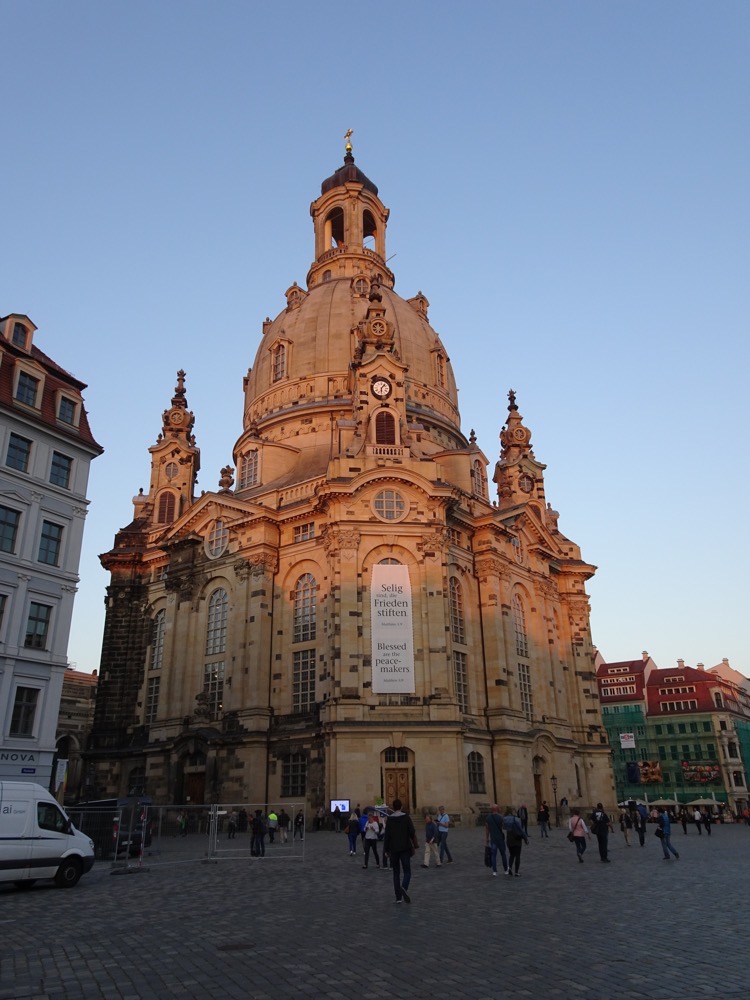 Statue dedicated to Martin Luther.
Statue dedicated to Martin Luther.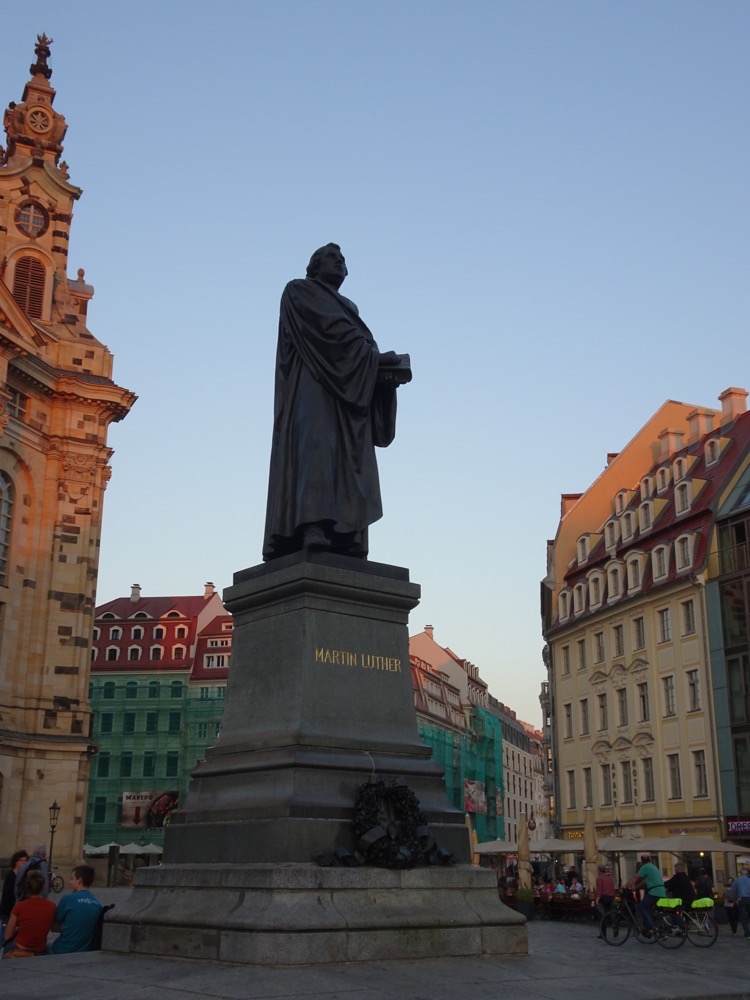 The Neumarkt square surrounding the Frauenkirche has many impressive baroque buildings that also underwent extensive reconstruction in 2004.
The Neumarkt square surrounding the Frauenkirche has many impressive baroque buildings that also underwent extensive reconstruction in 2004.
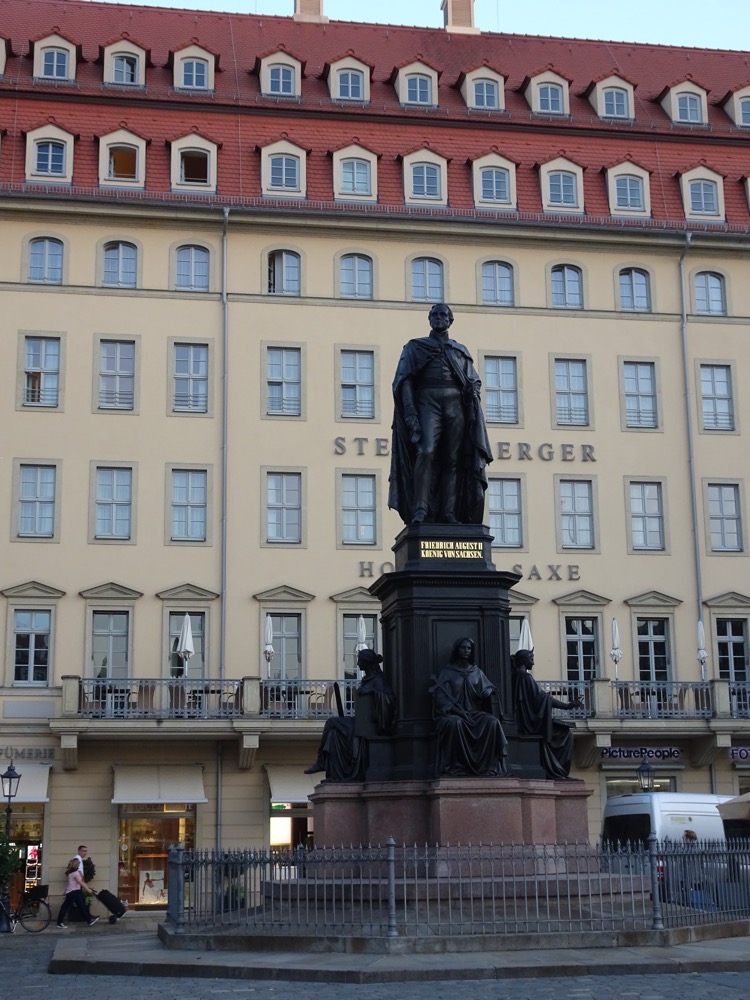
 Neumarkt with the afternoon sun falling on the Frauenkirche
Neumarkt with the afternoon sun falling on the Frauenkirche
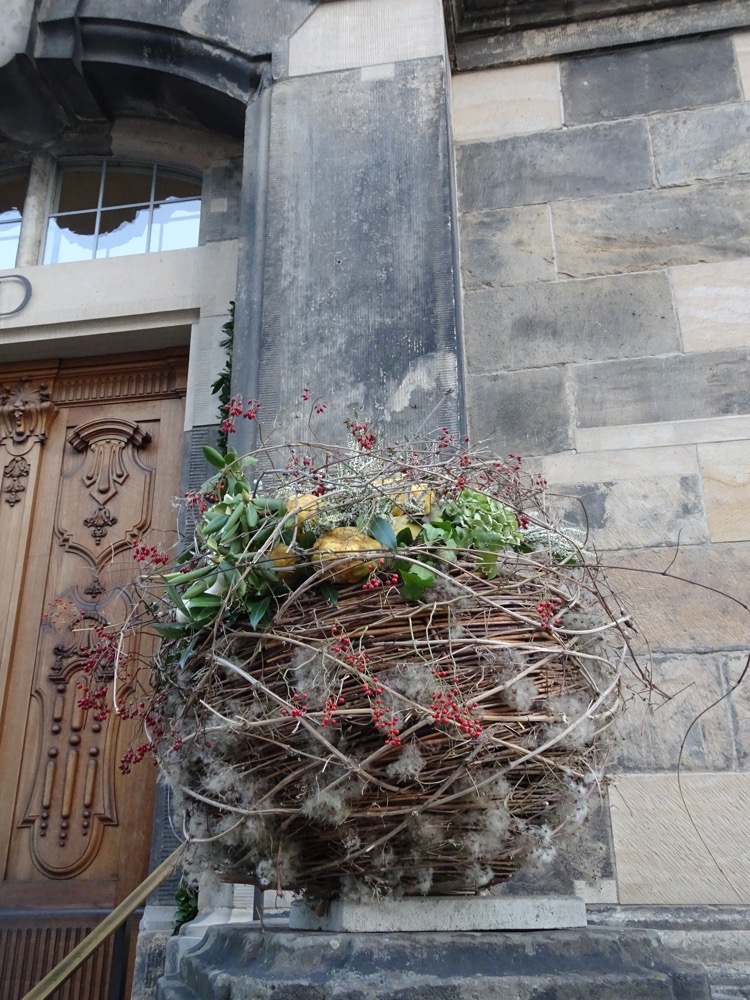
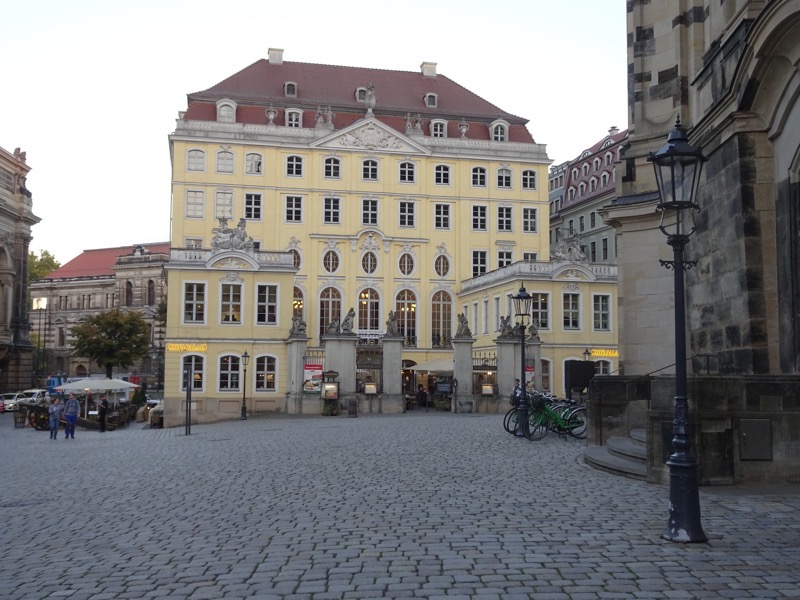
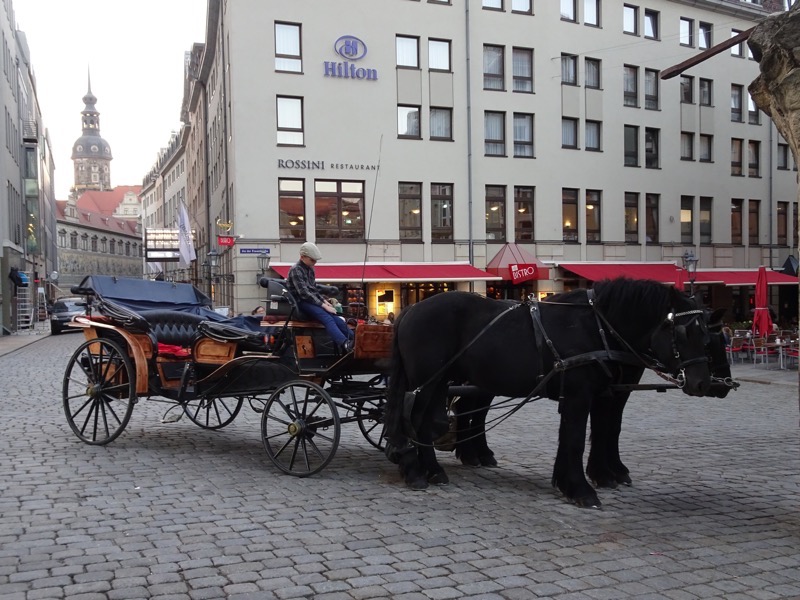



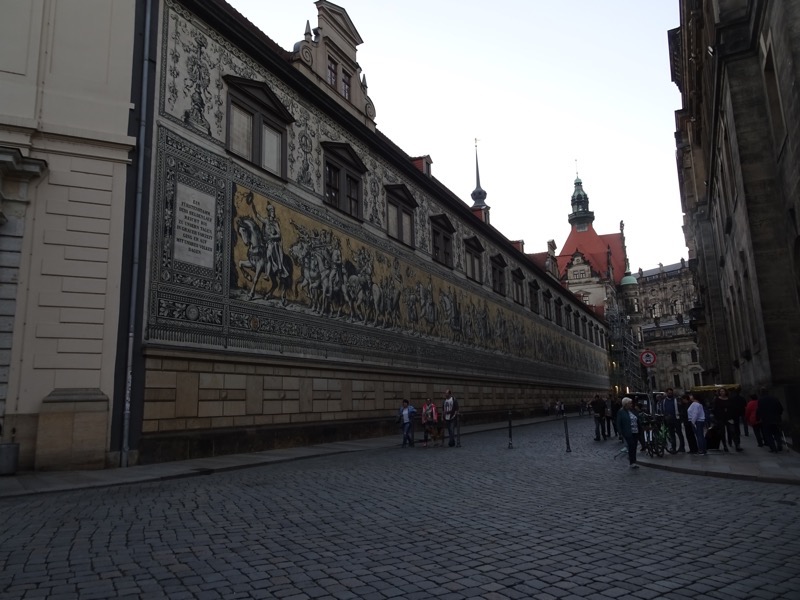 At 102m long, it is considered the largest known porcelain artwork in the world. The mural represents ancestral portraits of the 35 margraves, electors, Dukes and Kings of the House of Wettin between 1127 and 1904.
At 102m long, it is considered the largest known porcelain artwork in the world. The mural represents ancestral portraits of the 35 margraves, electors, Dukes and Kings of the House of Wettin between 1127 and 1904.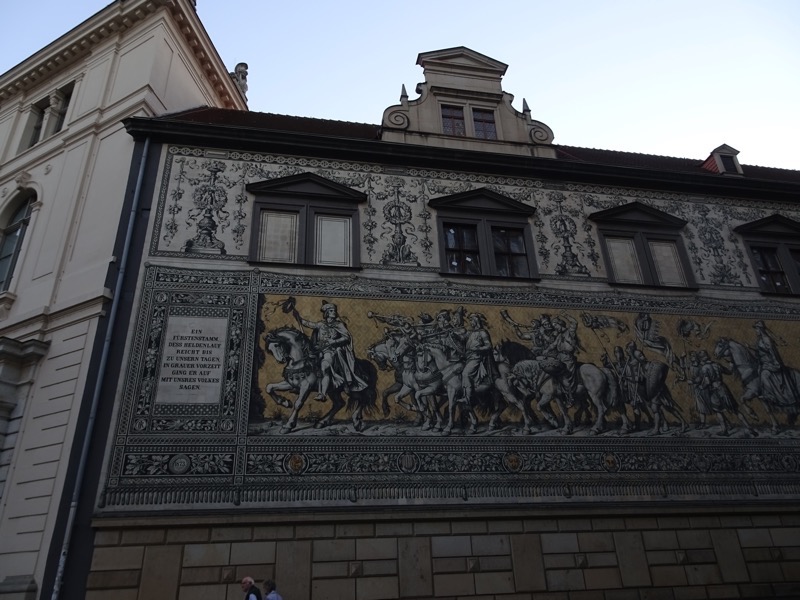
 Semperoper Dresden or the Dresden Opera House, which was originally built in 1841, but was rebuilt by the original architect after a fire destroyed it in 1869.
Semperoper Dresden or the Dresden Opera House, which was originally built in 1841, but was rebuilt by the original architect after a fire destroyed it in 1869. The Zwinger and the Gemäldegalerie Alte Meister, Museum of Fine Arts. Unfortunately closed this evening and we won’t have time to see it in the morning *sad face*. That is the real tragedy of transit days.
The Zwinger and the Gemäldegalerie Alte Meister, Museum of Fine Arts. Unfortunately closed this evening and we won’t have time to see it in the morning *sad face*. That is the real tragedy of transit days.

 I tried the Braised Ox Cheek served with Mashed Potatoes and Carrots – no bloody celeriac paste in sight! It was delicious, though not the sort of slow cooked falling apart texture you tend to expect from beef cheek.
I tried the Braised Ox Cheek served with Mashed Potatoes and Carrots – no bloody celeriac paste in sight! It was delicious, though not the sort of slow cooked falling apart texture you tend to expect from beef cheek. yale ordered the Shankhaus Pan – roast pork, smoked pork, roasted blood sausage, barbeque sausage with bacon and pickled cabbage and fried potatoes. I’ve never seen him defeated by a meal before, but I guess after a bowl of Lentil Stew and having nearly all the crunchy rye bread with crackling fat, it was bound to happen!
yale ordered the Shankhaus Pan – roast pork, smoked pork, roasted blood sausage, barbeque sausage with bacon and pickled cabbage and fried potatoes. I’ve never seen him defeated by a meal before, but I guess after a bowl of Lentil Stew and having nearly all the crunchy rye bread with crackling fat, it was bound to happen!
